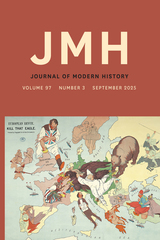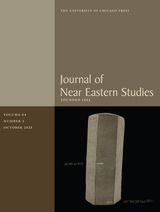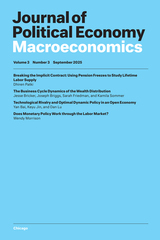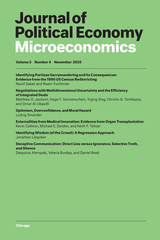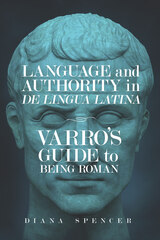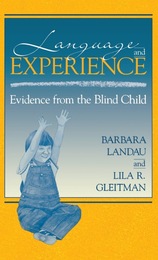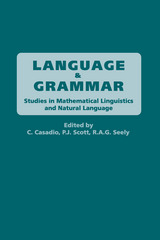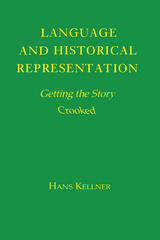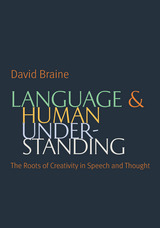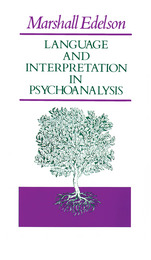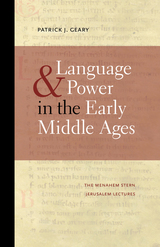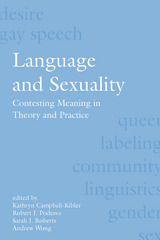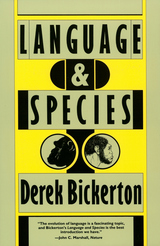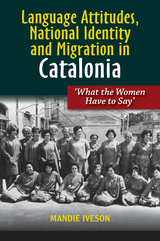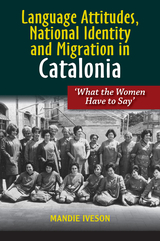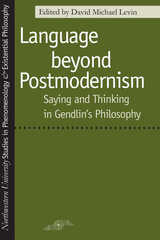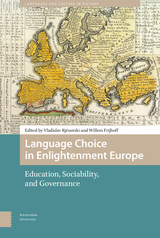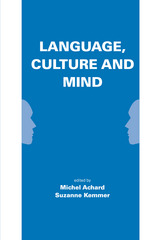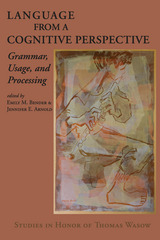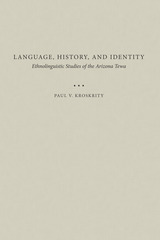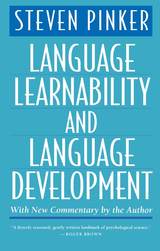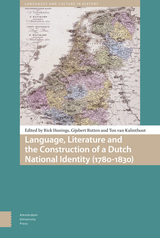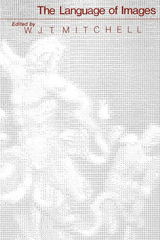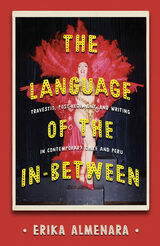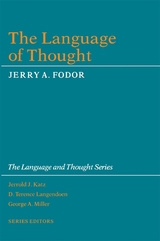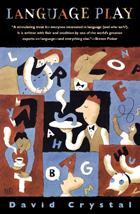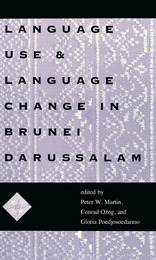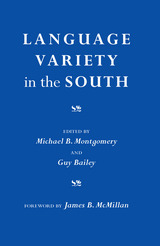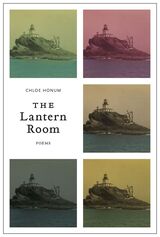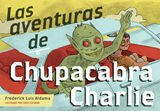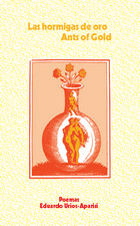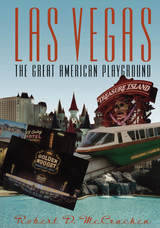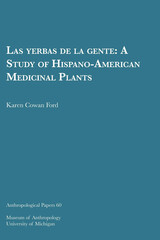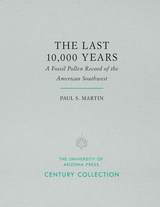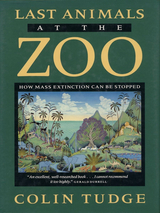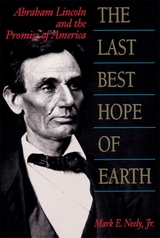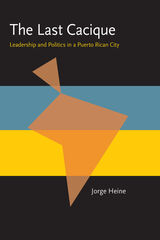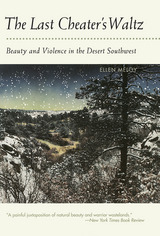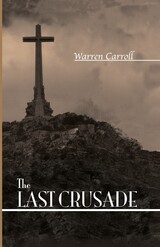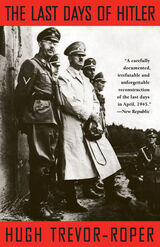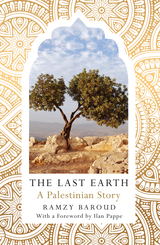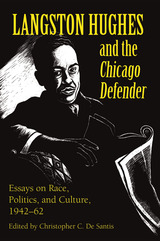 Langston Hughes and the *Chicago Defender*: Essays on Race, Politics, and Culture, 1942-62
Langston Hughes. Edited by Christopher C. De Santis
University of Illinois Press, 1995 Langston Hughes is well known as a poet, playwright, novelist, social activist, communist sympathizer, and brilliant member of the Harlem Renaissance. He has been referred to as the "Dean of Black Letters" and the "poet low-rate of Harlem." But it was as a columnist for the famous African-American newspaper the Chicago Defender that Hughes chronicled the hopes and despair of his people. For twenty years, he wrote forcefully about international race relations, Jim Crow, the South, white supremacy, imperialism and fascism, segregation in the armed forces, the Soviet Union and communism, and African-American art and culture. None of the racial hypocrisies of American life escaped his searing, ironic prose. This is the first collection of Hughes's nonfiction journalistic writings. For readers new to Hughes, it is an excellent introduction; for those familiar with him, it gives new insights into his poems and fiction.
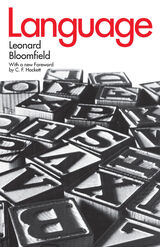 Language
Leonard Bloomfield
University of Chicago Press, 1984 Perhaps the single most influential work of general linguistics published in the twentieth century, Leonard Bloomfield’s Language is both a masterpiece of textbook writing and a classic of scholarship. Intended as an introduction to the field of linguistics, it revolutionized the field when it appeared in 1933 and became the major text of the American descriptivist school.
The book quickly became the primary text for the American descriptivist school of linguistics. Bloomfield’s clear, systematic methodology and focus on observable language data laid the groundwork for a new era in linguistic theory. His work, which covers a wide range of topics, from phonology and morphology to syntax and semantics, provides a comprehensive framework for understanding how language functions as a structured system.
Through twelve detailed chapters, Bloomfield explores topics such as the sounds of language, the structure of words, and the organization of sentences. His emphasis on structuralism and the empirical study of language has had a profound impact on the discipline, making Language an essential reference for anyone interested in the history and development of linguistic theory.
As both an introduction for newcomers and a resource for more advanced students, Language continues to be a crucial text in understanding the scientific study of language and its ongoing evolution.
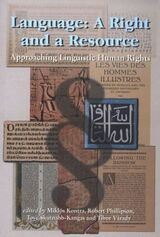 Language: A Right and a Resource: Approaches to Linguistic Human Rights
Tibor Várady
Central European University Press, 2000 Linguistic Human Rights (LHR) is a fast growing new area of study combining the principles of national and international law with the study of language as a central dimension of ethnicity. Implementation of these principles is aimed at ensuring that no state or society violates these basic rights. This path breaking study broadens our knowledge of the important role of language in minority rights and in social and political struggles for LHRs. Exploring the interactions of linguistic diversity, biodiversity, the free market and human rights, the contributors present case studies to highlight such issues as Kurdish satellite TV attempting to create a virtual state on the air through trying to achieve basic LHR’s for Kurds in Turkey; the implementation of LHRs in the Baltic states; language rights activism in Canada; the spread of English as an international language; and the obstacles met in education by Roma and the Deaf in Hungary because of lack of appropriate LHRs. Language: A Right and a Resource is a valuable multi-disciplinary text which can be used in a variety of different areas of study in the legal profession, linguistics, cultural and political studies.
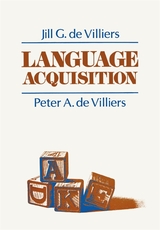 Language Acquisition
Jill G. de Villiers and Peter A. de Villiers
Harvard University Press, 1978 The study of language acquisition has become a center of scientific inquiry into the nature of the human mind. The result is a windfall of new information about language, about learning, and about children themselves.
In Language Acquisition Jill and Peter de Villiers provide a lively introduction to this fast-growing field. Their book deals centrally with the way the child acquires the sounds, meanings, and syntax of his language, and the way he learns to use his language to communicate with others. In discussing these issues, the de Villiers provide a clear and insightful treatment of the classic questions about language acquisition: Does the child show a genetic predisposition for speech, or grammar, or semantics which makes him uniquely able to learn human language? What kinds of learning are involved in acquiring language and what kinds of experience with a language are necessary to support such learning? Is there a critical period during the child's development which is optimal for language acquisition? And what kind of psychological disabilities underlie the failure to acquire language?
 Language Acquisition after Puberty
Judith R. Strozer
Georgetown University Press, 1994 Bridging the gap between theoretical linguistics and language teaching, Judith R. Strozer explores what recent theoretical advances suggest about learning a language after childhood and the implications for the design and execution of a foreign language program.
Strozer outlines clearly, in nontechnical language, the major concepts of modern language theory, from Chomsky's theory of language through the most recent discoveries about the abstract foundations of language. She explains ideas about the evolution of a cognitive structure for language in the human brain, a "language faculty" or Universal Grammar that gives humans alone the creative ability to generate the infinite expressions of language. This innate universal schema for language endows humankind with a number a very broad principles applicable to all languages. Turning to current advances in the theory of phrase structure, which has replaced our 2,000-year-old rules of grammar with highly abstract universal principles of language structure, she relates the latest discoveries about the foundations of language to ideas about how children learn languages. A child hearing a specific language can automatically set the parameters for the rules governing that particular language, much like setting a binary switch. But our ability to access this innate language mechanism automatically seems limited to childhood, until physical maturity somehow changes this brain function. Arguing that adults need to learn consciously the systems and structures of another language that children acquire unconsciously, Strozer applies these latest theories about the nature of language and how we learn it to the design of foreign language programs for adults. She concludes with recommendations for developing a new kind of teaching program that would draw on comparative language research and include new pedagogic approaches. Presenting state-of-the-art language theory in easily readable terms and illustrative examples, this book will be of interest to everyone interested in the latest understanding of the relationship between the brain and language, as well as to all professionals in linguistics and language education.
 Language and Art in the Navajo Universe
Gary Witherspoon
University of Michigan Press, 1977 This is a complex and theoretical study on the roles of language and art in Navajo culture, resulting from nearly a decade of research on the Navajo reservation. The structures of Navajo thought, language, speech, and knowledge are used to frame discussions on a number of topics. Primary among these from a cosmological perspective are the concepts of inner and outer forms in the duality on nature coupled with static and dynamic concepts of motion. Also explored is the importance of language in ritual control and perceptions of action, causality, and plurality. Two terms essential to the Navajo ethos are semantically explored as organizing principles. The first is the concept of k'T which finds its primary expression in the patterning of kin relationships and solidarity. The second is h=zh=, which is most easily glossed as representing Navajo ideals of harmony and order. Art examples, represented by music, sand painting, and weaving, are used to demonstrate how these complex semantic and cosmological considerations find their way into Navajo daily ritual life. Information is also included on color classification, numerology, mythology, ethnophysocology, and taxonomies. The conclusions expand the data into summary statements of Navajo ethos.
Language and Authority in De Lingua Latina: Varro's Guide to Being Roman
Diana Spencer
University of Wisconsin Press, 2022 Diana Spencer, known for her scholarly focus on how ancient Romans conceptualized themselves as a people and how they responded to and helped shape the world they lived in, brings her expertise to an examination of the Roman scholar Varro and his treatise De Lingua Latina. This commentary on the origin and relationships of Latin words is an intriguing, but often puzzling, fragmentary work for classicists. Since Varro was engaged in defining how Romans saw themselves and how they talked about their world, Spencer reads along with Varro, following his themes and arcs, his poetic sparks, his political and cultural seams. Few scholars have accepted the challenge of tackling Varro and his work, and in this pioneering volume, Spencer provides a roadmap for considering these topics more thoroughly.
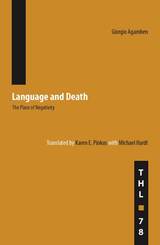 Language and Death: The Place of Negativity
Giorgio Agamben
University of Minnesota Press, 2006 A formidable and influential work, Language and Death sheds a highly original light on issues central to Continental philosophy, literary theory, deconstruction, hermeneutics, and speech-act theory. Focusing especially on the incompatible philosophical systems of Hegel and Heidegger within the space of negativity, Giorgio Agamben offers a rigorous reading of numerous philosophical and poetic works to examine how these issues have been traditionally explored. Agamben argues that the human being is not just “speaking” and “mortal” but irreducibly “social” and “ethical.”Giorgio Agamben teaches philosophy at the Collège International de Philosophie in Paris and at the University of Macerata in Italy. He is the author of Means without End (2000), Stanzas (1993), and The Coming Community (1993), all published by the University of Minnesota Press. Karen E. Pinkus is professor of French and Italian at the University of Southern California. Michael Hardt is professor of literature and romance studies at Duke University.
 Language and Ethnicity among the K'ichee' Maya
Sergio Romero
University of Utah Press, 2015 This book explores the articulation between “accent” and ethnic identification in K’ichee’, a Mayan language spoken by more than one million people in the western highlands of Guatemala. Based on years of ethnographic work, it is the first anthropological examination of the social meaning of dialectal difference in any Mayan language. Romero deconstructs essentialist perspectives on ethnicity in Mesoamerica and argues that ethnic identification among the highland Maya is multiple and layered, the result of a diverse linguistic precipitate created by centuries of colonial resistance. In K’ichee’, dialect stereotypes—accents—act as linguistic markers embodying particular ethnic registers. K’ichee’ speakers use and recombine their linguistic repertoire—colloquial K’ichee’, traditional K’ichee’ discourse, colloquial Spanish, Standard Spanish, and language mixing—in strategic ways to mark status and authority and to revitalize their traditional culture. The book surveys literary genres such as lyric poetry, political graffiti, and radio broadcasts, which express new experiences of Mayan-ness and anticolonial resistance. It also takes a historical perspective in examining oral and written K’ichee’ discourses from the sixteenth to the twenty-first centuries, including the famous chronicle known as the Popol Vuh, and explores the unbreakable link between language, history, and culture in the Maya highlands.
Language and Experience: Evidence from the Blind Child
Barbara Landau and Lila R. Gleitman
Harvard University Press, 1985 If learning depends upon sensory experience, then how do children with sensory handicaps manage to learn? In Language and Experience Barbara Landau and Lila Gleitman confront this problem head on as they attempt to describe and explain the remarkable ability of blind children to learn language without essential difficulty.
Language and Grammar: Studies in Mathematical Linguistics and Natural Language
Edited by Claudia Casadio, Philip Scott, and Robert Seely
CSLI, 2004 The application of logic to grammar is a fundamental issue in philosophy and has been investigated by such renowned philosophers as Leibniz, Bolzano, Frege, and Husserl. Language and Grammar examines categorial grammars and type-logical grammars, two linguistic theories that play a significant role in this area of study yet have been overshadowed until recently. The prominent scholars contributing to this volume also explore the impact of the Lambek program on linguistics and logical grammar, producing, ultimately, an exciting and important resource that demonstrates how type-logical grammars are promising future models of reasoning and computation.
 Language and Hegemony in Gramsci
Peter Ives
Pluto Press, 2004 Language and Hegemony in Gramsci introduces Gramsci’s social and political thought through his writings on language. It shows how his focus on language illuminates his central ideas such as hegemony, organic and traditional intellectuals, passive revolution, civil society and subalternity. Peter Ives explores Gramsci’s concern with language from his university studies in linguistics to his last prison notebook. Hegemony has been seen as Gramsci’s most important contribution, but without knowledge of its linguistic roots, it is often misunderstood.
This book places Gramsci’s ideas within the linguistically influenced social theory of the twentieth century. It summarizes some of the major ideas of Ferdinand de Saussure, Ludwig Wittgenstein, language philosophy and post-structuralism in relation to Gramsci’s position. By paying great attention to the linguistic underpinnings of Gramsci's Marxism, Language and Hegemony in Gramsci shows how his theorization of power, language and politics address issues raised by post-modernism and the work of Michel Foucault, Jacques Derrida, Chantal Mouffe, and Ernesto Laclau.
Language and Historical Representation: Getting the Story Crooked
Hans Kellner
University of Wisconsin Press, 1989 “This may well be the most important contribution to the linguistically informed study of historiography since Hayden White’s Metahistory. Looking at historical texts, Kellner is able to show us that they are more complex, and bear a more complicated relationship to reality, than we think. His scholarship is not only sound but is on the cutting edge or recent reflection on historiography. . . . The insights, not rarely, are stunning.”—Allan Megill, University of Iowa
Language and Human Understanding
David Braine
Catholic University of America Press, 2014 Philosopher, psychologist and linguist are all concerned with natural language. Accordingly, in seeking a unified view, Braine draws on insights from all these fields, sifting through the discordant schools of linguists. He concludes that one extended logic or integrated semantic syntax shapes grammar, but without constricting languages to being of one grammatical type.
Language and Interpretation in Psychoanalysis
Marshall Edelson
University of Chicago Press, 1984 Consider a poem as the literary critic reads it; consider the language of an analysand as the psychoanalyst hears it. The tasks of the professionals are similar: to interpret the linguistic, symbolic data at hand. In Language and Interpretation in Psychoanalysis, Marshall Edelson explores the linguistics of Chomsky, showing the congruence between Chomsky and Freud, and comparing linguistic interpretations in the psychoanalytic situation with interpretations of a Bach prelude and Wallace Stevens's poem "The Snow Man."
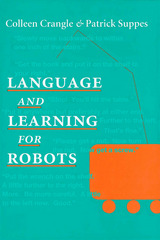 Language and Learning for Robots
Colleen Crangle and Patrick Suppes
CSLI, 1994 Robot technology will find wide-scale use only when a robotic device can be given commands and taught new tasks in a natural language. How could a robot understand instructions expressed in English? How could a robot learn from instructions? Crangle and Suppes begin to answer these questions through a theoretical approach to language and learning for robots and by experimental work with robots.
The authors develop the notion of an instructable robot—one which derives its intelligence in part from interaction with humans. Since verbal interaction with a robot requires a natural language semantics, the authors propose a natural-model semantics which they then apply to the interpretation of robot commands. Two experimental projects are described which provide natural-language interfaces to robotic aids for the physically disabled. The authors discuss the specific challenges posed by the interpretation of "stop" commands and the interpretation of spatial prepositions.
The authors also examine the use of explicit verbal instruction to teach a robot new procedures, propose ways a robot can learn from corrective commands containing qualitative spatial expressions, and discuss the machine-learning of a natural language use to instruct a robot in the performance of simple physical tasks. Two chapters focus on probabilistic techniques in learning.
 Language and Perception
George A. Miller and Philip N. Johnson-Laird
Harvard University Press Language and Perception lays foundations for a new branch of the psychological sciences—psycholexicology, the psychological study of the meaning of words. Although the basic argument is psychological, George Miller and Philip Johnson-Laird also draw on current work in artificial intelligence, linguistics, philosophy, and social anthropology. Their closely argued and lucid treatise will stimulate specialists in many fields to questions their assumptions and broaden their thinking about semantic problems.
Miller and Johnson-Laird explore an approach to word meaning that is procedural in orientation. The meaning of a word is construed as a set of mental procedures necessary to employ the word appropriately and respond sensibly to its use by others. Since the appropriate use of many words depends on a perceptual assessment of the situation to which the word applies, the authors begin by considering human perception in terms of the perceptual tests that it can apply to the environment.
As the argument advances, however, Miller and Johnson-Laird observe that the meaning of many words depends on functional as well as perceptual attributes and on the place that the word occupies within a system of conceptual relations between words. Ultimately, Miller and Johnson-Laird contend that perception and language are related only indirectly as alternative routes into a vastly complex conceptual world. Something of the shape of that world is inferred from the basic concepts that are important enough to be incorporated into the meanings of English words.
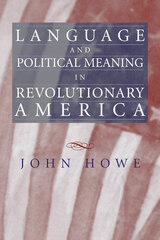 Language and Political Meaning in Revolutionary America
John Howe
University of Massachusetts Press, 2009 Between the Declaration of Independence and the federal constitution, the American revolutionary generation produced an enormous body of writing on political matters. Using the written word as an instrument of political action, they articulated ideologies, negotiated conflicts, and charted the future of a new nation. In the process, John Howe argues, American writers effected a fundamental transformation in the nature and expressive purposes of political language. Turning away from earlier assumptions about the capacity of language to capture universal truths and contain human behavior, they fashioned a new discursive practice based on the recognition that the language of politics, far from being fixed or even stable in structure and meaning, evolves over time. Securely in place by 1790 and clearly evident in the Federalist papers, this new language of political experimentation was well suited to the rapidly changing, open ended circumstances of American life. More than that, it proved essential to the emergence of a democratic politics. As Howe shows, only when language came to be used for the continuing exploration of political truth, only when it served to further popular discussion of contested ideas, could the construction of a genuinely democratic dialogue proceed. By challenging the notion that the founders of the republic were fully confident about the clarity or permanence of their language, this book also has implications for the ongoing debate over the doctrine of "original intent." According to Howe, the framers understood the constitution to be the product of a hurried and contentious process, reflective of the limitations of human intellect and the imperfections of human language. They saw it, in short, as but an approximation of universal truth, an approximation that future generations were certain to improve.
Language and Power in the Early Middle Ages
Patrick J. Geary
Brandeis University Press, 2013 The eminent historian Patrick J. Geary has written a provocative book, based on lectures delivered at the Historical Society of Israel about the role of language and ideology in the study and history of the early Middle Ages. He includes a fascinating discussion of the rush by nationalist philologists to rediscover the medieval roots of their respective vernaculars, the rivalry between vernacular languages and Latin to act as transmitters of Christian sacred texts and administrative documents, and the rather sloppy and ad hoc emergence in different places of the vernacular as the local administrative idiom. This is a fascinating look at the weakness of language as a force for unity: ideology, church authority, and emerging secular power always trumped language.
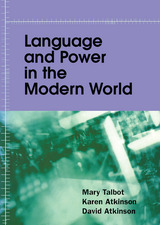 Language and Power in the Modern World
Mary Talbot
University of Alabama Press, 2003 An accessible overview of five major issues in sociolinguistics and the relationship between language and power
This book analyzes the key ways in which language constitutes and conveys power and social relationships in modern society. It offers selected readings that illustrate the thematic introductions and a set of tasks designed to guide linguistic analysis of data and to stimulate student discussion, in five specific areas: • Multilingualism, Identity, and Ethnicity: examines the phenomena of linguistic diversity from the perspective of language planning and language policies, with emphasis on personal, psychological, educational, cultural, and political issues. • Language and Youth: examines the languages of old age and the language of youth subcultures. • Language and Gender: explores the claim that men and women use interactional communication styles based on power and solidarity, respectively. • Language and the Media: considers the extent to which verbal interaction through mass media differs from other kinds of communication and its consequences in terms of power relations. • Language and Organizations: explores the use of language as a tool of power in public institutions and bureaucracies and how control over individuals is articulated through a range of different discourse structures and strategies. With a unique combination of selected readings and student-centered tasks in a single volume, Language and Power in the Modern World covers contemporary issues of communication theory and sociolinguistics, ranging from the global to the interpersonal.
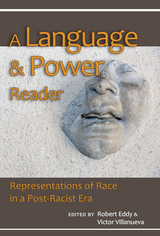 A Language and Power Reader: Representations of Race in a "Post-Racist" Era
Robert Eddy
Utah State University Press, 2014 A Language and Power Reader organizes reading and writing activities for undergraduate students, guiding them in the exploration of racism and cross-racial rhetorics.
Introducing texts written from and about versions of English often disrespected by mainstream Americans, A Language and Power Reader highlights English dialects and discourses to provoke discussions of racialized relations in contemporary America. Thirty selected readings in a range of genres and from writers who work in ?alternative? voices (e.g., Pidgin, African American Language, discourse of international and transnational English speakers) focus on disparate power relations based on varieties of racism in America and how those relations might be displayed, imposed, or resisted across multiple rhetorics. The book also directs student participation and discourse. Each reading is followed by comments and guides to help focus conversation.
Research has long shown that increasing a student?s metalinguistic awareness improves a student?s writing. No other reader available at this time explores the idea of multiple rhetorics or encourages their use, making A Language and Power Reader a welcome addition to writing classrooms.
Language and Sexuality: Contesting Meaning in Theory and Practice
Edited by Kathryn Campbell-Kibler, Robert J. Podesva, Sarah Roberts, and Andrew
CSLI, 2001 Language and Sexuality explores the question of how linguistic practices and ideologies relate to sexuality and sexual identity, opening with a discussion of the emerging field of "queer linguistics" and moving from theory into practice with case studies of language use in a wide variety of cultural settings. The resulting volume combines the perspectives of the field's top scholars with exciting new research to present new ideas on the ways in which language use intersects with sexual identity.
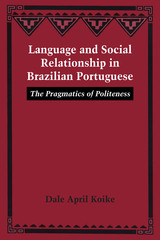 Language and Social Relationship in Brazilian Portuguese: The Pragmatics of Politeness
By Dale April Koike
University of Texas Press, 1992 "Give me the salt" and "Please pass the salt" make the same request, but in a polite situation the first utterance may give offense, while the second may not. How and why such differences in wording and intonation, in a particular context, produce different effects is the concern of pragmatics, the area of linguistics that deals with how speech is used in interaction. In this innovative study of pragmatics in Brazilian Portuguese, Dale Koike analyzes the politeness phenomenon, specifically in the context of speech acts known as "directives." As acts intended to get someone to do something, directives bring into play a variety of sociocultural factors, depending on the relationship between the participants. Using empirical data obtained through natural language observation and from questionnaires of over one hundred adult native speakers, Koike identifies factors—such as age, education, and gender—that influence the strategies of politeness a given speaker is likely to use in making a directive. This research clarifies the unwritten language rules and assumptions that native speakers intuitively follow in phrasing their directive utterances. Koike also includes important material on the acquisition of strategies for politeness by children and adult second-language learners, as well as on gender differences in politeness forms. Her research proposes important additions to the theory of speech acts as conceived by Austin and Searle, particularly in the application of deictic organization to account for a hierarchy of pragmatic forms. Language and Social Relationship in Brazilian Portuguese will be of interest to a wide audience in diverse fields, including linguistics, anthropology, interaction analysis, communications, semantics, sociology, psychology, and education.
Language and Species
Derek Bickerton
University of Chicago Press, 1992 Language and Species presents the most detailed and well-documented scenario to date of the origins of language. Drawing on "living linguistic fossils" such as "ape talk," the "two-word" stage of small children, and pidgin languages, and on recent discoveries in paleoanthropology, Bickerton shows how a primitive "protolanguage" could have offered Homo erectus a novel ecological niche. He goes on to demonstrate how this protolanguage could have developed into the languages we speak today.
"You are drawn into [Bickerton's] appreciation of the dominant role language plays not only in what we say, but in what we think and, therefore, what we are."—Robert Wright, New York Times Book Review
"The evolution of language is a fascinating topic, and Bickerton's Language and Species is the best introduction we have."—John C. Marshall, Nature
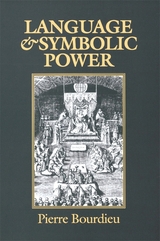 Language and Symbolic Power
Pierre Bourdieu
Harvard University Press, 1991 This volume brings together Pierre Bourdieu’s highly original writings on language and on the relations among language, power, and politics. Bourdieu develops a forceful critique of traditional approaches to language, including the linguistic theories of Saussure and Chomsky and the theory of speech-acts elaborated by Austin and others. He argues that language should be viewed not only as a means of communication but also as a medium of power through which individuals pursue their own interests and display their practical competence.
Drawing on the concepts that are part of his distinctive theoretical approach, Bourdieu maintains that linguistic utterances or expressions can be understood as the product of the relation between a “linguistic market” and a “linguistic habitus.” When individuals use language in particular ways, they deploy their accumulated linguistic resources and implicitly adapt their words to the demands of the social field or market that is their audience. Hence every linguistic interaction, however personal or insignificant it may seem, bears the traces of the social structure that it both expresses and helps to reproduce.
Bourdieu’s account sheds fresh light on the ways in which linguistic usage varies according to considerations such as class and gender. It also opens up a new approach to the ways in which language is used in the domain of politics. For politics is, among other things, the arena in which words are deeds and the symbolic character of power is at stake.
This volume, by one of the leading social thinkers in the world today, represents a major contribution to the study of language and power. It will be of interest to students throughout the social sciences and humanities, especially in sociology, politics, anthropology, linguistics, and literature.
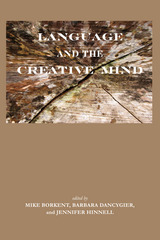 Language and the Creative Mind
Edited by Michael Borkent, Barbara Dancygier, and Jennifer Hinnell
CSLI, 2013 This volume brings together papers from the 11th Conceptual Structure, Discourse and Language Conference, held in Vancouver in May 2012. In the last few years, the cognitive study of language has begun to examine the interaction between language and other embodied communicative modalities, such as gesture, while at the same time expanding the traditional limits of linguistic and cognitive enquiry into creative domains such as music, literature, and visual images. Papers in this collection show how the study of language paves the way for these new areas of investigation. They bring issues of multimodal communication to the attention of linguists, while also looking through and beyond language into various domains of human creativity. This refreshed view of the relations across various communicative domains will be important not only to linguists, but also to all those interested in the creative potential of the human mind.
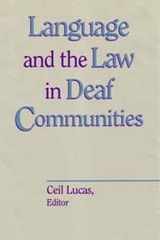 Language and the Law in Deaf Communities
Ceil Lucas
Gallaudet University Press, 2003 The ninth volume in the Sociolinguistics in Deaf Communities series focuses on forensic linguistics, a field created by noted linguist Roger Shuy, who begins the collection with an introduction of the issue of language problems experienced by minorities in legal settings. Attorney and linguist Rob Hoopes follows by showing how deaf people who use American Sign Language (ASL) are at a distinct disadvantage in legal situations, such as police interrogations, where only the feeblest of efforts are made to ensure that deaf suspects understand their constitutional rights.
Susan Mather, an associate professor of linguistics and interpretation, and Robert Mather, a federal disability rights attorney, examine the use of interpreters for deaf jurors during trials. They reveal the courts' gross misunderstandings of the important differences between ASL and Signed English. Sara S. Geer, an attorney at the National Association of the Deaf for 20 years, explains how the difficulty in understanding legal terminology in federal law is compounded for deaf people in every ordinary act, including applying for credit cards and filling out medical consent forms.
Language and the Law in Deaf Communities concludes with a chapter by George Castelle, Chief Public Defender in Charleston, West Virginia. Although he has no special knowledge about the legal problems of deaf people, Castelle offers another perspective based upon his extensive experience in practicing and teaching law.
Ceil Lucas is Professor of Linguistics in the Department of Linguistics and Interpretation at Gallaudet University.
ISBN 1-56368-143-9, 6 x 9 casebound, 200 pages, tables, references, index
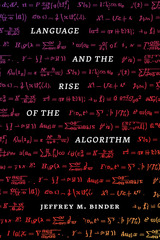 Language and the Rise of the Algorithm
Jeffrey M. Binder
University of Chicago Press, 2022 A wide-ranging history of the algorithm.
Bringing together the histories of mathematics, computer science, and linguistic thought, Language and the Rise of the Algorithm reveals how recent developments in artificial intelligence are reopening an issue that troubled mathematicians well before the computer age: How do you draw the line between computational rules and the complexities of making systems comprehensible to people? By attending to this question, we come to see that the modern idea of the algorithm is implicated in a long history of attempts to maintain a disciplinary boundary separating technical knowledge from the languages people speak day to day.
Here Jeffrey M. Binder offers a compelling tour of four visions of universal computation that addressed this issue in very different ways: G. W. Leibniz’s calculus ratiocinator; a universal algebra scheme Nicolas de Condorcet designed during the French Revolution; George Boole’s nineteenth-century logic system; and the early programming language ALGOL, short for algorithmic language. These episodes show that symbolic computation has repeatedly become entangled in debates about the nature of communication. Machine learning, in its increasing dependence on words, erodes the line between technical and everyday language, revealing the urgent stakes underlying this boundary.
The idea of the algorithm is a levee holding back the social complexity of language, and it is about to break. This book is about the flood that inspired its construction.
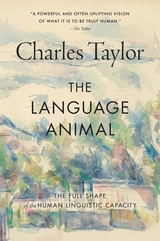 The Language Animal: The Full Shape of the Human Linguistic Capacity
Charles Taylor
Harvard University Press, 2016 “We have been given a powerful and often uplifting vision of what it is to be truly human.” —John Cottingham, The Tablet
In seminal works ranging from Sources of the Self to A Secular Age, Charles Taylor has shown how we create possible ways of being, both as individuals and as a society. In his new book setting forth decades of thought, he demonstrates that language is at the center of this generative process.
For centuries, philosophers have been divided on the nature of language. Those in the rational empiricist tradition—Hobbes, Locke, Condillac, and their heirs—assert that language is a tool that human beings developed to encode and communicate information. In The Language Animal, Taylor explains that this view neglects the crucial role language plays in shaping the very thought it purports to express. Language does not merely describe; it constitutes meaning and fundamentally shapes human experience. The human linguistic capacity is not something we innately possess. We first learn language from others, and, inducted into the shared practice of speech, our individual selves emerge out of the conversation.
Taylor expands the thinking of the German Romantics Hamann, Herder, and Humboldt into a theory of linguistic holism. Language is intellectual, but it is also enacted in artistic portrayals, gestures, tones of voice, metaphors, and the shifts of emphasis and attitude that accompany speech. Human language recognizes no boundary between mind and body. In illuminating the full capacity of “the language animal,” Taylor sheds light on the very question of what it is to be a human being.
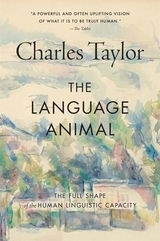 The Language Animal: The Full Shape of the Human Linguistic Capacity
Charles Taylor
Harvard University Press “We have been given a powerful and often uplifting vision of what it is to be truly human.” —John Cottingham, The Tablet
In seminal works ranging from Sources of the Self to A Secular Age, Charles Taylor has shown how we create possible ways of being, individually and as a society. The Language Animal examines the foundation of this generative process.
For centuries, philosophers have been divided on the nature of language. Rational empiricists—Hobbes, Locke, Condillac, and their heirs—assert that language is a tool to encode and communicate information. Yet this view neglects language’s crucial role in shaping the thought it expresses. Taylor argues that language does not merely describe; it constitutes meaning. Nor is linguistic capacity innately possessed. We learn language from others, and our individual selves emerge from the conversation.
Taylor expands the thinking of the German Romantics Hamann, Herder, and Humboldt into a theory of linguistic holism. Language is intellectual, but it is also enacted in artistic portrayals, gestures, metaphors, tones of voice, and the shifts of emphasis and attitude that accompany speech. Language recognizes no boundary between mind and body. In illuminating the full capacity of the language animal, Taylor sheds light on the very question of what it is to be human.
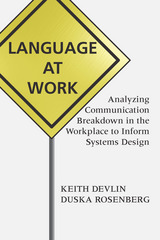 Language at Work: Analyzing Communication Breakdown in the Workplace to Inform Systems Design
Keith Devlin and Duska Rosenberg
CSLI, 1996 People are very creative in their use of language. This observation was made convincingly by Chomsky in the 1950s and is generally accepted in the scientific communities concerned with the study of language. Computers, on the other hand, are neither creative, flexible, nor adaptable. This is in spite of the fact that their ability to process language is based largely on the grammars developed by linguists and computer scientists. Thus, there is a mismatch between the observed human creativity and our ability as theorists to explain it. Language at Work examines grammars and other descriptions of language by combining the scientific and the practical. The scientific motivation is to unite distinct intellectual traditions, mathematics and descriptive social science, which have tried to provide an adequate explanation of language and its use on their own to no avail. This volume argues that Situation Theory, a theory of information couched in mathematics, has provided a uniform framework for the investigation of the creative aspects of language use. The application of Situation Theory in the study of language use in everyday communication to improve human/computer interaction is explored and espoused.
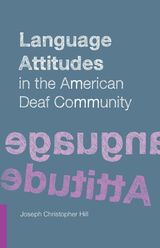 Language Attitudes in the American Deaf Community
Joseph Christopher Hill
Gallaudet University Press, 2012 In a diverse signing community, it is not unusual to encounter a wide variety of expression in the types of signs used by different people. Perceptions of signing proficiency often vary within the community, however. Conventional wisdom intimates that those who learned at an early age at home or in school know true standard American Sign Language, while those who learned ASL later in life or use contact or coded signs are considered to be less skillful. Joseph Christopher Hill’s new study Language Attitudes in the American Deaf Community explores the linguistic and social factors that govern such stereotypical perceptions of social groups about signing differences.
Hill’s analysis focuses on affective, cognitive, and behavioral types of evaluative responses toward particular language varieties, such as ASL, contact signing, and Signed English. His work takes into account the perceptions of these signing types among the social groups of the American Deaf community that vary based on generation, age of acquisition, and race. He also gauges the effects of social information on these perceptions and the evaluations and descriptions of signing that results from their different concepts of a signing standard. Language Attitudes concludes that standard ASL’s value will continue to rise and the Deaf/Hearing cultural dichotomy will remain relevant without the occurrence of a dramatic cultural shift.
Language Attitudes, National Identity and Migration in Catalonia: ‘What the Women Have to Say'
Mandie Iveson
Sussex Academic Press, 2022 This book examines language, nation, and identity from a gendered perspective and investigates to what extent women use Catalan in their everyday social practices to construct gendered and national identities. Drawing on a unique body of oral history interviews, the focus of the study is three female 'generations', covering 50 years of historical change from the 1960s to the present. Mandie Iveson analyzes the preservation of the Catalan language during Franco's regime; how the emergence of a feminist movement and discourse, and changing patterns of migration, have transformed the relationship between gender and national identity in Catalonia; and the role that Catalan plays today in defining women's identities. Additional analysis of a corpus of social media data explores the online Catalan discourses of nationalism and its gendered dimensions.
Language Attitudes, National Identity and Migration in Catalonia: ‘What the Women Have to Say'
Mandie Iveson
Sussex Academic Press, 2022 This book examines language, nation, and identity from a gendered perspective and investigates to what extent women use Catalan in their everyday social practices to construct gendered and national identities. Drawing on a unique body of oral history interviews, the focus of the study is three female 'generations', covering 50 years of historical change from the 1960s to the present. Mandie Iveson analyzes the preservation of the Catalan language during Franco's regime; how the emergence of a feminist movement and discourse, and changing patterns of migration, have transformed the relationship between gender and national identity in Catalonia; and the role that Catalan plays today in defining women's identities. Additional analysis of a corpus of social media data explores the online Catalan discourses of nationalism and its gendered dimensions.
Language Beyond Postmodernism: Saying and Thinking in Gendlin Philosophy
David Kleinberg-Levin
Northwestern University Press, 1997 Eugene Gendlin's contribution to the theory of language is the focus of this collection of essays edited by David Michael Levin. This compilation of critical studies—each followed by a comment from Gendlin himself—investigates how concepts grow out of experience, and explores relations between Gendlin's philosophy of language and experience and the philosophies of Wittgenstein, Dilthey, and Heidegger.
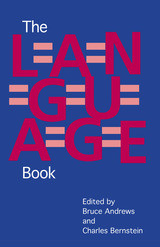 The Language Book
Bruce Andrews and Charles Bernstein
Southern Illinois University Press, 1984 “Ok murky in alter all end, unpredictable day, with rainshine any degree night, the sun kin warm and hot. Enough stone or other jugs lineup of whatever is In Through Out That’s light as much as known Differences evanesce Like, where and/or what on the equator might be french or spanish Longitude and latitude, yep yep sure Americana.”—Larry Eigner, commentary on a selection from Gertrude Stein’s Tender Buttons This selection of essays and poetry from the first three volumes of L=A=N=G=U=A=G=E magazine discusses a “spectrum of writing that places its attention primarily on language and ways of making meaning, that takes for granted neither vocabulary, grammar, process, shape, syntax, program, nor subject matter.” (Bernstein and Andrews) The various writers shun labels, slogans, or catch-phrases; their exploration of the ways that meanings and values are revealed through the written word is intended to open the field of poetic activity, not close it. The common thread of these essays is the multitude and scope of words’ referential powers—denotative, connotative, and associational; and studying these powers is ultimately a social and political activity as well as an aesthetic one.
Language Choice in Enlightenment Europe: Education, Sociability, and Governance
Edited by Vladislav Rjéoutski and Willem Frijhoff
Amsterdam University Press, 2018 This multinational collection of essays challenges the traditional image of a monolingual Ancient Regime in Enlightenment Europe, both East and West. Its archival research explores the important role played by selective language use in social life and in the educational provisions in the early constitution of modern society. A broad range of case studies show how language was viewed and used symbolically by social groups“ranging from the nobility to the peasantry“to develop, express, and mark their identities.
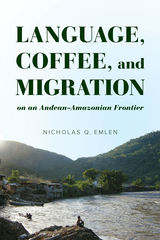 Language, Coffee, and Migration on an Andean-Amazonian Frontier
Nicholas Q. Emlen
University of Arizona Press, 2020 Extraordinary change is under way in the Alto Urubamba Valley, a vital and turbulent corner of the Andean-Amazonian borderland of southern Peru. Here, tens of thousands of Quechua-speaking farmers from the rural Andes have migrated to the territory of the Indigenous Amazonian Matsigenka people in search of land for coffee cultivation. This migration has created a new multilingual, multiethnic agrarian society.
The rich-tasting Peruvian coffee in your cup is the distillate of an intensely dynamic Amazonian frontier, where native Matsigenkas, state agents, and migrants from the rural highlands are carving the forest into farms. Language, Coffee, and Migration on an Andean-Amazonian Frontier shows how people of different backgrounds married together and blended the Quechua, Matsigenka, and Spanish languages in their day-to-day lives. This frontier relationship took place against a backdrop of deforestation, cocaine trafficking, and destructive natural gas extraction.
Nicholas Q. Emlen’s rich account—which takes us to remote Amazonian villages, dusty frontier towns, roadside bargaining sessions, and coffee traders’ homes—offers a new view of settlement frontiers as they are negotiated in linguistic interactions and social relationships. This interethnic encounter was not a clash between distinct groups but rather an integrated network of people who adopted various stances toward each other as they spoke.
The book brings together a fine-grained analysis of multilingualism with urgent issues in Latin America today, including land rights, poverty, drug trafficking, and the devastation of the world’s largest forest. It offers a timely on-the-ground perspective on the agricultural colonization of the Amazon, which has triggered an environmental emergency threatening the future of the planet.
 Language Contact: An Introduction
Sarah G. Thomason
Georgetown University Press On the Flathead Reservation in northwestern Montana, the sixty remaining fluent speakers of Montana Salish, most of them elderly, speak their language only to each other, changing to English when outsiders or younger tribal members are present. The Aleuts who used to live on Bering Island off the east coast of Russia speak Russian in addition to their native Aleut. The Republic of Singapore, an island nation of just 238 square miles, boasts four official languages. Language contact is everywhere: no nation has a completely monolingual citizenry and many have more than one official language. Sarah G. Thomason documents the linguistic consequences of language contacts worldwide. Surveying situations in which language contact arises, she focuses on what happens to the languages themselves: sometimes nothing, sometimes the incorporation of new words, sometimes the spread of new sounds and sentence structures across many languages and wide swathes of territory. She outlines the origins and results of contact-induced language change, extreme language mixture—which can produce pidgins, creoles, and bilingual mixed languages—and language death. The book concludes with a brief survey of language endangerment. Complete with lists of additional readings and references as well as a glossary for students new to the subject, this textbook is a richly documented introduction to a lively, fast-developing field.
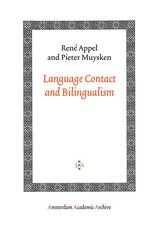 Language Contact and Bilingualism
René Appel and Pieter Muysken
Amsterdam University Press, 2006 What happens – sociologically, linguistically, educationally, politically – when more than one language is in regular use in a community? How do speakers handle these languages simultaneously, and what influence does this language contact have on the languages involved?
Although most people in the world use more than one language in everyday life, the approach to the study of language has usually been that monolingualism is the norm. The recent interest in bilingualism and language contact has led to a number of new approaches, based on research in communities in many different parts of the world. This book draws together this diverse research, looking at examples from many different situations, to present the topic in any easily accessible form.
Language contact is looked at from four distinct perspectives. The authors consider bilingual societies; bilingual speakers; language use in the bilingual community; finally language itself (do languages change when in contact with each other? Can they borrow rules of grammar, or just words? How can new languages emerge from language contact?). The result is a clear, concise synthesis offering a much-needed overview of this lively area of language study.
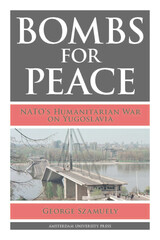 Language Contact and Bilingualism
Rene Appel
Amsterdam University Press, 2013 What happens – sociologically, linguistically, educationally, politically – when more than one language is in regular use in a community? How do speakers handle these languages simultaneously, and what influence does this language contact have on the languages involved?
Although most people in the world use more than one language in everyday life, the approach to the study of language has usually been that monolingualism is the norm. The recent interest in bilingualism and language contact has led to a number of new approaches, based on research in communities in many different parts of the world. This book draws together this diverse research, looking at examples from many different situations, to present the topic in any easily accessible form.
Language contact is looked at from four distinct perspectives. The authors consider bilingual societies; bilingual speakers; language use in the bilingual community; finally language itself (do languages change when in contact with each other? Can they borrow rules of grammar, or just words? How can new languages emerge from language contact?). The result is a clear, concise synthesis offering a much-needed overview of this lively area of language study.
Language, Culture, and Mind
Edited by Michel Achard and Suzanne Kemmer
CSLI, 2003 Language, Culture, and Mind is a stimulating collection exploring the ways that cognitive, social, and cultural categories are revealed through language. Contributors use methods such as psycholinguistic experiments and observations of natural discourse to probe how such categories are organized, with grammatical and semantic analyses—in modern cognitive frameworks—augmenting these approaches. Some of the phenomena studied include the linguistic expression of space and causality; aspect, classifiers, negation, and complement constructions; and metaphor, metonymy, and conceptual blending across different domains of human experience. The result is a fresh perspective on the way language relates to thought and culture.
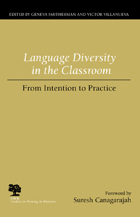 Language Diversity in the Classroom: From Intention to Practice
Edited by Geneva Smitherman and Victor Villanueva. Foreword by Suresh Canagarajah
Southern Illinois University Press, 2003 It’s no secret that, in most American classrooms, students are expected to master standardized American English and the conventions of Edited American English if they wish to succeed. Language Diversity in the Classroom: From Intention to Practice works to realign these conceptions through a series of provocative yet evenhanded essays that explore the ways we have enacted and continue to enact our beliefs in the integrity of the many languages and Englishes that arise both in the classroom and in professional communities. Edited by Geneva Smitherman and Victor Villanueva, the collection was motivated by a survey project on language awareness commissioned by the National Council of Teachers of English and the Conference on College Composition and Communication. All actively involved in supporting diversity in education, the contributors address the major issues inherent in linguistically diverse classrooms: language and racism, language and nationalism, and the challenges in teaching writing while respecting and celebrating students’ own languages. Offering historical and pedagogical perspectives on language awareness and language diversity, the essays reveal the nationalism implicit in the concept of a “standard English,” advocate alternative training and teaching practices for instructors at all levels, and promote the respect and importance of the country’s diverse dialects, languages, and literatures. Contributors include Geneva Smitherman, Victor Villanueva, Elaine Richardson, Victoria Cliett, Arnetha F. Ball, Rashidah Jammi` Muhammad, Kim Brian Lovejoy, Gail Y. Okawa, Jan Swearingen, and Dave Pruett. The volume also includes a foreword by Suresh Canagarajah and a substantial bibliography of resources about bilingualism and language diversity.
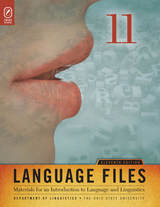 Language Files: Materials for an Introduction to Language and Linguistics, 11th Edition
Department of Linguistics
Ohio State University Press, 2011
Since its inception, Language Files has become one of the most widely adopted, consulted, and authoritative introductory textbooks to linguistics ever written. The scope of the text makes it suitable for use in a wide range of courses, while its unique organization into student-friendly, self-contained sections allows for tremendous flexibility in course design.
The eleventh edition has been revised, clarified, and updated in many places. This edition includes an all-new syntax chapter, new files on language and culture and on writing systems, restructured semantics files, and many new examples, exercises, and activities. Additional readings have been added to all chapters, and the number of cross-references among chapters has been increased. In addition, the accompanying Language Files webpage has links to online resources and websites related to language and linguistics that instructors and students may find interesting.
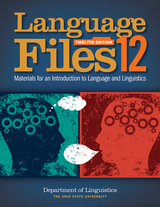 Language Files: Materials for an Introduction to Language and Linguistics, 12th Edition
Department of Linguistics, The Ohio State University
Ohio State University Press, 2016 Language Files: Materials for an Introduction to Language and Linguistics has become one of the most widely adopted, consulted, and authoritative introductory textbooks to linguistics ever written. The scope of the text makes it suitable for use in a wide range of courses, while its unique organization into student-friendly, self-contained sections allows for tremendous flexibility in course design.
The twelfth edition has been significantly revised, clarified, and updated throughout—with particular attention to the chapters on phonetics, phonology, pragmatics, and especially psycholinguistics. The restructured chapter on psycholinguistics makes use of recent research on language in the brain and includes expanded coverage of language processing disorders, introducing students to current models of speech perception and production and cutting-edge research techniques. In addition, exercises have been updated, and icons have been added to the text margins throughout the book, pointing instructors and students to useful and engaging audio files, videos, and other online resources on the accompanying Language Files website, which has also been significantly expanded.
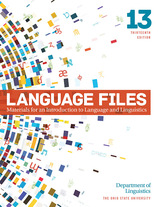 Language Files: Materials for an Introduction to Language and Linguistics, 13th Edition
The Ohio State University Department of Linguistics
Ohio State University Press, 2022 Language Files has become one of the most widely adopted, consulted, and authoritative introductory textbooks to linguistics ever written. The scope of the text makes it suitable for use in a wide range of courses, while its unique organization into student-friendly, self-contained sections allows for tremendous flexibility in course design. The thirteenth edition has been revised, clarified, and updated throughout to ensure that it remains the most comprehensive and accessible introductory linguistics textbook on the market. The revised chapter on morphology includes a more thorough discussion of allomorphy and adds sections on templatic morphology, suprasegmental morphology, and morphological metathesis to give students a more complete picture of all morphological phenomena. The chapter on language and computers has been updated with new sections on deep learning, artificial neural networks, and on other areas of computational linguistics, providing readers with a better sense of current research and applications in this rapidly developing field. Other additions include new sections on syntactic non-constituents and non-generative rule systems in the syntax chapter and a complete rewrite to the creole languages file in the language contact chapter. We have also adopted the use of the singular they when referring to a generic person whose gender is unknown or irrelevant. Exercises and lists of other readings have been updated throughout.
 Language for Specific Purposes: Trends in Curriculum Development
Mary K. Long, Editor
Georgetown University Press, 2017 In the United States today there is lively discussion, both among educators and employers, about the best way to prepare students with high-level language and cross-cultural communication proficiency that will serve them both professionally and personally in the global environment of the twenty-first century. At the same time, courses in business language and medical language have become more popular among students. Language for Specific Purposes (LSP), which encompasses these kinds of courses, responds to this discussion and provides curricular models for language programs that build practical language skills specific to a profession or field. Contributions in the book reinforce those models with national survey results, demonstrating the demand for and benefits of LSP instruction. With ten original research-based chapters, this volume will be of interest to high school and university language educators, program directors, linguists, and anyone looking to design LSP courses or programs in any world language.
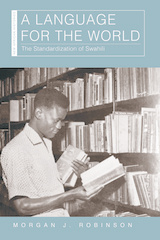 A Language for the World: The Standardization of Swahili
Morgan J. Robinson
Ohio University Press, 2022 This intellectual history of Standard Swahili explores the long-term, intertwined processes of standard making and community creation in the historical, political, and cultural contexts of East Africa and beyond. Morgan J. Robinson argues that the portability of Standard Swahili has contributed to its wide use not only across the African continent but also around the globe. The book pivots on the question of whether standardized versions of African languages have empowered or oppressed. It is inevitable that the selection and promotion of one version of a language as standard—a move typically associated with missionaries and colonial regimes—negatively affected those whose language was suddenly deemed nonstandard. Before reconciling the consequences of codification, however, Robinson argues that one must seek to understand the process itself. The history of Standard Swahili demonstrates how events, people, and ideas move rapidly and sometimes surprisingly between linguistic, political, social, or temporal categories. Robinson conducted her research in Zanzibar, mainland Tanzania, and the United Kingdom. Organized around periods of conversation, translation, and codification from 1864 to 1964, the book focuses on the intellectual history of Swahili’s standardization. The story begins in mid-nineteenth-century Zanzibar, home of missionaries, formerly enslaved students, and a printing press, and concludes on the mainland in the mid-twentieth century, as nationalist movements added Standard Swahili to their anticolonial and nation-building toolkits. This outcome was not predetermined, however, and Robinson offers a new context for the strong emotions that the language continues to evoke in East Africa. The history of Standard Swahili is not one story, but rather the connected stories of multiple communities contributing to the production of knowledge. The book reflects this multiplicity by including the narratives of colonial officials and anticolonial nationalists; East African clerks, students, newspaper editors, editorialists, and their readers; and library patrons, academic linguists, formerly enslaved children, and missionary preachers. The book reconstructs these stories on their own terms and reintegrates them into a new composite that demonstrates the central place of language in the history of East Africa and beyond.
Language from a Cognitive Perspective: Grammar, Usage, and Processing
Edited by Emily M. Bender and Jennifer E. Arnold
CSLI, 2011 This book is a collection of papers on language processing, usage, and grammar, written to commemorate the career of Thomas Wasow on the occasion of his sixty-fifth birthday. Wasow has been professor of linguistics and philosophy at Stanford University since 1973, and is affiliated with the Symbolic Systems Program. He has made significant contributions to the study of English syntax, psycholinguistics, and philosophy of linguistics.
Language, History, and Identity: Ethnolinguistic Studies of the Arizona Tewa
Paul V. Kroskrity
University of Arizona Press, 1993 The Arizona Tewa are a Pueblo Indian group that migrated around 1700 to First Mesa on the Hopi Reservation and who, while speaking Hopi, have also retained their native language. Paul V. Kroskrity examines this curiosity of language and culture, explaining the various ways in which the Tewa use their linguistic resources to successfully adapt to the Hopi and their environment while retaining their native language and the cultural identity it embodies.
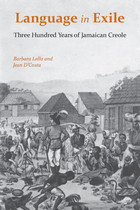 Language in Exile: Three Hundred Years of Jamaican Creole
Barbara Lalla
University of Alabama Press, 2009 "An important addition to studies of the genesis and life of Jamaican Creole as well as other New World creoles such as Gulla. Highlighting the nature of the nonstandard varieties of British English dialects to which the African slaves were exposed, this work presents a refreshingly cogent view of Jamaican Creole features."
--SECOL Review
"The history of Jamaican Creole comes to life through this book. Scholars will analyze its texts, follow the leads it opens up, and argue about refining its interpretations for a long time to come."
--Journal of Pidgin & Creole Languages
"The authors are to be congratulated on this substantial contribution to our understanding of how Jamaican Creole developed. Its value lies not only in the linguistic insights of the authors but also in the rich trove of texts that they have made accessible."
--English World-Wide
"Provides valuable historical and demographic data and sheds light on the origins and development of Jamaican Creole. Lalla and D'Costa offer interesting insights into Creole genesis, not only through their careful mapping of the migrations from Europe and Africa, which constructed the Jamaican society but also through extensive documentation of early texts. . . . Highly valuable to linguists, historians, anthropologists, psychologists, and anyone interested in the Caribbean or in the history of mankind."
--New West Indian Guide
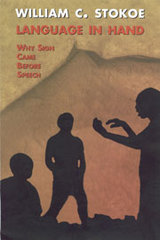 Language in Hand: Why Sign Came Before Speech
William C. Stokoe
Gallaudet University Press, 2001 In Language in Hand: Why Sign Came Before Speech, William C. Stokoe begins his exploration of the origin of human language with a 2400-year-old quote by Democritus: “Everything existing in the universe is the fruit of chance and necessity.” Stokoe capitalizes upon this simple credo in this far-ranging examination of the scholarly topography to support his formula for the development of language in humans: gesture-to-language-to-speech. Intrinsic to this is the proposition that speech is sufficient for language, but not necessary. Chance brought human ancestors down from the trees to the ground, freeing their hands for gesture, and then sign language, a progression that came from the necessity to communicate. Stokoe recounts in Language in Hand how inspiration grew out of his original discovery in the 1950s and ’60s that deaf people who signed were using a true language with constructions that did not derive from spoken English. This erudite, highly engaging investigation calls upon decades of personal experience and published research to refute the recently entrenched principles that humans have a special, innate learning faculty for language and that speech equates with language. Integrating current findings in linguistics, semiotics, and anthropology, Stokoe fashions a closely-reasoned argument that suggests how our human ancestors’ powers of observation and natural hand movements could have evolved into signed morphemes. Stokoe also proposes how the primarily gestural expression of language with vocal support shifted to primarily vocal language with gestural accompaniment. When describing this transition, however, he never loses sight of the significance of humans in the natural world and the role of environmental stimuli in the development of language. Stokoe illustrates this contention with fascinating observations of small, contemporary ethnic groups such as the Assiniboin Nakotas, a Native American group from Montana that intermingle their spoken and signed languages depending upon cultural imperatives. Language in Hand also presents innovative thoughts on classifiers in American Sign Language and their similarity to certain spoken languages, convincing evidence that speech originally copied sign language forms before developing unrelated conventions through usage. Stokoe concludes with a hypothesis on how the acceptance of sign language as the first language of humans could revolutionize the education of infants, both deaf and hearing, who, like early humans, have the full capacity for language without speech.
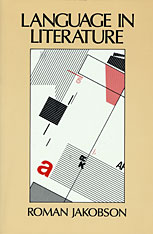 Language in Literature
Roman Jakobson
Harvard University Press, 1987 "Roman Jakobson was one of the great minds of the modern world," Edward J. Brown has written, "and the effects of his genius have been felt in many fields: linguistics, semiotics, art, structural anthropology, and, of course, literature." At every stage in his odyssey from Moscow to Prague to Denmark and then to the United States, he formed collaborative efforts that changed the very nature of each discipline he touched. This book is the first comprehensive presentation in English of Jakobson's major essays on the intertwining of language and literature: here the reader will learn how it was that Jakobson became legendary.
Jakobson reveals himself as one of the great explorers of literary art in our day--a critic who revealed the avant-garde thrust of even the most worked-over poets, such as Shakespeare and Pushkin, and enabled the reader to see them as the innovators they were. Jakobson takes the reader from literature to grammar and then back again, letting points of structural detail throw a sharp light on the underlying form and linking thereby the most disparate realms into a coherent whole. In his essays we can also learn to appreciate his search for a fully systematic, nonmetaphysical understanding of the workings of literature: Jakobson made possible a deep structural analysis that did not exist before.
Among the essential items in this collection are such classics as "Linguistics and Poetics" and "On a Generation That Squandered Its Poets" and illuminations of Baudelaire, Yeats, Turgenev, Pasternak, and Blake, as well as the famous pieces on Shakespeare and Pushkin. The essays include fundamental theoretical statements, structural analyses of individual poems, explorations of the connections between poetry and experience, and semiotic perspectives on the structure of verbal and nonverbal art. This will become a basic book for contemplating the function of language in literature--a project that will continue to engross the keenest readers.
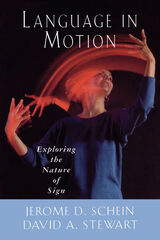 Language in Motion: Exploring the Nature of Sign
Jerome D. Schein
Gallaudet University Press, 1995 Language in Motion invites readers to explore the fascinating nature of American Sign Language (ASL).
This enjoyable book first introduces sign language and communication, follows with a history of sign languages in general, then delves into the structure of ASL. Later chapters outline the special skills of fingerspelling and assess the academic offshoot of artificial sign systems and their value to young deaf children.
Language in Motion offers for consideration the process required to learn sign language and putting sign language to work to communicate in the Deaf community. Appendices featuring the manual alphabets of three countries and a notation system developed to write signs complete this enriching book. Its delightful potpourri of entertaining, accessible knowledge makes it a perfect primer for those interested in learning more about sign language, Deaf culture, and Deaf communities.
 Language in Use: Cognitive and Discourse Perspectives on Language and Language Learning
Andrea E. Tyler, Mari Takada, Yiyoung Kim, and Diana Marinova, Editors
Georgetown University Press, 2005 Language in Use creatively brings together, for the first time, perspectives from cognitive linguistics, language acquisition, discourse analysis, and linguistic anthropology. The physical distance between nations and continents, and the boundaries between different theories and subfields within linguistics have made it difficult to recognize the possibilities of how research from each of these fields can challenge, inform, and enrich the others. This book aims to make those boundaries more transparent and encourages more collaborative research. The unifying theme is studying how language is used in context and explores how language is shaped by the nature of human cognition and social-cultural activity. Language in Use examines language processing and first language learning and illuminates the insights that discourse and usage-based models provide in issues of second language learning. Using a diverse array of methodologies, it examines how speakers employ various discourse-level resources to structure interaction and create meaning. Finally, it addresses issues of language use and creation of social identity. Unique in approach and wide-ranging in application, the contributions in this volume place emphasis on the analysis of actual discourse and the insights that analyses of such data bring to language learning as well as how language shapes and reflects social identity—making it an invaluable addition to the library of anyone interested in cutting-edge linguistics.
Language Learnability and Language Development
Steven Pinker
Harvard University Press, 1984 In this influential study, Steven Pinker develops a new approach to the problem of language learning. Now reprinted with new commentary by the author, this classic work continues to be an indispensable resource in developmental psycholinguistics.
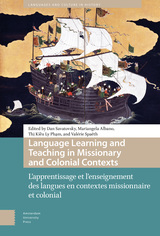 Language Learning and Teaching in Missionary and Colonial Contexts: L'apprentissage et l'enseignement des langues en contextes missionnaire et colonial
Dan Savatovsky
Amsterdam University Press, 2023 This volume assembles texts dedicated to the linguistic and educational aspects of missionary and colonial enterprises, taking into account all continents and with an extended diachronic perspective (15th–20th centuries). Strictly speaking, this “linguistics” is contemporary to the colonial era, so it is primarily the work of missionaries of Catholic orders and Protestant societies. It can also belong to a retrospective outlook, following decolonization. In the first category, one mostly finds transcription, translation, and grammatization practices (typically, the production of dictionaries and grammar books). In the second category, one finds in addition descriptions of language use, of situations of diglossia, and of contact between languages. Within this framework, the volume focuses on educational and linguistic policies, language teaching and learning, and the didactics that were associated with them.
Language, Literature and the Construction of a Dutch National Identity (1780-1830)
Edited by Rick Honings, Gijsbert Rutten, and Ton van Kalmthout
Amsterdam University Press, 2018 In exploring the birth of a Dutch identity between 1780 and 1830, this book integrates nationalism studies with literary and linguistic history by highlighting scholarly study of the Dutch language as a factor in the creation of the national identity. These early scholars promoted the Dutch language during a time of political upheaval, when citizens needed something to feel proud of. This book examines the impact individual agents had on a crucial stage in the Dutch nation-building process.
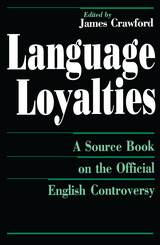 Language Loyalties: A Source Book on the Official English Controversy
Edited by James Crawford
University of Chicago Press, 1992 As late as 1987, two-thirds of the Americans who responded to a national survey believed that English was the official language of the United States. In fact, the Constitution is silent on the issue. Since Senator S. I. Hayakawa first proposed an English Language Amendment in Congress in 1981, Official English has been considered in forty-seven states and adopted by seventeen; the amendment is pending in the 102d Congress.
Supporters argue that English has always been our common language—a means of resolving conflicts in a nation of diverse racial, ethnic, and religious groups, and an essential tool of social mobility and cultural integration. Opponents charge that the amendment is unnecessary and that it threatens civil rights, educational opportunities, and free speech, wrapping racist biases in a cloak of patriotism.
Language Loyalties: A Source Book on the Official English Controversy provides a balanced, comprehensive guide to this complex and often confusing debate. It is an essential handbook and reference for advocates, educators, policymakers, jurists, scholars, and citizens who seek to join this debate fully informed. Addressing the issues involved in developing America's first planned national language policy, James Crawford has expertly collected and introduced more than eighty-five source documents and articles.
 Language Machines: Cultural AI and the End of Remainder Humanism
Leif Weatherby
University of Minnesota Press, 2025 How generative AI systems capture a core function of language Looking at the emergence of generative AI, Language Machines presents a new theory of meaning in language and computation, arguing that humanistic scholarship misconstrues how large language models (LLMs) function. Seeing LLMs as a convergence of computation and language, Leif Weatherby contends that AI does not simulate cognition, as widely believed, but rather creates culture. This evolution in language, he finds, is one that we are ill-prepared to evaluate, as what he terms “remainder humanism” counterproductively divides the human from the machine without drawing on established theories of representation that include both. To determine the consequences of using AI for language generation, Weatherby reads linguistic theory in conjunction with the algorithmic architecture of LLMs. He finds that generative AI captures the ways in which language is at first complex, cultural, and poetic, and only later referential, functional, and cognitive. This process is the semiotic hinge on which an emergent AI culture depends. Weatherby calls for a “general poetics” of computational cultural forms under the formal conditions of the algorithmic reproducibility of language. Locating the output of LLMs on a spectrum from poetry to ideology, Language Machines concludes that literary theory must be the backbone of a new rhetorical training for our linguistic-computational culture.
Language, Mind and Brain: Some Psychological and Neurological Constraints on Theories of Grammar
Ewa Dabrowska
Georgetown University Press, 2004 Language, Mind and Brain is a delightfully readable, yet erudite exploration of how the human mind processes and orders sounds and words into meaning. It explores how properties of the human mind/brain constrain linguistic structure and how linguistics can benefit by combining traditional linguistic methodologies with insights from research on language acquisition, processing, and impairment. The first part of the book offers a useful introduction to the relevant issues for readers with little prior knowledge of these disciplines; part two addresses such key issues as the status of rules, the relationship between grammar and the lexicon, and the relationship between innate structure and acquired knowledge. Fascinating for anyone interested in the intricacies of how language is acquired and how the brain sorts sounds into communication.
 Language, Mind, and Knowledge
Keith Gunderson, Editor
University of Minnesota Press, 1975 Language, Mind, and Knowledge was first published in 1975. Minnesota Archive Editions uses digital technology to make long-unavailable books once again accessible, and are published unaltered from the original University of Minnesota Press editions. This is Volume VII of the Minnesota Studies in the Philosophy of Science, a series published in cooperation with the Minnesota Center for Philosophy of Science at the University of Minnesota and edited by Herbert Feigl and Grover Maxwell. Professor Maxwell is the present director of the Center. Some of the papers in this volume were presented at or grew out of a conference on the philosophy of language which was held at the Center under the direction of Professor Gunderson. Others were written independently. The aim of the book, like that of the conference, is to assemble a wide variety of approaches to issues in the philosophy of language with emphasis on the ways in which the issues involved have bearing on other matters such as linguistic theory, cognitive psychology, the philosophy of mind, and epistemology. There are twelve papers by eleven contributors: "Languages and Language" by David Lewis; "Logic and Language: An Examination of Recent Criticisms of Internationalism" by Jerrold J. Katz; "The Meaning of 'Meaning'" by Hilary Putnam; "Reference and Context" by Charles Chastain; "Language, Thought, and Communication" by Gilbert Harman; "Knowledge of Language" by Noam Chomsky; "Language, Rules, and Complex Behavior" by Michael D. Root; "A Taxonomy of Illocutionary Acts" by John R. Searle; "On What We Know" by Zeno Vendler; "Vendler on Knowledge and Belief" by Bruce Aune; "Reply to Professor Aune" by Zeno Vendler; "Brain Writing and Mind Reading" by D.C. Dennett.
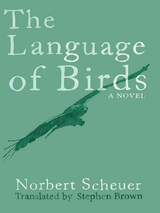 The Language of Birds
Norbert Scheuer
Haus Publishing, 2018 It is 2003, and Paul Arimond is serving as a paramedic in Afghanistan. The twenty-four-year-old has no illusions of becoming a hero. Rather, he has chosen the army to escape the tragedies of his past and his own feelings of guilt. As a result, he finds himself in the same land, now war-torn, where an ancestor of his, Ambrosius Arimond, a late eighteenth-century traveler and ornithologist, once explored and developed the theory of a universal language of birds.
As visceral horrors and everyday banalities of the war threaten to engulf Paul, he, like his great-great-grandfather, finds his very own refuge in Afghanistan’s natural world. In a diary filled with exquisite drawings of birds and ruminations on the life he left behind, Paul describes his experiences living with two comrades who are fighting their own demons and his befriending of an Afghan man, Nassim, as well as his dreams of escaping the restrictive base camp and visiting the shores of a lake visible from the lookout tower. But when he finally reaches the lake one night, he finds himself in the midst of a chain of events that, with his increasingly fragile state of mind, has dramatic—and ultimately heartbreaking—consequences.
A meditative novel that shows a new side to the conflict in Afghanistan, The Language of Birds takes a moving look at the all-too-human costs of war and questions what it truly means to fight for freedom.
 The Language of Canaan: Metaphor and Symbol in New England from the Puritans to the Transcendentalists
Mason I. Lowance, Jr.
Harvard University Press, 1980 This is a study of New England figurative language from 1600 to 1850, from the English and Continental origins of Puritanism to the symbolic writings of Thoreau. It enriches our understanding of Puritan thought and expression and traces the influence of Puritanism on later American writing.
A common link among the writers of this period was a system of prophetic symbolism derived from Scripture. The Bible was the source of figures and types used to illustrate divine guidance in human affairs, and its prophetic language provided the Puritans with a method for explaining and projecting the course of history. Mason Lowance explores these modes of prophetic and metaphorical expression and the millennial impulse in American thinking. In the process he provides a cohesive approach to such diverse writers as Bradford, Cotton, Taylor, Increase and Cotton Mather, Edwards, Freneau, Barlow, Dwight, and Emerson. His book will be welcomed by all students of early American thought and literature.
 The Language of Dissent: Edward Schillebeeckx on the Crisis of Authority in the Catholic Church
Daniel Speed Thompson
University of Notre Dame Press, 2003 Written in the context of a decades-long struggle between progressive theologians and the magisterium-a struggle symptomatic of the current and wider crisis in the Roman Catholic Church-The Language of Dissent uses the theology of Edward Schillebeeckx as it has evolved and developed to analyze fundamental questions of authority and dissent in the church. Daniel Speed Thompson's approach to the issue of authority is unique in that he reflects not only on the character of the church but also on the very nature of salvation, revelation, and theological language.
After briefly describing the current crisis of authority in the Catholic Church, Thompson describes the conceptual framework that shapes Schillebeeckx's understanding of knowledge, language, action, and authority. In particular, Thompson demonstrates the complex interrelationship between experience, praxis, and language in Schillebeeckx's three models of epistemology.
With these foundations in place, Thompson offers a synthesis of Schillebeeckx's writings on ecclesiology and the apostolicity of the church. Thompson argues that Schillebeeckx's writings in these areas, as well as in epistemology and fundamental theology, not only allow for theological dissent, but actually demand their existence within a healthy church. Thompson concludes by suggesting that the consistent application of Schillebeeckx's principles argue for a democratization of the Roman Catholic Church. Incorporating previously untranslated and new material, as well as a preface, by Schillebeeckx, The Language of Dissent makes a substantial contribution to contemporary Catholic theology.
DANIEL SPEED THOMPSON is assistant professor of theology and associate department chair at Fordham University's Lincoln Center campus.
Reviews
"Schillebeeckx has been constantly under investigation by the Congregation for the Doctrine of the Faith, and yet never condemned. This excellent book helps one to understand why." --Times Literary Supplement
"An eminently accessible exposition of the principles behind Schillebeeckx's affirmation that a healthy church requires dissent." --Conscience
"Thompson wrote this excellent book before the current sexual abuse crisis, but it offers ideas that can serve as resources in the present situation. Thompson presents Dutch theologian Edward Schillenbeeckx's theology of the church, which well deserves this systematic and balanced treatment … [Thompson] attends carefully to the historical development of Schillebeeckx's thought and appreciates the significance of the studies of epistemology and hermeneutics that undergird much of his thinking about experience. Highly recommended." --Choice
"… superb…." --Catholic Library World
The Language of Drawing and Painting
Arthur Pope
Harvard University Press To understand paintings made by Chinese or Japanese artists or by European artists of the Middle Ages or the Renaissance, it is in a way just as necessary to know the conventions and the points of view which governed their execution, as it is to know Chinese and Italian in order to understand books written in these languages. It is the object of this volume to make the various kinds of drawing and painting intelligible by explaining the conventions and limitations on which they are based. The last chapter deals with the general points of view involved in the “modernistic” art of the day.
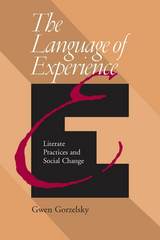 Language Of Experience: Literate Practices And Social Change
Gwen Gorzelsky
University of Pittsburgh Press, 2005
The Language of Experience examines the relationship between literacy and change--both personal and social. Gorzelsky studies three cases, two historical and one contemporary, that speak to key issues on the national education agenda.
"Struggle" is a community literacy program for urban teens and parents. It encourages them to reflect on, articulate, and revise their life goals and design and implement strategies for reaching them. To provide historical context for this and other contemporary efforts in using literacy to promote social change, Gorzelsky analyzes two radical religious and political movements of the English Civil Wars and the 1930s unionizing movement in the Pittsburgh region. Charting the similarities and differences in the function of literate practices in each case shows how different situations and contexts can foster very different outcomes.
Gorzelsky's analytic frame is drawn from Gestalt theory, which emphasizes the holistic nature of perception, communication, and learning. Through it she views how discourse and language structures interact with experience and how this interaction changes awareness and perception.
The book is methodologically innovative in its integration of a macro-social view of cultural, social, and discursive structures with a micro-social view of the potential for change embodied in them. Through her analysis and in her use of the voices of the people she studies, Gorzelsky offers a tool for analyzing individual instances of literate practices and their potential for fostering change.
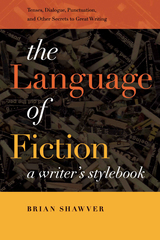 The Language of Fiction: A Writer’s Stylebook
Brian Shawver
University Press of New England, 2013 Grand themes and complex plots are just the beginning of a great piece of fiction. Mastering the nuts and bolts of grammar and prose mechanics is also an essential part of becoming a literary artist. This indispensable guide, created just for writers of fiction, will show you how to take your writing to the next level by exploring the finer points of language. Funny, readable, and wise, this book explores the tools of the fiction writer’s trade, from verb tenses to pronouns to commas and beyond. Filled with examples from the best-seller lists of today and yesterday, it will help you consider the hows and whys of language, and how mastery of them can be used to achieve clarity and grace of expression in your own work. Here, you’ll find Encouragement and advice to face the big questions: Past or present tense? Comma or semicolon? Italic or roman? Should your dialogue be phonetically rendered, or follow standard rules of grammar? (And where does that pesky quotation mark go, again?) Warning signs of the betrayal of language, and ways to avoid it: Unwitting rhymes, repetition, redundancy, cliché, and the inevitable failure of vocabulary How-to (and how-not-to) examples: The grammatical “mistakes” of Charles Dickens; ambiguous pronoun usage by Nathaniel Hawthorne; the minefield of paragraph fragments found in one of today’s most successful authors.
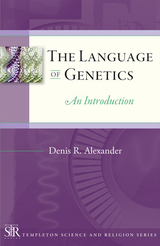 The Language of Genetics: An Introduction
Denis R. Alexander
Templeton Press, 2011 The Language of Genetics: An Introduction is the seventh title published in the Templeton Science and Religion Series, in which scientists from a wide range of fields distill their experience and knowledge into brief tours of their respective specialties. In this volume, Dr. Denis R. Alexander offers readers a basic toolkit of information, explanations, and ideas that can help us grasp something of the fascination and the challenge of the language of genetics. Alexander surveys the big picture, covering such topics as the birth of the field; DNA: what it is, how it works, and how it was discovered; our genetic history; the role of genes in diseases, epigenetics, and genetic engineering. The book assumes the reader has little scientific background, least of all in genetics, and approaches these issues in a very accessible way, free of specialized or overly technical jargon. In the last chapter, Dr. Alexander explores some of the big questions raised by genetics: what are its implications for notions of human value and uniqueness? Is evolution consistent with religious belief? If we believe in a God of love, then how come the evolutionary process, utterly dependent upon the language of genetics, is so wasteful and involves so much pain and suffering? How far should we go in manipulating the human genome? Does genetics subvert the idea that life has some ultimate meaning and purpose? Genetics is a rapidly advancing field; it seems new discoveries make headlines every other week. The Language of Genetics is intended to give the general reader the knowledge he or she needs to assess and understand the next big story
in genetics.
 The Language of Home: Stories
Raymond Luczak
Gallaudet University Press, 2025 What is the language of home?
This short story collection offers readers many possible answers that reveal the Deaf experience in all its complexities. Written over nearly forty years by celebrated Deaf author Raymond Luczak, this collection of thirty stories paints a vivid panorama of Deaf lives. From a young DeafBlind boy feeling lost within his hearing family to a hearing son of Deaf parents caught between their infighting and a hearing mother realizing in the split second of her own death the full impact of the missteps she has taken while raising her Deaf son, Luczak crafts narratives that resonate with authenticity. Other stories feature an ASL interpreter feeling conflicted about a Deaf neighbor and a Deaf woman who becomes blacklisted as a backstabber. These characters often navigate the murky waters of the hearing world, sometimes with a touch of ASL gloss. The Language of Home is an exciting literary contribution that offers rare, nuanced representations of Deaf characters.
The Language of Images
W. J. T. Mitchell
University of Chicago Press, 1980 "A remarkably rich and provocative set of essays on the virtually infinite kinds of meanings generated by images in both the verbal and visual arts. Ranging from Michelangelo to Velazquez and Delacroix, from the art of the emblem book to the history of photography and film, The Language of Images offers at once new ways of thinking about the inexhaustibly complex relation between verbal and iconic representation."—James A. W. Heffernan, Dartmouth College
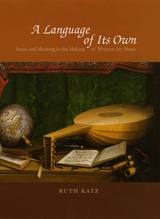 A Language of Its Own: Sense and Meaning in the Making of Western Art Music
Ruth Katz
University of Chicago Press, 2009 The Western musical tradition has produced not only music, but also countless writings about music that remain in continuous—and enormously influential—dialogue with their subject. With sweeping scope and philosophical depth, A Language of Its Own traces the past millennium of this ongoing exchange. Ruth Katz argues that the indispensible relationship between intellectual production and musical creation gave rise to the Western conception of music. This evolving and sometimes conflicted process, in turn, shaped the art form itself. As ideas entered music from the contexts in which it existed, its internal language developed in tandem with shifts in intellectual and social history. Katz explores how this infrastructure allowed music to explain itself from within, creating a self-referential and rational foundation that has begun to erode in recent years. A magisterial exploration of a frequently overlooked intersection of Western art and philosophy, A Language of Its Own restores music to its rightful place in the history of ideas.
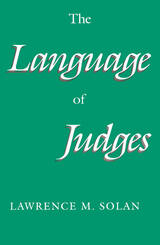 The Language of Judges
Lawrence M. Solan
University of Chicago Press, 1993 Since many legal disputes are battles over the meaning of a statute, contract, testimony, or the Constitution, judges must interpret language in order to decide why one proposed meaning overrides another. And in making their decisions about meaning appear authoritative and fair, judges often write about the nature of linguistic interpretation. In the first book to examine the linguistic analysis of law, Lawrence M. Solan shows that judges sometimes inaccurately portray the way we use language, creating inconsistencies in their decisions and threatening the fairness of the judicial system.
Solan uses a wealth of examples to illustrate the way linguistics enters the process of judicial decision making: a death penalty case that the Supreme Court decided by analyzing the use of adjectives in a jury instruction; criminal cases whose outcomes depend on the Supreme Court's analysis of the relationship between adverbs and prepositional phrases; and cases focused on the meaning of certain words in the Constitution. Solan finds that judges often describe our use of language poorly because there is no clear relationship between the principles of linguistics and the jurisprudential goals that the judge wishes to promote.
A major contribution to the growing interdisciplinary scholarship on law and its social and cultural context, Solan's lucid, engaging book is equally accessible to linguists, lawyers, philosophers, anthropologists, literary theorists, and political scientists.
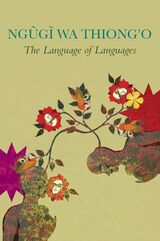 The Language of Languages
Ngugi wa Thiong’o
Seagull Books, 2023 With clear, conversational prose, this is the first book dedicated entirely to Ngũgĩ wa Thiong’o’s writings on translation.
Through his many critically acclaimed novels, stories, essays, plays, and memoirs, Kenyan writer Ngũgĩ wa Thiong’o has been at the forefront of world literature for decades. He has also been, in his own words, “a language warrior,” fighting for indigenous African languages to find their rightful place in the literary world. Having begun his writing career in English, Ngũgĩ shifted to writing in his native language Gikũyũ in 1977, a stance both creatively and politically significant. For decades now, Ngũgĩ has been translating his Gikũyũ works into English himself, and he has used many platforms to champion the practice and cause of literary translations, which he calls “the language of languages.”
This volume brings together for the first time Ngũgĩ’s essays and lectures about translation, written and delivered over the past two decades. Here we find Ngũgĩ discussing translation as a conversation between cultures; proposing that dialogue among African languages is the way to unify African peoples; reflecting on the complexities of auto-translation or translating one’s own work; exploring the essential task translation performed in the history of the propagation of thought; and pleading for the hierarchy of languages to be torn down. He also shares his many experiences of writing across languages, including his story The Upright Revolution, which has been translated into more than a hundred languages around the globe and is the most widely translated text written by an African author. At a time when dialogues between cultures and peoples are more essential than ever, The Language of Languages makes an outspoken case for the value of literature without borders.
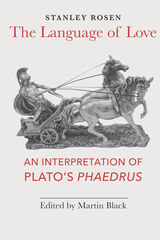 The Language of Love: An Interpretation of Plato's Phaedrus
Stanley Rosen
St. Augustine's Press, 2016 Stanley Rosen completed The Language of Love in the early 1970s, but the manuscript was put aside and only rediscovered in 2013, the year before his death. The Language of Love is an interpretation of the Phaedrus that was meant to follow and complete Rosen’s Symposium commentary. Only two articles have been previously published. Rosen’s frequent references to the central passages and second half of the Phaedrus were more important in pointing up the importance of his absent full interpretation of the dialogue.
Here Rosen’s argue for the possibility of philosophy or the retrieval of human self-knowledge on the basis of a renewed argument for the partial intelligibility of ordinary experience or, in other words, for the Platonic Ideas. His book on the Symposium was an important contribution to the subsequent sea change in Plato scholarship that returned attention to the dialogue form and to the poetic side of philosophy even in its quarrel with philosophy. That change allowed us search for understanding in the light of the whole, a whole which is otherwise, as Rosen has shown elsewhere, fragmented by the scientism of analytical philosophy or the historicism of “Continental” philosophy.
The Language of Love represents a missing key to Stanley Rosen’s work and, much more significantly, to the rediscovery of philosophy in our time. The title of the book is not merely a play on words. It points to the incommensurability between the constructed or historical nature of language or culture and the pre-discursive apprehension of things that is necessary if speech is to make sense and be understood, as opposed to being mere nonsense.
Among many valuable insights along the way, Rosen unites the dialogue in two parts, treating both eros and rhetoric, showing the linkage between eros and writing, as between myth and analysis. He connects the comic attempt to subject eros to diaeresis in the Phaedrus with the attempt to understand non-being as an eidos in the Sophist. In both cases, the inadequacy of a technical understanding of philosophy returns us to the pre-technical world of ordinary experience.
Rosen’s interpretation is an expression of the Socratic claim that we can’t speak beautifully without knowing the truth and that whatever truth we speak or write is a reflection of the silent invisibility of beauty as the unity of form. However, “Like every good teacher, it does not simply state that link for us to memorize. Instead, we must recollect it.”
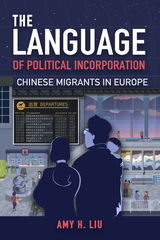 The Language of Political Incorporation: Chinese Migrants in Europe
Amy Liu
Temple University Press, 2021 In this groundbreaking study, The Language of Political Incorporation, Amy Liu focuses on Chinese migrants in Central-Eastern Europe and their varying levels of political incorporation in the local community. She examines the linguistic diversity of migrant networks, finding institutional trust and civic engagement depend not on national identity, but on the network’s linguistic diversity—namely, whether the operating language is a migrant’s mother tongue or a lingua franca. The Language of Political Incorporation uses original survey data to assess when the Chinese engage positively with the authorities and when they become civic minded. The results are surprising. In Hungary, the Chinese community has experienced high levels of political incorporation in part because they have not been targeted by anti-immigrant rhetoric and policies. In contrast, migrants in Romania sought the assistance of the Chinese embassy to fight an effort to collect back taxes. Liu also compares the Chinese experiences in Central-Eastern Europe with those of Muslims in the region, as well as how the Chinese are treated in Western Europe. Additionally, she considers how the local communities perceive the Chinese. The Language of Political Incorporation concludes by offering best practices for how governments can help migrants become more trusting of—and have greater involvement with—locals in their host countries. Ultimately, Liu demonstrates the importance of linguistic networks for the incorporation of immigrants.
The Language of Power, the Power of Language: The Effects of Ambiguity on Sociopolitical Structures as Illustrated in Shakespeare’s Plays
Stephen Cohen
Harvard University Press, 1987 In a fusion of historicist and deconstructive reading strategies, Stephen Cohen asserts the fundamental force of ambiguity on social and political structures in Othello, Macbeth, The Merchant of Venice, and Measure for Measure. He argues that there is an inherently “radical” ambiguity which cannot be controlled by countries or wits. Drawing from the works of a wide range of critics, including Jacques Derrida and Stephen Greenblatt, Cohen show how language itself erodes usurpers’ intentions to shape a world according to their own designs. His account of the transactions between author and reader provides a skeptical critique of readings that remove the loose ends that such “radical” ambiguities impart to the text.
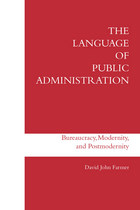 The Language of Public Administration: Bureaucracy, Modernity, and Postmodernity
David John Farmer
University of Alabama Press, 1995 Coping with the practical problems of bureaucracy is hampered by the limited self-conception and the constricted mindsets of mainstream public administration thinking. Modernist public administration theory, although valuable and capable of producing ever more remarkable results, is limiting as an explanatory and catalytic force in resolving fundamental problems about the nature, size, scope, and functioning of public bureaucracy and in transforming public bureaucracy into a more positive force. This original study specifies a reflexive language paradigm for public administration thinking and shows how a postmodern perspective permits a revolution in the character of thinking about public bureaucracy. The author considers imagination, deconstruction, deterritorialization, and alterity. Farmer's work emphasizes the need for an expansion in the character and scope of public administration's disciplinary concerns and shows clearly how the study and practice of public administration can be reinvigorated.
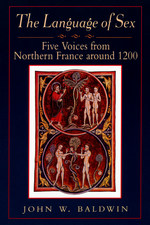 The Language of Sex: Five Voices from Northern France around 1200
John W. Baldwin
University of Chicago Press, 1994 This study brings together widely divergent discourses to fashion a comprehensive picture of sexual language and attitudes at a particular time and place in the medieval world.
John Baldwin introduces five representative voices from the turn of the twelfth century in northern France: Pierre the Chanter speaks for the theological doctrine of Augustine; the Prose Salernitan Questions, for the medical theories of Galen; Andre the Chaplain, for the Ovidian literature of the schools; Jean Renart, for the contemporary romances; and Jean Bodel, for the emerging voices of the fabliaux. Baldwin juxtaposes their views on a range of essential subjects, including social position, the sexual body, desire and act, and procreation. The result is a fascinating dialogue of how they agreed or disagreed with, ignored, imitated, or responded to each other at a critical moment in the development of European ideas about sexual desire, fulfillment, morality, and gender.
These spokesmen allow us into the discussion of sexuality inside the church and schools of the clergy, in high and popular culture of the leity. This heterogeneous discussion also offers a startling glimpse into the construction of gender specific to this moment, when men and women enjoyed equal status in sexual matters, if nowhere else.
Taken together, these voices extend their reach, encompass their subject, and point to a center where social reality lies. By articulating reality at its varied depths, this study takes its place alongside groundbreaking works by James Brundage, John Boswell, and Leah Otis in extending our understanding of sexuality and sexual behavior in the Middle Ages.
"Superb work. . . . These five kinds of discourse are not often treated together in scholarly writing, let alone compared and contrasted so well."—Edward Collins Vacek, Theological Studies
"[Baldwin] has made the five voices speak to us in a language that is at one and the same time familiar and alien in its resonance and accents. This is a truly exceptional book, interdisciplinary in the real sense of the word, which is surely destined to become a landmark in medieval studies."—Keith Busby, Bryn Mawr Reviews
"[Baldwin's] attempt to 'listen' to these distant voices and translate their language of sex into our own raises challenging methodological questions that will be of great interest to historians and literary scholars alike."—John P. Dalton, Comitatus
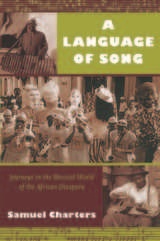 A Language of Song: Journeys in the Musical World of the African Diaspora
Samuel Charters
Duke University Press, 2009 In A Language of Song, Samuel Charters—one of the pioneering collectors of African American music—writes of a trip to West Africa where he found “a gathering of cultures and a continuing history that lay behind the flood of musical expression [he] encountered everywhere . . . from Brazil to Cuba, to Trinidad, to New Orleans, to the Bahamas, to dance halls of west Louisiana and the great churches of Harlem.” In this book, Charters takes readers along to those and other places, including Jamaica and the Georgia Sea Islands, as he recounts experiences from a half-century spent following, documenting, recording, and writing about the Africa-influenced music of the United States, Brazil, and the Caribbean. Each of the book’s fourteen chapters is a vivid rendering of a particular location that Charters visited. While music is always his focus, the book is filled with details about individuals, history, landscape, and culture. In first-person narratives, Charters relates voyages including a trip to the St. Louis home of the legendary ragtime composer Scott Joplin and the journey to West Africa, where he met a man who performed an hours-long song about the Europeans’ first colonial conquests in Gambia. Throughout the book, Charters traces the persistence of African musical culture despite slavery, as well as the influence of slaves’ songs on subsequent musical forms. In evocative prose, he relates a lifetime of travel and research, listening to brass bands in New Orleans; investigating the emergence of reggae, ska, and rock-steady music in Jamaica’s dancehalls; and exploring the history of Afro-Cuban music through the life of the jazz musician Bebo Valdés. A Language of Song is a unique expedition led by one of music’s most observant and well-traveled explorers.
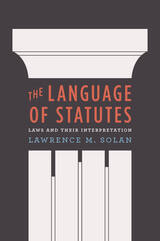 The Language of Statutes: Laws and Their Interpretation
Lawrence M. Solan
University of Chicago Press, 2010 Pulling the rug out from debates about interpretation, The Language of Statutes joins together learning from law, linguistics, and cognitive science to illuminate the fundamental issues and problems in this highly contested area. Here, Lawrence M. Solan argues that statutory interpretation is alive, well, and not in need of the major overhaul that many have suggested. Rather, he suggests, the majority of people understand their rights and obligations most of the time, with difficult cases occurring in circumstances that we can predict from understanding when our minds do not work in a lawlike way. Solan explains that these cases arise because of the gap between our inability to write crisp yet flexible laws on one hand and the ways in which our cognitive and linguistic faculties are structured on the other. Making our lives easier and more efficient, we’re predisposed to absorb new situations into categories we have previously formed—but in the legislative and judicial realms this can present major difficulties. Solan provides an excellent introduction to statutory interpretation, rejecting the extreme arguments that judges have either too much or too little leeway, and explaining how and why a certain number of interpretive problems are simply inevitable.
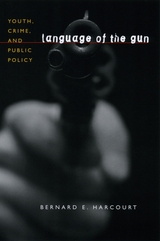 Language of the Gun: Youth, Crime, and Public Policy
Bernard E. Harcourt
University of Chicago Press, 2006 Legal and public policies concerning youth gun violence tend to rely heavily on crime reports, survey data, and statistical methods. Rarely is attention given to the young voices belonging to those who carry high-powered semiautomatic handguns. In Language of the Gun, Bernard E. Harcourt recounts in-depth interviews with youths detained at an all-malecorrectional facility, exploring how they talk about guns and what meanings they ascribe to them in a broader attempt to understand some of the assumptions implicit in current handgun policies. In the process, Harcourt redraws the relationships among empirical research, law, and public policy.
Home to over 150 repeat offenders ranging in age from twelve to seventeen, the Catalina Mountain School is made up of a particular stratum of boys—those who have committed the most offenses but will still be released upon reaching adulthood. In an effort to understand the symbolic and emotional language of guns and gun carrying, Harcourt interviewed dozens of these incarcerated Catalina boys. What do these youths see in guns? What draws them to handguns? Why do some of them carry and others not? For Harcourt, their often surprising answers unveil many of the presuppositions that influence our laws and policies.
The Language of the In-Between: Travestis, Post-hegemony, and Writing in Contemporary Chile and Peru
Erika Almenara
University of Pittsburgh Press, 2022 Often, the process of modern state formation is founded on the marginalization of certain groups, and Latin America is no exception. In The Language of the In-Between, Erika Almenara contends that literary production replicates this same process. Looking at marginalized communities in Chile and Peru, particularly writers who are travesti, trans, cuir/queer, and Indigenous, the author shows how these writers stake a claim for the liminal space that is neither one thing nor the other. This allows a freedom to expose oppression and to critique a national identity based on erasure. By employing a language of nonnormative gender and sexuality to dispute the state projects of modernity and modernization, the voice of the poor and racialized travesti evolves from powerlessness to become an agent of social transformation.
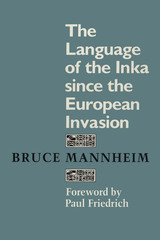 The Language of the Inka since the European Invasion
By Bruce Mannheim
University of Texas Press, 1991 The Inka empire, Tawantinsuyu, fell to Spanish invaders within a year's time (1532-1533), but Quechua, the language of the Inka, is still the primary or only language of millions of Inka descendants throughout the southern Andes. In this innovative study, Bruce Mannheim synthesizes all that is currently known about the history of Southern Peruvian Quechua since the Spanish invasion, providing new insights into the nature of language change in general, into the social and historical contexts of language change, and into the cultural conditioning of linguistic change. Mannheim first discusses changes in the social setting of language use in the Andes from the time of the first European contact in the sixteenth century until today. He reveals that the modern linguistic homogeneity of Spanish and Quechua is a product of the Spanish conquest, since multilingualism was the rule in the Inka empire. He identifies the social and political forces that have influenced the kinds of changes the language has undergone. And he provides the first synthetic history of Southern Peruvian Quechua, making it possible at last to place any literary document or written text in a chronological and social context. Mannheim also studies changes in the formal structure of Quechua. He finds that changes in the sound system were motivated primarily by phonological factors and also that the changes were constrained by a set of morphological and syntactic conditions. This last conclusion is surprising, since most historical linguists assume that sound change is completely independent of other aspects of language. Thus, The Language of the Inka since the European Invasion makes an empirical contribution to a general theory of linguistic change. Written in an engaging style that is accessible to the nonlinguist, this book will have a special appeal to readers interested in the history and anthropology of native South America.
The Language of Thought
Jerry A. Fodor
Harvard University Press In a compelling defense of the speculative approach to the philosophy of mind, Jerry Fodor argues that, while our best current theories of cognitive psychology view many higher processes as computational, computation itself presupposes an internal medium of representation. Fodor’s prime concerns are to buttress the notion of internal representation from a philosophical viewpoint, and to determine those characteristics of this conceptual construct using the empirical data available from linguistics and cognitive psychology.
 Language of Tomorrow: Towards a Transcultural Visual Communication System in a Posthuman Condition
Haytham Nawar
Intellect Books, 2020 Language of Tomorrow is a comprehensive guide to the history, evolution, and current forms of pictographic communication, charting its course from ancient Egyptian writing systems to modern-day emojis. The book is a culmination of research combining visual communication, semiotic theory, cultural studies, linguistics, artificial intelligence, and new media.
Haytham Nawar presents a cohesive and comprehensive historical framework—covering pictographic, logographic, and ideographic writing systems and scripts—through which we can discuss the future of communication. In his analysis, he explores the possibility of developing a standardized universal pictographic communication system that fosters mutual understanding and bridges diverse cultures. Weaving practice and theory across disciplines and bringing together language, culture, art, and design, Language of Tomorrow aims to locate the direction for the research and development of a transcultural visual communication system for the posthuman era.
 The Language of War: Literature and Culture in the U.S. from the Civil War through World War II
James Dawes
Harvard University Press, 2005 The Language of War examines the relationship between language and violence, focusing on American literature from the Civil War, World War I, and World War II. James Dawes proceeds by developing two primary questions: How does the strategic violence of war affect literary, legal, and philosophical representations? And, in turn, how do such representations affect the reception and initiation of violence itself? Authors and texts of central importance in this far-reaching study range from Louisa May Alcott and William James to William Faulkner, the Geneva Conventions, and contemporary American organizational sociology and language theory.
The consensus approach in literary studies over the past twenty years has been to treat language as an extension of violence. The idea that there might be an inverse relation between language and violence, says Dawes, has all too rarely influenced the dominant voices in literary studies today. This is an ambitious project that not only makes a serious contribution to American literary history, but also challenges some of the leading theoretical assumptions of our day.
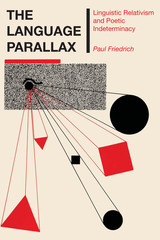 The Language Parallax: Linguistic Relativism and Poetic Indeterminacy
By Paul Friedrich
University of Texas Press, 1986 Humankind has always been fascinated and troubled by the way languages and dialects differ. Linguistically based differences in point of view have preoccupied many original minds of the past, such as Kant, and remain at the forefront of language study: in philosophy, anthropology, literary criticism, and other fields. Paul Friedrich's The Language Parallax argues persuasively that the "locus and focus" of differences among languages lies not so much in practical or rational aspects as in the complexity and richness of more poetic dimensions—in the nuances of words, or the style and voice of an author. This poetic reformulation of what has been called "linguistic relativism" is grounded in the author's theory of the imagination as a main source of poetic indeterminacy. The reformulation is also based on the intimate relation of the concentrated language of poetry to the potential or possibilities for poetry in ordinary conversation, dreams, and other experiences. The author presents challenging thoughts on the order and system of language in their dynamic relation to indeterminacy and, ultimately, disorder and chaos. Drawing on his considerable fieldwork in anthropology and linguistics, Friedrich interweaves distinct and provocative elements: the poetry of language difference, the indeterminacy in dialects and poetic forms, the discovery of underlying orders, the workings of different languages, the strength of his own poetry. The result is an innovative and organic whole. The Language Parallax, then, is a highly original work with a single bold thesis. It draws on research and writing that has involved, in particular, English, Russian, and the Tarascan language of Mexico, as well as the personal and literary study of the respective cultures. Anthropologist, linguist, and poet, Friedrich synthesizes from his experience in order to interrelate language variation and structure, the creative individual, ideas of system-in-process, and questions of scientific and aesthetic truth. The result is a new view of language held to the light of its potentially creative nature.
Language Play
David Crystal
University of Chicago Press, 2001 In this exhilarating and often hilarious book, David Crystal examines why we devote so much time and energy to language games, how professionals make a career of them, and how young children instinctively take to them. Crystal makes a simple argument-that since playing with language is so natural, a natural way to learn language is to play with it-while he discusses puns, crosswords, lipograms, comic alphabets, rhymes, funny voices taken from dialect and popular culture, limericks, anagrams, scat singing, and much more.
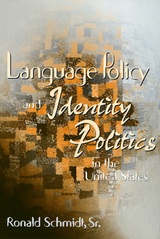 Language Policy & Identity In The U.S.
Ronald Schmidt, Sr.
Temple University Press, 2000 Well over thirty million people in the United States speak a primary language other than English. Nearly twenty million of them speak Spanish. And these numbers are growing. Critics of immigration and multiculturalism argue that recent government language policies such as bilingual education, non-English election materials, and social service and workplace "language rights" threaten the national character of the United States. Proponents of bilingualism, on the other hand, maintain that, far from being a threat, these language policies and programs provide an opportunity to right old wrongs and make the United States a more democratic society.
This book lays out the two approaches to language policy -- linguistic assimilation and linguistic pluralism -- in clear and accessible terms. Filled with examples and narratives, it provides a readable overview of the U.S. "culture wars" and explains why the conflict has just now emerged as a major issue in the United States.
Professor Schmidt examines bilingual education in the public schools, "linguistic access" rights to public services, and the designation of English as the United States' "official" language. He illuminates the conflict by describing the comparative, theoretical, and social contexts for the debate. The source of the disagreement, he maintains, is not a disagreement over language per se but over identity and the consequences of identity for individuals, ethnic groups, and the country as a whole. Who are "the American people"? Are we one national group into which newcomers must assimilate? Or are we composed of many cultural communities, each of which is a unique but integral part of the national fabric? This fundamental point is what underlies the specific disputes over language policy. This way of looking at identity politics, as Professor Schmidt shows, calls into question the dichotomy between "material interest" politics and "symbolic" politics in relation to group identities.
Not limited to describing the nature and context of the language debate, Language Policy and Identity Politics in the United States reaches the conclusion that a policy of linguistic pluralism, coupled with an immigrant settlement policy and egalitarian economic reforms, will best meet the aims of justice and the common good. Only by attacking both the symbolic and material effects of racialization will the United States be able to attain the goals of social equality and national harmony.
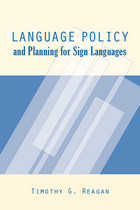 Language Policy and Planning for Sign Languages
Timothy G. Reagan
Gallaudet University Press, 2010 This volume addresses the burgeoning need for language policy and language planning for the sign languages used by deaf people. Author Timothy Reagan writes for two audiences in his new book, those who know language policy and language planning but not the Deaf World, and those well-versed in the Deaf cultural community but unfamiliar with language planning studies. To begin, Chapter 1 presents an overview of the Deaf World and a brief introduction to sign language in general. The second chapter outlines a broad overview of language policy and language planning studies both as an academic discipline and an applied type of social engineering. In Chapter 3, Reagan examines the specifics of American Sign Language in terms of the history of language policy and planning from the nineteenth century to the post-Congress of Milan period and its form in recent years. The fourth chapter critically examines the creation of manual codes used in deaf education in the U.S. and elsewhere. Chapter 5 analyzes language policy and planning in settings around the world, and the final chapter recommends steps and methods for future language policy and planning efforts for sign language. The cohesive rationale offered in Language Policy and Planning for Sign Languages will prove to be invaluable to all administrators and educators working with populations that use sign languages.
Language, Power, and Ideology in Brunei Darussalam: Mis Sea#99
Geoffrey C. Gunn
Ohio University Press, 1996 Contrary to modern theories of developing nations, Brunei Darussalam, which has a very high rate of literacy, is also one of the few countries where the traditional elite retains absolute political power. Professor Gunn's comprehensive study, which assesses the state's efforts to implement national language policies, explores the aspects of the complex relationship between language and power including the oral tradition, the rise of Islamic literacy, print culture and mass literacy, and the electronic media and its effects.
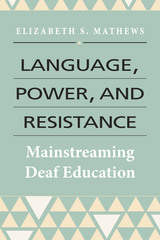 Language, Power, and Resistance: Mainstreaming Deaf Education
Elizabeth S. Mathews
Gallaudet University Press, 2017 The current policy of educating d/Deaf and h/Hard of hearing (DHH) students in a mainstream setting, rather than in the segregated environments of deaf schools, has been portrayed as a positive step forward in creating greater equality for DHH students. In Language, Power, and Resistance, Elizabeth S. Mathews explores this claim through qualitative research with DHH children in the Republic of Ireland, their families, their teachers, and their experiences of the education system. While sensitive to the historical context of deaf education, Mathews focuses on the contemporary education system and the ways in which the mainstreaming agenda fits into larger discussions about the classification, treatment, and normalization of DHH children.
The research upon which this book is based examined the implications that mainstreaming has for the tensions between the hegemonic medical model of deafness and the social model of Deafness. This volume explores how different types of power are used in the deaf education system to establish, maintain, and also resist medical views of deafness. Mathews frames this discussion as one of power relations across parents, children, and professionals working within the system. She looks at how various forms of power are used to influence decisions, to resist decisions, and to shape the structure and delivery of deaf education. The author’s findings are a significant contribution to the debates on inclusive education for DHH students and will resonate in myriad social and geographic contexts.
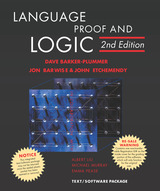 Language, Proof, and Logic: Second Edition
Dave Barker-Plummer, Jon Barwise, and John Etchemendy
CSLI, 2011 Language Proof and Logic is available as a physical book with the software included and as a downloadable package of software plus the book in PDF format. The all-electronic version is available from Openproof at gradegrinder.net.
The textbook/software package covers first-order language in a method appropriate for first and second courses in logic. An on-line grading services instantly grades solutions to hundred of computer exercises. It is designed to be used by philosophy instructors teaching a logic course to undergraduates in philosophy, computer science, mathematics, and linguistics.
Introductory material is presented in a systematic and accessible fashion. Advanced chapters include proofs of soundness and completeness for propositional and predicate logic, as well as an accessible sketch of Godel's first incompleteness theorem. The book is appropriate for a wide range of courses, from first logic courses for undergraduates (philosophy, mathematics, and computer science) to a first graduate logic course.
The software package includes four programs:
Tarski's World, a new version of the popular program that teaches the basic first-order language and its semantics;
Fitch, a natural deduction proof environment for giving and checking first-order proofs;
Boole, a program that facilitates the construction and checking of truth tables and related notions (tautology, tautological consequence, etc.);
Submit, a program that allows students to submit exercises done with the above programs to the Grade Grinder, the automatic grading service.
Grade reports are returned to the student and, if requested, to the student's instructor, eliminating the need for tedious checking of homework. All programs are available for Windows and Macintosh systems. Instructors do not need to use the programs themselves in order to be able to take advantage of their pedagogical value. More about the software can be found at gradegrinder.net.
The price of a new text/software package includes one Registration ID, which must be used each time work is submitted to the grading service. Once activated, the Registration ID is not transferable.
 Language, Religion, Knowledge: Past and Present
James Turner
University of Notre Dame Press, 2003 Higher education and university-based research rank among the main forces shaping our world. Focusing on knowledge rather than institutions, Language, Religion, Knowledge offers penetrating insight into how higher learning took its present form and the direction in which it is headed. The first section of this remarkable collection probes the history of higher learning in the United States; the second analyzes problems in higher learning today.
Renowned historian James Turner uncovers surprising blind spots in our knowledge of how higher learning has evolved by focusing on four themes: the influence of philology, historicism, disciplinary specialization, and the retreat of religion from the academy. Turner offers an especially interesting discussion of the powerful, yet often unrecognized, impact of the study of texts and languages on knowledge.
These thought-provoking essays examine losses and gains for contemporary higher education resulting from the fading of religion. Turner counts fragmentation of knowledge and the “marooning of research on an island of secular modernity” as among the greatest losses. Yet, he also proposes ways for higher learning today to recover the benefits of religiously grounded thinking without compromising the advantages of secularity.
By demonstrating that religious intellectual traditions can and should reinvigorate the life of the mind, Language, Religion, Knowledge gives new insights into the past and future of higher education.
Language, Resistance and Revival: Republican Prisoners and the Irish Language in the North of Ireland
Feargal Mac Ionnrachtaigh
Pluto Press, 2013 Language, Resistance and Revival tells the untold story of the truly groundbreaking linguistic and educational developments that took place among Republican prisoners in Long Kesh prison from 1972-2000.
During a period of bitter struggle between Republican prisoners and the British state, the Irish language was taught and spoken as a form of resistance during incarceration. The book unearths this story for the first time and analyses the rejuvenating impact it had on the cultural revival in the nationalist community beyond the prison walls.
Based on unprecedented interviews, Feargal Mac Ionnrachtaigh explores a key period in Irish history through the original and 'insider' accounts of key protagonists in the contemporary Irish language revival.
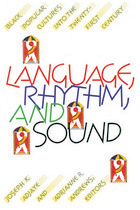 Language, Rhythm, and Sound: Black Popular Cultures into the Twenty-first Century
Joseph K. Adjaye
University of Pittsburgh Press, 1997
Focusing on expressions of popular culture among blacks in Africa, the United States, and the Carribean this collection of multidisciplinary essays takes on subjects long overdue for study. Fifteen essays cover a world of topics, from American girls’ Double Dutch games to protest discourse in Ghana; from Terry McMillan’s Waiting to Exhale to the work of Zora Neale Hurston; from South African workers to Just Another Girl on the IRT; from the history of Rasta to the evolving significance of kente clothl from rap video music to hip-hop to zouk.
The contributors work through the prisms of many disciplines, including anthropology, communications, English, ethnomusicology, history, linguistics, literature, philosophy, political economy, psychology, and social work. Their interpretive approaches place the many voices of popular black cultures into a global context. It affirms that black culture everywhere functions to give meaning to people’s lives by constructing identities that resist cultural, capitolist, colonial, and postcolonial domination.
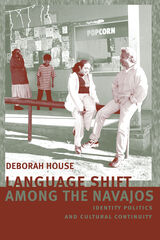 Language Shift among the Navajos: Identity Politics and Cultural Continuity
Deborah House
University of Arizona Press, 2002 To experience change on the Navajo Reservation, one need only close one's eyes and listen. Today an increasing number of Navajos speak only English, while very few speak only Navajo. The Navajo language continues to be taught, but it is less often practiced. Deborah House asks why, despite the many factors that would seem to contribute to the maintenance of the Navajo language, speakers of the language continue to shift to English at such an alarming rate—and what can be done about it.
Language Shift among the Navajos provides a close look at the ideological factors that intervene between the desire of the Navajos to maintain their language as an important aspect of their culture and their actual linguistic practice. Based on more than ten years of fieldwork within a Navajo institution and community, it points to ideologies held by Navajo people about their unequal relationship with the dominant American society as a primary factor in the erosion of traditional language use. House suggests that the Navajos employ their own paradigm—Sa’ah Naagháí Bik’eh Hózhóón—to learn both Western language and culture and their own without denigrating either perspective. By building on the traditional Navajo belief in harmony and balance, she advocates that those who value the language should use and teach it not just in school but also in the home, in the ceremonial hogans, and among those who cherish their heritage. Now is the time when language choices and behavior will influence whether the Navajo language lives or dies. House's book carries important lessons for anyone concerned with cultural continuity. It is a wake-up call for educators, youth, politicians, or family and community members who value Native language and culture. It remains to be seen in what language that call will be answered.
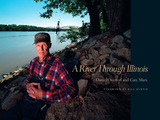 Language, Sign and Gender in Beowulf
Gillian R. Overing
Southern Illinois University Press, 1990
Not a book about what Beowulf means but how it means, and how the reader participates in the process of meaning construction.
Overing’s primary aim is to address the poem on its own terms, to trace and develop an interpretive strategy consonant with the extent of its difference. Beowulf’s arcane structure describes cyclical repetitions and patterned intersections of themes which baffle a linear perspective, and suggest instead the irresolution and dynamism of the deconstructionist free play of textual elements.
Chapter 1 posits the self/reader as a function of the text/language, examining the ways in which the text "speaks" the reader. Chapter 2 develops an interactive semiotic strategy in an attempt to describe an isomorphic relation between poem and reader, between text and self. Chapter 3 addresses the notions of text and self as more complex functions or formulations of desire, and thus complicates and expands the arguments of the two preceding chapters. The final chapter examines the issue of desire in the poem, and, to a lesser extent, desire in the reader (insofar as these may legitimately be viewed as distinct from each other).
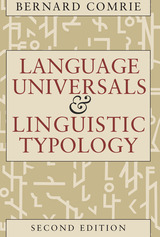 Language Universals and Linguistic Typology: Syntax and Morphology
Bernard Comrie
University of Chicago Press, 1989 Since its first publication, Language Universals and Linguistic Typology has become established as the leading introductory account of one of the most productive areas of linguistics—the analysis, comparison, and classification of the common features and forms of the organization of languages. Adopting an approach to the subject pioneered by Greenberg and others, Bernard Comrie is particularly concerned with syntactico-semantic universals, devoting chapters to word order, case making, relative clauses, and causative constructions. His book is informed throughout by the conviction that an exemplary account of universal properties of human language cannot restrict itself to purely formal aspects, nor focus on analysis of a single language. Rather, it must also consider language use, relate formal properties to testable claims about cognition and cognitive development, and treat data from a wide range of languages. This second edition has been revised and updated to take full account of new research in universals and typology in the past decade, and more generally to consider how the approach advocated here relates to recent advances in generative grammatical theory.
Language Use and Language Change in Brunei Darussalam: Mis Sea#100
Peter W. Martin
Ohio University Press, 1996 The oil-rich sultanate of Brunei Darussalam is located on the northern coast of Borneo between the two Malaysian states of Sarawak and Sabah. Though the country is small in size and in population, the variety of language use there provides a veritable laboratory for linguists in the fields of Austronesian linguistics, bilingual studies, and sociolinguistic studies, particularly those dealing with language shift. This useful reference is divided into three sections: one on varieties of the Malay language used in the country, one on other indigenous languages, and one on the role and form of the English used there. Contributors to the collection include Bruneian scholars as well as established experts in the fields of Austronesian linguistics, sociolinguistics studies, and the description of new varieties of English.
Language Variety in the South: Perspectives in Black and White
Michael B Montgomery
University of Alabama Press, 1986 This volume evolved from a research conference on the English Language in the Southern United States sponsored by the National Endowment for the Humanities and held at Columbia, South Carolina.
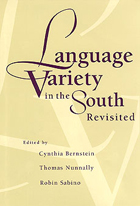 Language Variety in the South Revisited
Cynthia Bernstein
University of Alabama Press, 1994 Top linguists from diverse fields address language varieties in the South. Language Variety in the South Revisited is a comprehensive collection of new research on southern United States English by foremost scholars of regional language variation. Like its predecessor, Language Variety in the South: Perspectives in Black and White (The University of Alabama Press, 1986), this book includes current research into African American vernacular English, but it greatly expands the scope of investigation and offers an extensive assessment of the field. The volume encompasses studies of contact involving African and European languages; analysis of discourse, pragmatic, lexical, phonological, and syntactic features; and evaluations of methods of collecting and examining data. The 38 essays not only offer a wealth of information about southern language varieties but also serve as models for regional linguistic investigation.
 Language Wars: The Role of Media and Culture in Global Terror and Political Violence
Jeff Lewis
Pluto Press, 2005 Language Wars is a fascinating account of the relationship between the media, culture and new forms of global, political violence. Using an innovative approach, Jeff Lewis shows how language and the media are implicated in global terrorism and the US-led reprisals in the war on terror. Through an examination of the language of terrorism and war, Lewis illuminates key events in the current wave of political violence---the 9/11 attacks on New York and the Pentagon, the Beslan siege, the invasion of Afghanistan and Iraq, the Bali bombings and the ongoing occupation in the Middle East. He argues that the language used to report incidents of violence has changed, not just in official channels but in wider cultural contexts, and shows the impact this has on social perceptions. Lewis deconstructs these new discourses to reveal how Islam has been construed as the antagonist of freedom, democracy and the rule of law. Ideal for students of media studies and cultural studies, this is a subtle account of the relation between language and culture that exposes a dangerous new east-west divide in popular discourse.
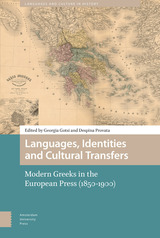 Languages, Identities and Cultural Transfers: Modern Greeks in the European Press (1850-1900)
Georgia Gotsi
Amsterdam University Press, 2021 What was the perception of Greece in Europe during the later nineteenth century, when the attraction of romantic philhellenism had waned? This volume focuses on the reception of medieval and modern Greece in the European press, rigorously analysing journals and newspapers published in England, France, Germany, Italy, and The Netherlands. The essays here suggest that reactions to the Greek state's progress and irredentist desires were followed among the European intelligentsia. Concurrently, new scholarship on the historical development of the Greek language and vernacular literature enhanced the image of medieval and modern Greece. This volume's contributors consider the press's role in this Europewide exchange of ideas, explore the links between romantic and late philhellenism and underscore the scholarly nature of the latter. Moreover, they highlight the human aspects of cultural transfers by focusing on networks of mediators, publishers and scholarly collaborators. This context enhances our understanding of both the creation of Hellenic studies and the complex formation of the modern Greek identity.
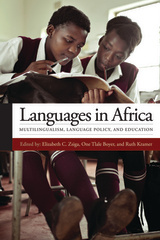 Languages in Africa: Multilingualism, Language Policy, and Education
Elizabeth C. Zsiga, One Tlale Boyer, and Ruth Kramer, Editors
Georgetown University Press, 2014 People in many African communities live within a series of concentric circles when it comes to language. In a small group, a speaker uses an often unwritten and endangered mother tongue that is rarely used in school. A national indigenous language—written, widespread, sometimes used in school—surrounds it. An international language like French or English, a vestige of colonialism, carries prestige, is used in higher education, and promises mobility—and yet it will not be well known by its users. The essays in Languages in Africa explore the layers of African multilingualism as they affect language policy and education. Through case studies ranging across the continent, the contributors consider multilingualism in the classroom as well as in domains ranging from music and film to politics and figurative language. The contributors report on the widespread devaluing and even death of indigenous languages. They also investigate how poor teacher training leads to language-related failures in education. At the same time, they demonstrate that education in a mother tongue can work, linguists can use their expertise to provoke changes in language policies, and linguistic creativity thrives in these multilingual communities.
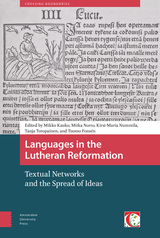 Languages in the Lutheran Reformation: Textual Networks and the Spread of Ideas
Mikko Kauko
Amsterdam University Press, 2019 This collection of essays charts the influence of the Lutheran Reformation on various (northern) European languages and texts written in them. The central themes of Languages in the Lutheran Reformation: Textual Networks and the Spread of Ideas are: how the ideas related to Lutheranism were adapted to the new areas, new languages, and new contexts during the Reformation period in the 16th and 17th centuries; and how the Reformation affected the standardization of the languages. Networks of texts, knowledge, and authors belong to the topics of the present volume. The contributions look into language use, language culture, and translation activities during the Reformation, but also in the prelude to the Reformation as well as after it, in the early modern period. The contributors are experts in the study of their respective languages, including Czech, Dutch, English, Estonian, Finnish, High German, Icelandic, Latvian, Lithuanian, Low German, Norwegian, Polish, and Swedish. The primary texts explored in the essays are Bible translations, but genres other than biblical are also discussed.
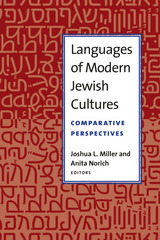 Languages of Modern Jewish Cultures: Comparative Perspectives
Edited by Joshua L. Miller and Anita Norich
University of Michigan Press, 2016 This collection of essays brings to Jewish Language Studies the conceptual frameworks that have become increasingly important to Jewish Studies more generally: transnationalism, multiculturalism, globalization, hybrid cultures, multilingualism, and interlingual contexts. Languages of Modern Jewish Cultures collects work from prominent scholars in the field, bringing world literary and linguistic perspectives to generate distinctively new historical, cultural, theoretical, and scientific approaches to this topic of ongoing interest. Chapters of this edited volume consider from multiple angles the cultural politics of myths, fantasies, and anxieties of linguistic multiplicity in the history, cultures, folkways, and politics of global Jewry. Methodological range is as important to this project as linguistic range. Thus, in addition to approaches that highlight influence, borrowings, or acculturation, the volume represents those that highlight syncretism, the material conditions of Jewish life, and comparatist perspectives.
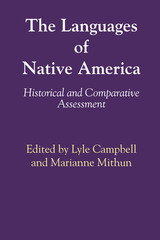 The Languages of Native America: Historical and Comparative Assessment
Edited by Lyle Campbell and Marianne Mithun
University of Texas Press, 1979 These essays were drawn from the papers presented at the Linguistic Society of America's Summer Institute at the State University of New York at Oswego in 1976. The contents are as follows: - Lyle Campbell and Marianne Mithun, "Introduction: North American Indian Historical Linguistics in Current Perspective"
- Ives Goddard, "Comparative Algonquian"
- Marianne Mithun, "Iroquoian"
- Wallace L. Chafe, "Caddoan"
- David S. Rood, "Siouan"
- Mary R. Haas, "Southeastern Languages"
- James M. Crawford, "Timucua and Yuchi: Two Language Isolates of the Southeast"
- Ives Goddard, "The Languages of South Texas and the Lower Rio Grande"
- Irvine Davis, "The Kiowa-Tanoan, Keresan, and Zuni Languages"
- Susan Steele, "Uto-Aztecan: An Assessment for Historical and
- Comparative Linguistics"
- William H. Jacobsen, Jr., "Hokan lnter-Branch Comparisons"
- Margaret Langdon, "Some Thoughts on Hokan with Particular Reference to Pomoan and Yuman"
- Michael Silverstein, ''Penutian: An Assessment"
- Laurence C. Thompson, "Salishan and the Northwest"
- William H. Jacobsen, Jr., "Wakashan Comparative Studies"
- William H. Jacobsen, Jr., "Chimakuan Comparative Studies"
- Michael E. Krauss, "Na-Dene and Eskimo-Aleut"
- Lyle CampbelI, "Middle American Languages"
- Eric S. Hamp, "A Glance from Now On."
 The Languages of Paradise: Race, Religion, and Philology in the Nineteenth Century
Maurice Olender
Harvard University Press, 2008 Michel Foucault observed that “the birth of philology attracted far less notice in the Western mind than did the birth of biology or political economy.” In this penetrating exploration of the origin of the discipline, Maurice Olender shows that philology left an indelible mark on Western visions of history and contributed directly to some of the most horrifying ideologies of the twentieth century.
The comparative study of languages was inspired by Renaissance debates over what language was spoken in the Garden of Eden. By the eighteenth century scholars were persuaded that European languages shared a common ancestor. With the adoption of positivist, “scientific” methods in the nineteenth century, the hunt for the language of Eden and the search for a European Ursprache diverged. Yet the desire to reconcile historical causality with divine purpose remained.
Because the Indo-European languages clearly had a separate line of descent from the biblical tongues, the practitioners of the new science of philology (many of whom had received their linguistic training from the Church) turned their scholarship to the task of justifying the ascendance of European Christianity to the principal role in Providential history. To accomplish this they invented a pair of concepts—Aryan and Semitic—that by the end of the century had embarked on ideological and political careers far outside philology. Supposed characteristics of the respective languages were assigned to the peoples who spoke them: thus the Semitic peoples (primarily the Jews) were, like their language, passive, static, and immobile, while the Aryans (principally Western Europeans) became the active, dynamic Chosen People of the future.
Olender traces the development of these concepts through the work of J. G. Herder, Ernest Renan, Friedrich Max Müller, Adolphe Pictet, Rudolph Grau, and Ignaz Goldziher. He shows that, despite their different approaches, each of these men struggled more or less purposefully “to join romanticism with positivism in an effort to preserve a common allegiance to the doctrines of Providence.”
With erudition and elegance, Olender restores the complexity and internal contradictions of their ideas and recreates the intellectual climate in which they flourished.
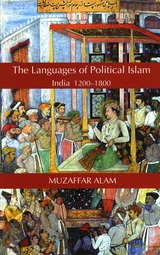 The Languages of Political Islam: India 1200-1800
Muzaffar Alam
University of Chicago Press, 2004 The Languages of Political Islam illuminates the diverse ways in which Islam, from the time of its arrival in India in the twelfth century through its height as the ruling theology to its decline, adapted to its new cultural context to become "Indianized."
Muzaffar Alam shows that the adoption of Arabo-Persian Islam in India changed the manner in which Islamic rule and governance were conducted. Islamic regulation and statecraft in a predominately Hindu country required strategic shifts from the original Islamic injunctions. Islamic principles could not regulate beliefs in a vast country without accepting cultural limitations and limits on the exercise of power. As a result of cultural adaptation, Islam was in the end forced to reinvent its principles for religious rule. Acculturation also forced key Islamic terms to change so fundamentally that Indian Islam could be said to have acquired a character substantially different from the Islam practiced outside of India.
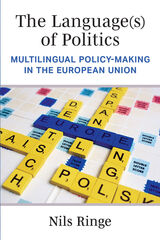 The Language(s) of Politics: Multilingual Policy-Making in the European Union
Nils Ringe
University of Michigan Press, 2022 Multilingualism is an ever-present feature in political contexts around the world, including multilingual states and international organizations. Increasingly, consequential political decisions are negotiated between politicians who do not share a common native language. Nils Ringe uses the European Union to investigate how politicians’ reliance on shared foreign languages and translation services affects politics and policy-making. Ringe's research illustrates how multilingualism is an inherent and consequential feature of EU politics—that it depoliticizes policy-making by reducing its political nature and potential for conflict. An atmosphere with both foreign language use and a reliance on translation leads to communication that is simple, utilitarian, neutralized, and involves commonly shared phrases and expressions. Policymakers tend to disregard politically charged language and they are constrained in their ability to use vague or ambiguous language to gloss over disagreements by the need for consistency across languages.
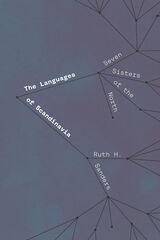 The Languages of Scandinavia: Seven Sisters of the North
Ruth H. Sanders
University of Chicago Press, 2017 From fjords to mountains, schools of herring to herds of reindeer, Scandinavia is rich in astonishing natural beauty. Less well known, however, is that it is also rich in languages. Home to seven languages, Scandinavia has traditionally been understood as linguistically bifurcated between its five Germanic languages (Danish, Norwegian, Swedish, Icelandic, and Faroese) and its two Finno-Ugric ones (Finnish and Sámi). In The Languages of Scandinavia, Ruth H. Sanders takes a pioneering approach: she considers these Seven Sisters of the North together.
While the two linguistic families that comprise Scandinavia’s languages ultimately have differing origins, the Seven Sisters have coexisted side by side for millennia. As Sanders reveals, a crisscrossing of names, territories, and even to some extent language genetics—intimate language contact—has created a body of shared culture, experience, and linguistic influences that is illuminated when the story of these seven languages is told as one. Exploring everything from the famed whalebone Lewis Chessmen of Norse origin to the interactions between the Black Death and the Norwegian language, The Languages of Scandinavia offers profound insight into languages with a cultural impact deep-rooted and far-reaching, from the Icelandic sagas to Swedish writer Stieg Larsson’s internationally popular Millennium trilogy. Sanders’s book is both an accessible work of linguistic scholarship and a fascinating intellectual history of language.
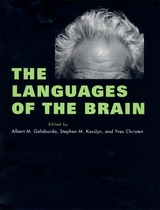 The Languages of the Brain
Albert M. Galaburda
Harvard University Press, 2002 The only way we can convey our thoughts in detail to another person is through verbal language. Does this imply that our thoughts ultimately rely on words? Is there only one way in which thoughts can occur? This ambitious book takes the contrary position, arguing that many possible "languages of thought" play different roles in the life of the mind.
"Language" is more than communication. It is also a means of representing information in both working and long-term memory. It provides a set of rules for combining and manipulating those representations.
A stellar lineup of international cognitive scientists, philosophers, and artists make the book's case that the brain is multilingual. Among topics discussed in the section on verbal languages are the learning of second languages, recovering language after brain damage, and sign language, and in the section on nonverbal languages, mental imagery, representations of motor activity, and the perception and representation of space.
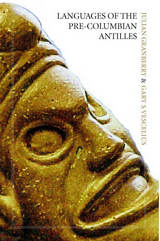 Languages of the Pre-Columbian Antilles
Julian Granberry and Gary Vescelius
University of Alabama Press, 2004 A linguistic analysis supporting a new model of the colonization of the Antilles before 1492 This work formulates a testable hypothesis of the origins and migration patterns of the aboriginal peoples of the Greater Antilles (Cuba, Jamaica, Hispaniola, and Puerto Rico), the Lucayan Islands (the Commonwealth of the Bahamas and the Crown Colony of the Turks and Caicos), the Virgin Islands, and the northernmost of the Leeward Islands, prior to European contact. Using archaeological data as corroboration, the authors synthesize evidence that has been available in scattered locales for more than 500 years but which has never before been correlated and critically examined. Within any well-defined geographical area (such as these islands), the linguistic expectation and norm is that people speaking the same or closely related language will intermarry, and, by participating in a common gene pool, will show similar socioeconomic and cultural traits, as well as common artifact preferences. From an archaeological perspective, the converse is deducible: artifact inventories of a well-defined sociogeographical area are likely to have been created by speakers of the same or closely related language or languages. Languages of the Pre-Columbian Antilles presents information based on these assumptions. The data is scant—scattered words and phrases in Spanish explorers' journals, local place names written on maps or in missionary records—but the collaboration of the authors, one a linguist and the other an archaeologist, has tied the linguistics to the ground wherever possible and allowed the construction of a framework with which to understand the relationships, movements, and settlement patterns of Caribbean peoples before Columbus arrived.
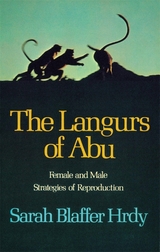 The Langurs of Abu: Female and Male Strategies of Reproduction
Sarah Blaffer Hrdy
Harvard University Press, 1977 “The Langurs of Abu will for many years remain one of the major studies of wild primates, both for its observational and theoretical content.” —Alison Jolly
Sexual combat is not a monopoly of the human species. As Sarah Blaffer Hrdy argues in this spellbinding book, war between male and female animals has deep roots in evolutionary history. Her account of family life among hanuman langurs—the black-faced, gray monkeys inhabiting much of the Indian subcontinent—is written with force, wit, and at times, sorrow.
Male hanumans, in pursuit of genetic success, routinely kill babies sired by their competitors. The mothers of endangered infants counter with various strategems to deceive the males and prevent destruction of their own offspring. Competition and selfishness are dominant themes of langur society. Competition among males for access to females, competition among females for access to food resources, and disregard by one female for the well-being of another’s infant—these are some very common examples. Yet there are also moments of heroic self-sacrifice, as when an elderly female rushes to defend her troop and its babies from an invading, infancticidal male.
The Langurs of Abu is the first book to analyze behavior of wild primates from the standpoint of both sexes. It is also a poignant and sophisticated exploration of primate behavior patterns from a feminist point of view. This book may inspire controversy; it will certainly be read with pleasure by anyone interested in animal behavior.
Richly illustrated with photographs, seven in full color.
Lantern Puzzle
Ye Chun
Tupelo Press, 2015 Entranced by time and location and the body’s longings, this is a book of self-translation. Each poem has gone through a transmigration process, as the poet negotiates between her native Chinese and her adopted English, attempting to condense, distill, and expand seeing and understanding.
The Lantern Room
Chloe Honum
Tupelo Press, 2021 “In The Lantern Room, her exquisite new collection, Chloe Honum moves, as her poems do, with range, precision, and astonishing beauty. Honum’s speaker travels across Arkansas motel to motel, missing a beloved, and in the book’s crown jewel, ‘The Common Room,’ chronicles an out-patient hospitalization in a psychiatric ward. The collection closes with sublime meditations on the speaker’s mother’s death: ‘How will I live without her?’ How, indeed. This book is that survival, and more than that, an extraordinary mind pressing through language to speak so deeply, so startlingly, the reader is made larger to receive its enormous gift: ‘But I have rain in my hair. This much is true. Let me bring it to you.’”
—Allison Benis Whit
Lao She and the Chinese Revolution
Ranbir Vohra
Harvard University Press, 1974 By exhaustively analyzing Lao She's literary writings, Vohra traces the development of his political consciousness and convictions. Answers are sought for crucial questions: Why did Lao She drift to a leftist position? Why did he return voluntarily to China? Why did he become disenchanted with the authoritarian regime? And why did he commit suicide?
Besides being an introduction to the life and works of Lao She, this book contributes to a greater understanding of the nature of the social and political change in twentieth-century China.
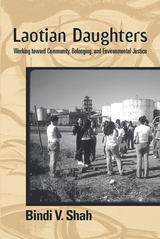 Laotian Daughters: Working toward Community, Belonging, and Environmental Justice
Bindi V. Shah
Temple University Press, 2011 Laotian Daughters focuses on second-generation environmental justice activists in Richmond, California. Bindi Shah's pathbreaking book charts these young women's efforts to improve the degraded conditions in their community and explores the ways their activism and political practices resist the negative stereotypes of race, class, and gender associated with their ethnic group. Using ethnographic observations, interviews, focus groups, and archival data on their participation in Asian Youth Advocates—a youth leadership development project—Shah analyzes the teenagers' mobilization for social rights, cross-race relations, and negotiations of gender and inter-generational relations. She also addresses issues of ethnic youth, and immigration and citizenship and how these shape national identities. Shah ultimately finds that citizenship as a social practice is not just an adult experience, and that ethnicity is an ongoing force in the political and social identities of second-generation Laotians.
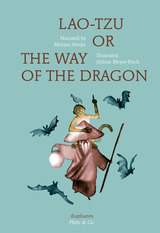 Lao-Tzu, or the Way of The Dragon
Miriam Henke
Diaphanes, 2018 At its most basic, philosophy is about learning how to think about the world around us. It should come as no surprise, then, that children make excellent philosophers! Naturally inquisitive, pint-size scholars need little prompting before being willing to consider life’s big questions, however strange or impractical. Plato & Co. introduces children—and curious grown-ups—to the lives and work of famous philosophers, from Socrates to Descartes, Einstein, Marx, Freud, and Wittgenstein. Each book in the series features an engaging—and often funny—story that presents basic tenets of philosophical thought alongside vibrant color illustrations.
In Lao-Tzu, or the Way of The Dragon, we follow the ancient Chinese philosopher who founded Taoism, from the comet that announced his birth up to his inspired composition, more than fifty years later, of the Tao Te Ching, the Book of the Way. In body and mind an old sage from birth, Lao-Tzu devotes his life to deciphering the endless book of the world. But he soon becomes frustrated with the silliness of human order, impatient kings, and greedy people, and rides off on the back of a water buffalo in search of the Way. He encounters clouds that solidify under his feet, a cave guarded by a golden monkey, and the venerable Confucius himself, and ultimately finds the wisdom of the dragon already residing deep in his own heart.
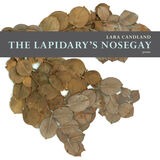 The Lapidary's Nosegay
Lara Candland
University Press of Colorado, 2018 The Lapidary’s Nosegay, Lara Candland’s primer of poems, presents to readers a bouquet of resplendent poems that Candland has created, collaged, curated, and reimagined by using the rich floral and gem imagery in the poetry of Emily Dickinson as her primary source material. Dickinson and Candland share linguistic and theological roots in the Bible, nineteenth-century American Protestantism, and a lexicon distinctive to their specific individuarian communities, and this collection of poems draws a serpentine kind of map across nearly two centuries, journeying from Amherst, Massachusetts, to Provo, Utah, from Dickinson’s severe and lush New England to Candland’s own jagged, harsh, and stunning high desert Utah. The Lapidary’s Nosegay explores the ways that both poets have simultaneously challenged and embraced the axiomatic constraints of religion, landscape, and cultural conventions and expectations of each poet’s time and place. Aesthetically, Candland attempts to challenge the hierarchies of the page through linguistic, typographic, and sonic experimentation. The Lapidary’s Nosegay carries Dickinsonian echoes to alliterative and parenthetic excessivities that indicate sound stresses or that pictographically invoke sun, god, ghosts, ecstasy, and the jewels and flowers tumbling throughout Dickinson’s own poems. This collection works at toppling textual hierarchies, systematically jumbling sound, text, meaning, symbol, and context and entering the vein of radical American aesthetics, politics, and culture that have shaped Candland’s life and poetics.
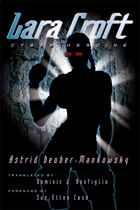 Lara Croft: Cyber Heroine
Astrid Deuber-Mankowsky
University of Minnesota Press, 2005 Since the game Tomb Raider was first released in 1996, its protagonist Lara Croft has become an international celebrity. The virtual archaeologist-adventuress has been featured in various sequels to the original game, a line of action figures, two Hollywood films starring Angelina Jolie, forty comic books, a series of novels, and a variety of clothing, merchandise, and ephemera. She has appeared on the covers of Time and Newsweek, spawned innumerable Internet fan sites and a library of adulatory fan fiction, become a pornographic sex symbol, and even inspired a look-alike beauty pageant. Astrid Deuber-Mankowsky's groundbreaking study examines Lara Croft as a cyber heroine - a female body ubiquitously inhabited by game players, an icon of both female strength and male objectification, and the virtual future of fame. Despite Croft's prominence there have been few critical inquiries into her bridging of the boundary between virtual and real worlds or the extent to which she reflects and influences the image of women in digital media. First published in German and revised for this English-language edition, this book is an innovative analysis of the multimedia heroine, tracing the top-down marketing strategies and bottom-up frenzy that precipitated the Lara Croft phenomenon. For girls and women, Croft is a symbol of empowerment, a tough and self-assured riot grrl who has opened up the overwhelmingly masculinized world of computer gaming to female participants. At the same time, she personifies both heterosexual male fantasies and the twinned processes of globalization and cultural imperialism. Drawing on feminist and cultural studies, Deuber-Mankowsky sees Croft as symptomatic of the new media environment and its tendency to erase all qualitative difference, even sexual difference.
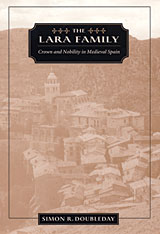 The Lara Family: Crown and Nobility in Medieval Spain
Simon R. Doubleday
Harvard University Press, 2001 For much of the Middle Ages, the Lara family was among the most powerful aristocratic lineages in Spain. Protégés of the monarchy at the time of El Cid, their influence reached extraordinary heights during the struggle against the Moors. Hand-in-glove with successive kings, they gathered an impressive array of military and political positions across the Iberian Peninsula. But cooperation gave way to confrontation, as the family was pitted against the crown in a series of civil wars.
This book, the first modern study of the Laras, explores the causes of change in the dynamics of power, and narrates the dramatic story of the events that overtook the family. The Laras' militant quest for territorial strength and the conflict with the monarchy led toward a fatal end, but anticipated a form of aristocratic power that long outlived the family. The noble elite would come to dominate Spanish society in the coming centuries, and the Lara family provides important lessons for students of the history of nobility, monarchy, and power in the medieval and early modern world.
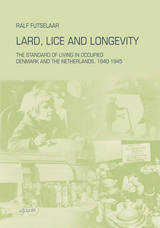 Lard, Lice and Longevity: The Standard of Living in Occupied Denmark and the Netherlands, 1940-1945
Ralf Futselaar
Amsterdam University Press, 2008 Lard, Lice and Longevity reconstructs economic policies implemented in Denmark and the Netherlands during the German occupation. It clearly shows that the experiences of both these countries during World War I, and during the 1930s equipped them to introduce extensive and intrusive economic controls to ward off a subsistence crisis.
In spite of the strong similarities between the two countries in terms of policies and economic order, there remains a glaring difference between the two. Throughout the occupation years, the Netherlands suffered a markedly higher level of child mortality than before or after the war, caused by an upsurge of infectious diseases. Child health in Denmark, on the other hand, declined during the occupation years, and infectious diseases rose only marginally there. In spite of similar policies, hence, the outcome in terms of the biological standard of living was dissimilar.
By closely investigating the impact of various policies on everyday life, and the amounts of goods available to different groups of consumers, this study identifies the causes of this remarkable divergence.
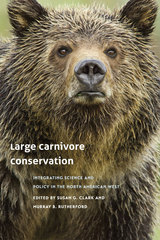 Large Carnivore Conservation: Integrating Science and Policy in the North American West
Edited by Susan G. Clark and Murray B. Rutherford
University of Chicago Press, 2014 Drawing on six case studies of wolf, grizzly bear, and mountain lion conservation in habitats stretching from the Yukon to Arizona, Large Carnivore Conservation argues that conserving and coexisting with large carnivores is as much a problem of people and governance—of reconciling diverse and sometimes conflicting values, perspectives, and organizations, and of effective decision making in the public sphere—as it is a problem of animal ecology and behavior. By adopting an integrative approach, editors Susan G. Clark and Murray B. Rutherford seek to examine and understand the interrelated development of conservation science, law, and policy, as well as how these forces play out in courts, other public institutions, and the field.
In combining real-world examples with discussions of conservation and policy theory, Large Carnivore Conservation not only explains how traditional management approaches have failed to meet the needs of all parties, but also highlights examples of innovative, successful strategies and provides practical recommendations for improving future conservation efforts.
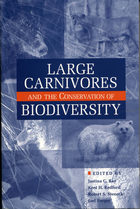 Large Carnivores and the Conservation of Biodiversity
Edited by Justina C. Ray, Kent H. Redford, Robert S. Steneck, and Joel Berger
Island Press, 2005 Large Carnivores and the Conservation of Biodiversity brings together more than thirty leading scientists and conservation practitioners to consider a key question in environmental conservation: Is the conservation of large carnivores in ecosystems that evolved with their presence equivalent to the conservation of biological diversity within those systems? Building their discussions from empirical, long-term data sets, contributors including James A. Estes, David S. Maehr, Tim McClanahan, Andrès J. Novaro, John Terborgh, and Rosie Woodroffe explore a variety of issues surrounding the link between predation and biodiversity: What is the evidence for or against the link? Is it stronger in marine systems? What are the implications for conservation strategies? Large Carnivores and the Conservation of Biodiversity is the first detailed, broad-scale examination of the empirical evidence regarding the role of large carnivores in biodiversity conservation in both marine and terrestrial ecosystems. It contributes to a much more precise and global understanding of when, where, and whether protecting and restoring top predators will directly contribute to the conservation of biodiversity. Everyone concerned with ecology, biodiversity, or large carnivores will find this volume a unique and thought-provoking analysis and synthesis.
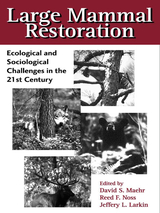 Large Mammal Restoration: Ecological And Sociological Challenges In The 21St Century
Edited by David S. Maehr, Reed F. Noss, and Jeffery L. Larkin; Foreword by Melvin E. Sunquist
Island Press, 2001 Evidence is mounting that top carnivores and other large mammals play a pivotal role in regulating ecosystem health and function, yet those are the species that are most likely to have been eliminated by past human activities. In recent decades, numerous efforts have been undertaken to return some of the species that were previously extirpated on local or regional scales. Large Mammal Restoration brings together for the first time detailed case studies of those efforts, from restoring elk in Appalachia to returning bison herds to the Great Plains to the much-publicized effort to bring back the gray wolf to Yellowstone National Park. Together these case studies offer important lessons and new ways of thinking for wildlife managers and conservation biologists involved with restoration programs. Sections examine: - approaches to determining the feasibility of a restoration program
- critical hands-on aspects of restoring large mammals
- obtaining public input into the process and gaining community support for programs
- the potential of some species to return without direct human intervention, and what can be done to facilitate that natural colonization
An introductory chapter by Reed F. Noss explores some of the reasons for restoring large mammals, as well as some of the ecological and social complications, and a concluding overview by David S. Maehr discusses the evolutionary importance of large mammal restoration. Contributors include Paul C. Paquet, Barbara Dugelby, Steven H. Fritts, Paul R. Krausman, Larry D. Harris, Johnna Roy, and many others. Large Mammal Restoration brings together in a single volume essential information on the lessons learned from previous efforts, providing an invaluable resource for researchers and students of conservation biology and wildlife management as well as for policymakers, restoration advocates, and others involved with the planning or execution of a restoration program.
Large Scale Grid Integration of Renewable Energy Sources
Antonio Moreno-Munoz
The Institution of Engineering and Technology, 2017 As renewable energy sources have reached grid parity in many countries, the key to further growth of the share of renewables in the power mix is their integration with the power system. This requires a number of technical developments, for example in power electronics, to meet the need for increased flexibility and rapid dispatch. This book explores the new approaches to meet these challenges, such as increasing interconnection capacity among geographical areas, hybridization of different distributed energy resources and building up demand response capabilities.
Large Scale Grid Integration of Renewable Energy Sources: Solutions and technologies
Antonio Moreno-Muñoz
The Institution of Engineering and Technology, 2024 Key to the further growth of shares of renewables is their integration with the existing grid system including EV and sector coupling. This in turn requires technical developments to enable flexibility and dispatch. Approaches to meeting these challenges include hybridization of different distributed energy resources, forecasting and control, storage and demand response, and modelling. Technological advances are also being accompanied by changes in business models.
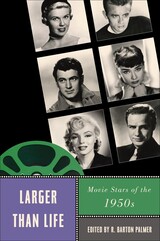 Larger Than Life: Movie Stars of the 1950s
Palmer, R. Barton
Rutgers University Press, 2010 The constellation of Hollywood stars burned brightly in the 1950s, even as the industry fell on hard economic times. Major artists of the 1940s--James Stewart, Jerry Lewis, and Gregory Peck--continued to exert a magical appeal but the younger generation of moviegoers was soon enthralled by an emerging cast, led by James Dean and Marlon Brando. They, among others, ushered in a provocative acting style, "the Method," bringing hard-edged, realistic performances to the screen. Adult-oriented small-budget dramas were ideal showcases for Method actors, startlingly realized when Brando seized the screen in On the Waterfront. But, with competition from television looming, Hollywood also featured film-making of epic proportion--Ben-Hur and other cinema wonders rode onto the screen with amazing spectacle, making stars of physically impressive performers such as Charlton Heston.
Larger Than Life offers a comprehensive view of the star system in 1950s Hollywood and also in-depth discussions of the decade's major stars, including Montgomery Clift, Judy Holliday, Jerry Lewis, James Mason, Marilyn Monroe, Kim Novak, Bing Crosby, Gene Kelly, Jayne Mansfield, and Audrey Hepburn.
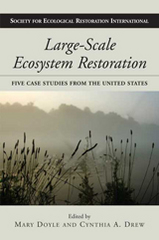 Large-Scale Ecosystem Restoration: Five Case Studies from the United States
Edited by Mary Doyle and Cynthia A. Drew
Island Press, 2008 Large-Scale Ecosystem Restoration presents case studies of five of the most noteworthy large-scale restoration projects in the United States: Chesapeake Bay, the Everglades, California Bay Delta, the Platte River Basin, and the Upper Mississippi River System. These projects embody current efforts to address ecosystem restoration in an integrative and dynamic manner, at large spatial scale, involving whole (or even multiple) watersheds, and with complex stakeholder and public roles.
Representing a variety of geographic regions and project structures, the cases shed light on the central controversies that have marked each project, outlining
• the history of the project
• the environmental challenges that generated it
• the difficulties of approaching the project on an ecosystem-wide basis
• techniques for conflict resolution and consensus building
• the ongoing role of science in decision making
• the means of dealing with uncertainties
A concluding chapter offers a guide to assessing the progress of largescale restoration projects.
Large-Scale Ecosystem Restoration examines some of the most difficult and important issues involved in restoring and protecting natural systems. It is a landmark publication for scientists, policymakers, and anyone working to protect or restore landscapes or watersheds.
 Largesse
Jean Starobinski
University of Chicago Press, 1997 In 1990 the Department of Graphic Arts at the Louvre made their holdings available to guest curators for a program called Parti Pris, or "Taking Sides". In this program, major cultural figures outside of the discipline of art history organized exhibitions based on the department's collection. Within its first several years, this novel collaboration produced exhibitions curated by philosopher Jacques Derrida and filmmaker Peter Greenaway.
Jean Starobinski, noted literary critic and intellectual historian from the University of Geneva, was selected as the third curator in the program. In his exhibition and accompanying essay, Starobinski explores the theme of largesse in its broadest sense. Arguing that gift giving and receiving are fundamental human gestures, he examines graphic and textual representations from the offering of the apple to Eve to Salome's gift of the head of John the Baptist, from the giving of laws to the gift of death. Charity, the poetic gift, and the benefits of Fortune all play a role in Starobinski's extended meditation on the act of donation. Lavishly illustrated and
dazzling in its scope and imagination, Largesse is an exemplar of the rich intellectual work that can result from crossing disciplinary boundaries and considering history as a dense network of themes and allusions.
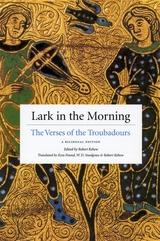 Lark in the Morning: The Verses of the Troubadours, a Bilingual Edition
Edited by Robert Kehew
University of Chicago Press, 2005 Although the troubadours flourished at the height of the Middle Ages in southern France, their songs of romantic love, with pleasing melodies and intricate stanzaic patterns, have inspired poets and song writers ever since, from Dante to Chaucer, from Renaissance sonneteers to the Romantics, and from Verlaine and Rimbaud to modern rock lyricists. Yet despite the incontrovertible influence of the troubadours on the development of both poetry and music in the West, there existed no comprehensive anthology of troubadour lyrics that respected the verse form of the originals until now.
Lark in the Morning honors the meter, word play, punning, and sound effects in the troubadours' works while celebrating the often playful, bawdy, and biting nature of the material. Here, Robert Kehew augments his own verse translations with those of two seminal twentieth-century poets—Ezra Pound and W. D. Snodgrass—to provide a collection that captures both the poetic pyrotechnics of the original verse and the astonishing variety of troubadour voices. This bilingual edition contains an introduction to the three major periods of the troubadours—their beginning, rise, and decline—as well as headnotes that briefly put each poet in context. Lark in the Morning will become an essential collection for those interested in learning about and teaching the origins of Western vernacular poetry.
Larks: Poems
Han VanderHart
Ohio University Press, 2025 The core of Larks is rural and mythic and true, existential and domestic, tender while full of sharp grief and documentation. Circling genealogies of silence and harm in a southern family, Larks centers on the relationship and memories of three sisters and Ovid’s telling of Philomel. In a landscape inhabited as much by farm animals (cows, goats, chickens, and barn kittens) as by the family, the lyric poem parses and articulates the self’s history—from the experience of a sister’s home birth to the traumatic erasure (and recovery) of the speaker’s memory. A work of poetic memoir, Larks asks if poetry can hold the heaviest truths we carry. The answer is a resounding yes.
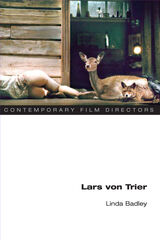 Lars von Trier
Linda Badley
University of Illinois Press, 2011 Scandinavia's foremost living auteur and the catalyst of the Dogme95 movement, Lars von Trier is arguably world cinema's most confrontational and polarizing figure. Willfully devastating audiences, he takes risks few filmmakers would conceive, mounting projects that somehow transcend the grand follies they narrowly miss becoming. Challenging conventional limitations and imposing his own rules, he restlessly reinvents the film language. The Danish director has therefore cultivated an insistently transnational cinema, taking inspiration from sources that range from the European avant-garde to American genre films. This volume provides a stimulating overview of Trier's career while focusing on the more recent work, including his controversial Gold Heart Trilogy (Breaking the Waves, The Idiots, and Dancer in the Dark), the as-yet unfinished USA Trilogy (Dogville and Manderlay), and individual projects such as the comedy The Boss of It All and the incendiary horror psychodrama Antichrist. Closely analyzing the films and their contexts, Linda Badley draws on a range of cultural references and critical approaches, including genre, gender, and cultural studies, performance theory, and trauma culture. Two revealing interviews that Trier granted during crucial stages of Antichrist's development are also included.
 Laryngeal Biomechanics
B. Raymond Fink and Robert J. Demarest
Harvard University Press, 1978 For its size, the larynx is the most complex and versatile mechanical device in the body. In this remarkable book, a distinguished medical illustrator and a world authority on laryngeal biomechanics collaborate to provide both an atlas and a treatise on the behavior of the larynx. In separate chapters, the authors consider the functions of the larynx—as safeguard for the free passage of air, to protect the airway from invasion, as a plug that resists expiration during effort, and as the instrument of speech and song. They replace the traditional view of the larynx as a sphincter with a more accurate model. The laryngeal tissues are seen as folding and unfolding in response to respiratory excursion of the trachea, action of intrinsic and extrinsic laryngeal muscles, the respiratory air current, and the elastic recoil of ligaments, membranes, and articular capsules.
The illustrations include unretouched xrays, halftone sketches, structural drawings, and diagrams; together they present as complete a picture as possible of the larynx in all its various functional states. Innovative and systematic, the work forms the basis for planning radical and reconstructive surgery, quantitative approaches in voice therapy, treatment of laryngospasm in anesthesia without use of relaxants, and design of an artificial larynx.
Las aventuras de Chupacabra Charlie
Frederick Luis Aldama / Ilustrado por Chris Escobar
Ohio State University Press, 2021 Chupacabra Charlie es un chupacabras de diez años educado, guapo e inusualmente alto que anhela la aventura más allá de los límites de México, pero no muy al norte. Poco sabe Charlie cuando se hace amigo de una joven humana, Lupe, que juntos, con solo algunas quesadillas de tocino y algunas latas de Jumex, encontrarán más aventuras de las que podrían manejar. En el camino, se encuentrarán con personas extrañas y peligros inesperados en la frontera entre Estados Unidos y México que ponen a prueba su valentía. ¿Podrán Charlie y Lupe regresar sanos y salvos a casa?
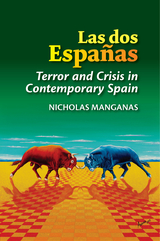 Las dos Españas: Terror and Crisis in Contemporary Spain
Nicholas Manganas
Sussex Academic Press, 2022 The idea of a divided Spain, where one half is antagonistic to the other half, dates back at least to the 19th-century Spanish satirist Mariano Jose de Larra who, in his essay "All Souls' Day 1836", wrote "Here lies half of Spain. It died of the other half". The narrative of las dos Espanas is evident across many political and historical debates operating in the Spanish state, and contemporarily it shadows and informs national issues from Catalan independence to the teaching of history in schools. But it is most polemical in debates concerning the issue of terror in all its manifestations. Las dos Espanas takes a multidisciplinary approach in understanding narratives of terror in contemporary Spain, in an attempt to contextualise terrorism socially and politically, as well as ideologically. Selective case studies of terror related events in the Spanish state will include the long-running Basque conflict, the state-sponsored death squad (GAL) scandal in the 1980s, the March 2004 terrorist attacks in Madrid, and other terror episodes. The author argues that these terror-related events can be re-read in terms of traces and links to long-standing historical narratives. However, since the onset of the global economic crisis in 2009, and its devastating effect on Spanish society, narratives of economic crisis have begun to supersede narratives of terror in the construction of the two Spains. The conclusion drawn is that the narrative of las dos Espanas still has the power to continue to divide Spain ideologically in political discourse. Terror and crisis narratives are intertwined with the narrative of las dos Espanas to provide a coherent argument that allows one to better understand the subversive nature of contemporary Spanish politics. Published in association with the Canada Blanch Centre for Contemporary Spanish Studies, LSE.
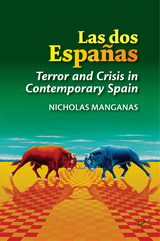 Las dos Españas: Terror and Crisis in Contemporary Spain
Nicholas Manganas
Sussex Academic Press, 2022 The idea of a divided Spain, where one half is antagonistic to the other half, dates back at least to the 19th-century Spanish satirist Mariano Jose de Larra who, in his essay "All Souls' Day 1836", wrote "Here lies half of Spain. It died of the other half". The narrative of las dos Espanas is evident across many political and historical debates operating in the Spanish state, and contemporarily it shadows and informs national issues from Catalan independence to the teaching of history in schools. But it is most polemical in debates concerning the issue of terror in all its manifestations. Las dos Espanas takes a multidisciplinary approach in understanding narratives of terror in contemporary Spain, in an attempt to contextualise terrorism socially and politically, as well as ideologically. Selective case studies of terror related events in the Spanish state will include the long-running Basque conflict, the state-sponsored death squad (GAL) scandal in the 1980s, the March 2004 terrorist attacks in Madrid, and other terror episodes. The author argues that these terror-related events can be re-read in terms of traces and links to long-standing historical narratives. However, since the onset of the global economic crisis in 2009, and its devastating effect on Spanish society, narratives of economic crisis have begun to supersede narratives of terror in the construction of the two Spains. The conclusion drawn is that the narrative of las dos Espanas still has the power to continue to divide Spain ideologically in political discourse. Terror and crisis narratives are intertwined with the narrative of las dos Espanas to provide a coherent argument that allows one to better understand the subversive nature of contemporary Spanish politics. Published in association with the Canada Blanch Centre for Contemporary Spanish Studies, LSE.
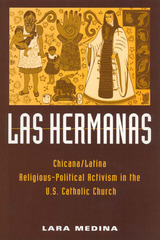 Las Hermanas: Chicana/Latina Religious-Political Activism in the U. S. Catholic Church
Lara Medina
Temple University Press, 2005 In this historical study, Lara Medina examines the early development and continuing influence of Las Hermanas, a feminist organization established in 1971 to counter the patriarchy and Eurocentrism of the U.S. Catholic Church.Lara Medina weaves archival research and oral interviews into a cohesive narrative that highlights the keen ethnic and political awareness among the movement's leaders and participants. Medina also illuminates the strides made by Las Hermanas in undermining and reorienting the male-dominated structure of both the Catholic ministry and the Chicano civil rights movement.By showing how the group has engaged such issues as moral authority, sexuality, and domestic abuse through its religiously informed efforts in grassroots community organizing and education, Lara Medina showcases the crucial role played by Las Hermanas in the articulation of a spiritually and politically grounded Latina/Chicana identity.
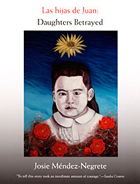 Las hijas de Juan: Daughters Betrayed
Josie Méndez-Negrete
Duke University Press, 2006 Las hijas de Juan shatters the silence surrounding experiences of incest within a working-class Mexican American family. Both a feminist memoir and a hopeful meditation on healing, it is Josie Méndez-Negrete’s story of how she and her siblings and mother survived years of violence and sexual abuse at the hands of her father. Méndez-Negrete was born in Mexico, in the state of Zacatecas. She recalls a joyous childhood growing up in the midst of Tabasco, a vibrant town filled with extended family. Her father, though, had dreams of acquiring wealth in el norte. He worked sun-up to sun-down in the fields of south Texas. Returning home to Mexico, his pockets full of dollars, he spent evenings drinking and womanizing. When Méndez-Negrete was eleven, her father moved the family to the United States, where they eventually settled in California’s Santa Clara Valley. There her father began molesting his daughters, viciously beating them and their mother. Within the impoverished immigrant family, the abuse continued for years, until a family friend brought it to the attention of child welfare authorities. Méndez-Negrete’s father was tried, convicted, and imprisoned. Las hijas de Juan is told chronologically, from the time Méndez-Negrete was a child until she was a young adult trying, along with the rest of her family, to come to terms with her father’s brutal legacy. It is a harrowing story of abuse and shame compounded by cultural and linguistic isolation and a system of patriarchy that devalues the experiences of women and girls. At the same time, Las hijas de Juan is an inspiring tale, filled with strong women and hard-won solace found in traditional Mexican cooking, songs, and storytelling.
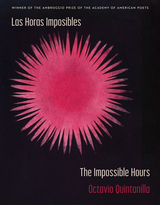 Las Horas Imposibles / The Impossible Hours
Octavio Quintanilla; Translated by Octavio Quintanilla and Natalia Treviño
University of Arizona Press, 2025 In Las Horas Imposibles / The Impossible Hours, Octavio Quintanilla takes us on a profound journey to witness what it means to erase those boundaries devised by genre and politics intent on stifling memory, imagination, and creativity.
Presented in Spanish with English translations, this poetry collection comprises lyric and concrete poems—or frontextos—that explore intimacy and different shades of violence as a means to reconcile the speaker’s sense of belonging in the world. From the opening poem to the last in the first section, Quintanilla captures the perilous journeys that migrants undertake crossing borders as well as the paths that lovers forge to meet their endless longing. These themes are skillfully woven by Quintanilla, guiding us back and forth across the Rio Grande to encounter the apparitions of the disappeared and to witness the willingness of many to risk life and limb for a better life. The second half of the collection is one long poem, a letter addressed to a lost lover who will never get to read the speaker’s secret thoughts. Haunted by loss—of parents, of children, of the self—the speaker reaches an inevitable epiphany: “[A]nd sometimes it’s hard to know / on which side of the river I stand.” Stylistically, these poems destabilize our notions and expectations of genre and lyricism.
Las Horas Imposibles / The Impossible Hours is more than just an exercise in poetic virtuosity; it is an excavation into the complexities of what it means to be a human being in our contemporary world.
Las hormigas de oro / Ants of Gold: Poemas / Poems
Eduardo Urios-Aparisi
Swan Isle Press, 2000 For Eduardo Urios-Aparisi poetry is above all, word, spoken word. Word that commits, pronounces, sounds. Word that leaves knots in the voice. For Urios, words play and challenge to play, to conceive the world from different and unsuspected points of view. The poems reflect the senses of the poet; moment to moment, in seduction, abandonment, and loss. It is reality flowing and always fleeing; fragmentary, accelerated, changing and unattainable.
 Las Raras: Feminine Style, Intellectual Networks, and Women Writers during Spanish-American Modernismo
Sarah Moody
Vanderbilt University Press, 2024 Premio al Mejor Libro, Latin American Studies Association–Nineteenth-Century Section, 2025
Las Raras proposes that the Modernistas’ advocacy for a writing style they considered feminine helps us to understand why so few (and perhaps no) women were accepted as active participants in Modernismo. Author Sarah Moody studies how particular writers contributed to the idea of a feminine aesthetic and tracks the intellectual networks of Modernismo through periodicals and personal papers, such as albums and correspondence. Buenos Aires, Paris, and Montevideo figure prominently in this transatlantic study, which reexamines some of the most important period writers in Spanish, including Rubén Darío, Amado Nervo, and Enrique Gómez Carrillo.
This book also considers the critiques launched by women writers, such as Aurora Cáceres, Clorinda Matto de Turner, and María Eugenia Vaz Ferreira, who experienced Modernista exclusion firsthand, deconstructed the Modernista discourse of a modern, “feminine” style, and built literary success in alternative terms. These writers reoriented the discussion about women in modernity to address women’s education, professionalization, and advocacy for social and civic improvements. In this study, Modernismo emerges as both a literary style and an intellectual network, in which style and sociability are mutually determining and combine to form a system of prestige and validation that excluded women writers.
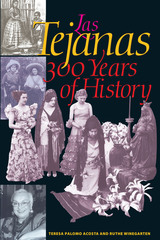 Las Tejanas: 300 Years of History
By Teresa Palomo Acosta and Ruthe Winegarten
University of Texas Press, 2003 Winner, Texas Reference Source Award, Reference Round Table, Texas Library Association, 2003
T.R. Fehrenbach Award, Texas Historical Commission, 2004 Since the early 1700s, women of Spanish/Mexican origin or descent have played a central, if often unacknowledged, role in Texas history. Tejanas have been community builders, political and religious leaders, founders of organizations, committed trade unionists, innovative educators, astute businesswomen, experienced professionals, and highly original artists. Giving their achievements the recognition they have long deserved, this groundbreaking book is at once a general history and a celebration of Tejanas' contributions to Texas over three centuries. The authors have gathered and distilled a wide range of information to create this important resource. They offer one of the first detailed accounts of Tejanas' lives in the colonial period and from the Republic of Texas up to 1900. Drawing on the fuller documentation that exists for the twentieth century, they also examine many aspects of the modern Tejana experience, including Tejanas' contributions to education, business and the professions, faith and community, politics, and the arts. A large selection of photographs, a historical timeline, and profiles of fifty notable Tejanas complete the volume and assure its usefulness for a broad general audience, as well as for educators and historians.
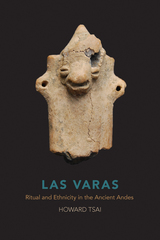 Las Varas: Ritual and Ethnicity in the Ancient Andes
Howard Tsai
University of Alabama Press, 2020 Archaeological data from Las Varas, Peru, that establish the importance of ritual in constructing ethnic boundaries
Recent popular discourse on nationalism and ethnicity assumes that humans by nature prefer “tribalism,” as if people cannot help but divide themselves along lines of social and ethnic difference. Research from anthropology, history, and archaeology, however, shows that individuals actively construct cultural and social ideologies to fabricate the stereotypes, myths, and beliefs that separate “us” from “them.” Archaeologist Howard Tsai and his team uncovered a thousand-year-old village in northern Peru where rituals were performed to recognize and reinforce ethnic identities.
This site—Las Varas—is located near the coast of Peru in a valley leading into the Andes. Excavations revealed a western entrance to Las Varas for those arriving from the coast and an eastern entryway for those coming from the highlands. Rituals were performed at both of these entrances, indicating that the community was open to exchange and interaction, yet at the same time controlled the flow of people and goods through ceremonial protocols. Using these checkpoints and associated rituals, the villagers of Las Varas were able to maintain ethnic differences between themselves and visitors from foreign lands.
Las Varas: Ritual and Ethnicity in the Ancient Andes reveals a rare case of finding ethnicity relying solely on archaeological remains. In this monograph, data from the excavation of Las Varas are analyzed within a theoretical framework based on current understandings of ethnicity. Tsai’s method, approach, and inference demonstrate the potential for archaeologists to discover how ethnic identities were constructed in the past, ultimately making us question the supposed naturalness of tribal divisions in human antiquity.
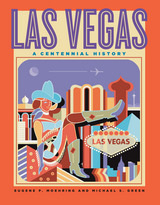 Las Vegas: A Centennial History
Eugene P. Moehring
University of Nevada Press, 2005 The meteoric rise of Las Vegas from a remote Mormon outpost to an international entertainment center was never a sure thing. In its first decades, the town languished, but when Nevada legalized casino gambling in 1931, Las Vegas met its destiny. This act—combined with the growing popularity of the automobile, cheap land and electricity, and changing national attitudes toward gambling—led to the fantastic casinos and opulent resorts that became the trademark industry of the city and created the ambiance that has made Las Vegas an icon of pleasure. This volume celebrates the city’s unparalleled growth, examining both the development of its gaming industry and the creation of an urban complex that over two million people proudly call home. Here are the colorful characters who shaped the city as well as the political, business, and civic decisions that influenced its growth. The story extends chronologically from the first Paiute people to the construction of the latest megaresorts, and geographically far beyond the original township to include the several municipalities that make up today’s vast metropolitan Las Vegas area.
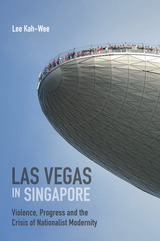 Las Vegas in Singapore: Violence, Progress and the Crisis of Nationalist Modernity
Lee Kah-Wee
National University of Singapore Press, 2018 Las Vegas in Singapore looks at the collision of the histories of Singapore and Las Vegas in the form of Marina Bay Sands, one of Singapore’s two integrated resorts.
The first history begins in colonial Singapore in the 1880s, when British administrators revised gambling laws in response to the political threat posed by Chinese-run gambling syndicates. Following the tracks of these punitive laws and practices, the book moves into the 1960s when the newly independent city-state created a national lottery while criminalizing both organized and petty gambling in the name of nation-building. The second history shifts the focus to corporate Las Vegas in the 1950s when digital technology and corporate management practices found each other on the casino floor. Tracing the emergence of the specialist casino designer, the book reveals how casino development evolved into a highly rationalized spatial template designed to maximize profits. Today an iconic landmark of Singapore, Marina Bay Sands is also an artifact of these two histories, an attempt by Singapore to normalize what was once criminalized in its nationalist history.
Lee Kah-Wee argues that the historical project of the control of vice is also about the control of space and capital. The result is an uneven landscape where the legal and moral status of gambling is contingent on where it is located. As the current wave of casino expansion spreads across Asia, he warns that these developments should not be seen as liberalization but instead as a continuation of the project of concentrating power by modern states and corporations.
Las Vegas: The Great American Playground
Robert D. Mccracken
University of Nevada Press, 1996 This expanded edition is the perfect book for the southern Nevada-bound traveler or the armchair adventurer. The very name of the city conjures a collection of images: fun, excitement, escape . . . or, more concretely, mega-sized hotels and casinos, spectacular showrooms, theme parks, and marquees as large as office buildings lit with the names of the biggest stars.
Las Vegas: The Great American Playground, illustrated with many fine historical photographs, traces the city’s history from its first Native American occupants more than 10,000 years ago to its present status as a premier tourist destination. It is the story of a group of colorful, enterprising individuals who made the desert bloom with undreamed-of possibilities.
Las yerbas de la gente: A Study of Hispano-American Medicinal Plants
Karen Cowan Ford
University of Michigan Press, 1975 Karen Cowan Ford provides a guide to five extensive collections of medicinal plants from the Southwest U.S. and Mexico that are housed at the Ethnobotanical Laboratory (now part of the Archaeobiology Laboratories) at the University of Michigan Museum of Anthropological Archaeology. Five appendices, which form the bulk of the book, include information on the Spanish and botanical names of the plants, where they were collected, and their historical use. Also included is a glossary of Spanish names of medicinal plants and a dictionary of botanical names.
The Last 10,000 Years: A Fossil Pollen Record of the American Southwest
Paul S. Martin
University of Arizona Press, 1964 Pollen analysis offers an approach to understanding the Southwestern environment, its history, and in some respects its possible future. Dr. Martin's study is an example of geochronology functioning as a strong interdisciplinary link among archaeologists, biogeographers, geologists, paleoclimatologists and ecologists.
 The Last Amateur: Jonathan Swift, Edward Said, and the Profession of Literature
Helen Deutsch
University of Chicago Press Joining the unfinished conversation between the satirist Jonathan Swift and the critic Edward Said, The Last Amateur argues for the transformative potential of literature.
What does “Swiftian” mean to you? For many, the name is synonymous with ingenious satire and an acid, clarifying mix of decorum and outrage. Jonathan Swift was, of course, the author not only of Gulliver’s Travels but also of A Modest Proposal, which the columnist Gene Lyons recently called “perhaps the most penetrating anti-racist essay in the English language.” Small wonder, then, that the Anglo-Irish satirist was a lifelong inspiration to the great Palestinian-American critic Edward Said, who for many years worked on an unfinished book about Swift and cultivated a Swiftian voice across his career.
Helen Deutsch’s highly personal book explores what Said’s love of Swift—and hers of both—tells us not only about these authors but the powers of criticism itself. The Last Amateur is about how one comes to love one writer through another. Deutsch scrutinizes Said in relationship to Swift to raise questions of her own about the profession of literary studies. At a time when many in the field have lost faith in critique, Deutsch shows how passion and a refusal of professional propriety—the hallmarks of the amateur—can enliven critique again.
What, then, does it mean to be a Swiftian? The Swiftian hears Swift’s animus and uses it as an incentive for their own freedom of thought. Said was a Swiftian because the experience of reading Swift freed him to speak out, to have something serious to say. Deutsch’s revelatory book is an exercise in hearing Swift’s voice and speaking in her own.
Last Animals at the Zoo: How Mass Extinction Can Be Stopped
Colin Tudge
Island Press, 1992 In Last Animals at the Zoo, Colin Tudge argues that zoos have become an essential part of modern conservation strategy, and that the only real hope for saving many endangered species is through creative use of zoos in combination with restoration of natural habitats. From the genetics of captive breeding to techniques of behavioral enrichment, Tudge examines all aspects of zoo conservation programs and explains how the precarious existence of so many animals can best be protected.
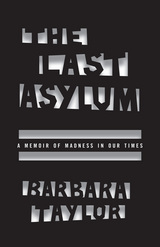 The Last Asylum: A Memoir of Madness in Our Times
Barbara Taylor
University of Chicago Press, 2015 In the late 1970s, Barbara Taylor, then an acclaimed young historian, began to suffer from severe anxiety. In the years that followed, Taylor’s world contracted around her illness. Eventually, her struggles were severe enough to lead to her admission to what had once been England’s largest psychiatric institution, the infamous Friern Mental Hospital in North London.
The Last Asylum is Taylor’s breathtakingly blunt and brave account of those years. In it, Taylor draws not only on her experience as a historian, but also, more importantly, on her own lived history at Friern— once known as the Colney Hatch Lunatic Asylum and today the site of a luxury apartment complex. Taylor was admitted to Friern in July 1988, not long before England’s asylum system began to undergo dramatic change: in a development that was mirrored in America, the 1990s saw the old asylums shuttered, their patients left to plot courses through a perpetually overcrowded and underfunded system of community care. But Taylor contends that the emptying of the asylums also marked a bigger loss, a loss of community. She credits her own recovery to the help of a steadfast psychoanalyst and a loyal circle of friends— from Magda, Taylor’s manic-depressive roommate, to Fiona, who shares tips for navigating the system and stories of her boyfriend, the “Spaceman,” and his regular journeys to Saturn. The forging of that network of support and trust was crucial to Taylor’s recovery, offering a respite from the “stranded, homeless feelings” she and others found in the outside world.
A vivid picture of mental health treatment at a moment of epochal change, The Last Asylum is also a moving meditation on Taylor’s own experience, as well as that of millions of others who struggle with mental illness.
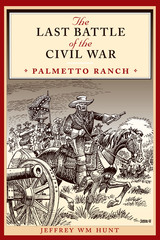 The Last Battle of the Civil War: Palmetto Ranch
By Jeffrey Wm Hunt
University of Texas Press, 2002 More than two months after Robert E. Lee surrendered the Army of Northern Virginia on April 9, 1865, the New York Times reported a most surprising piece of news. On May 12-13, the last battle of the Civil War had been fought at the southernmost tip of Texas—resulting in a Confederate victory. Although Palmetto Ranch did nothing to change the war's outcome, it added the final irony to a conflict replete with ironies, unexpected successes, and lost opportunities. For these reasons, it has become both one of the most forgotten and most mythologized battles of the Civil War. In this book, Jeffrey Hunt draws on previously unstudied letters and court martial records to offer a full and accurate account of the battle of Palmetto Ranch. As he recreates the events of the fighting that pitted the United States' 62nd Colored Troops and the 34th Indiana Veteran Volunteer Infantry against Texas cavalry and artillery battalions commanded by Colonel John S. "Rip" Ford, Hunt lays to rest many misconceptions about the battle. In particular, he reveals that the Texans were fully aware of events in the East—and still willing to fight for Southern independence. He also demonstrates that, far from fleeing the battle in a panic as some have asserted, the African American troops played a vital role in preventing the Union defeat from becoming a rout.
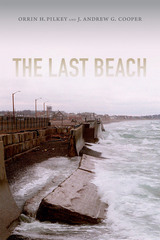 The Last Beach
Orrin H. Pilkey and J. Andrew G. Cooper
Duke University Press, 2014 The Last Beach is an urgent call to save the world's beaches while there is still time. The geologists Orrin H. Pilkey and J. Andrew G. Cooper sound the alarm in this frank assessment of our current relationship with beaches and their grim future if we do not change the way we understand and treat our irreplaceable shores. Combining case studies and anecdotes from around the world, they argue that many of the world's developed beaches, including some in Florida and in Spain, are virtually doomed and that we must act immediately to save imperiled beaches.
After explaining beaches as dynamic ecosystems, Pilkey and Cooper assess the harm done by dense oceanfront development accompanied by the construction of massive seawalls to protect new buildings from a shoreline that encroaches as sea levels rise. They discuss the toll taken by sand mining, trash that washes up on beaches, and pollution, which has contaminated not only the water but also, surprisingly, the sand. Acknowledging the challenge of reconciling our actions with our love of beaches, the geologists offer suggestions for reversing course, insisting that given the space, beaches can take care of themselves and provide us with multiple benefits.
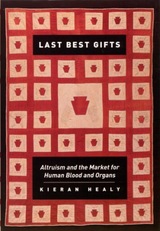 Last Best Gifts: Altruism and the Market for Human Blood and Organs
Kieran Healy
University of Chicago Press, 2006 More than any other altruistic gesture, blood and organ donation exemplifies the true spirit of self-sacrifice. Donors literally give of themselves for no reward so that the life of an individual—often anonymous—may be spared. But as the demand for blood and organs has grown, the value of a system that depends solely on gifts has been called into question, and the possibility has surfaced that donors might be supplemented or replaced by paid suppliers.
Last Best Gifts offers a fresh perspective on this ethical dilemma by examining the social organization of blood and organ donation in Europe and the United States. Gifts of blood and organs are not given everywhere in the same way or to the same extent—contrasts that allow Kieran Healy to uncover the pivotal role that institutions play in fashioning the contexts for donations. Procurement organizations, he shows, sustain altruism by providing opportunities to give and by producing public accounts of what giving means. In the end, Healy suggests, successful systems rest on the fairness of the exchange, rather than the purity of a donor’s altruism or the size of a financial incentive.
The Last Best Hope of Earth: Abraham Lincoln and the Promise of America
Mark E. Neely Jr.
Harvard University Press, 1993 Mark E. Neely, Jr., gives us the first compact biography of Abraham Lincoln based on new scholarship. Neely, a Pulitzer Prize–winning historian, vividly recaptures the central place of politics in Lincoln’s life. Richly illustrated, nuanced and accessible, written with attention to the age in which Lincoln lived, yet ever alert to universal moral questions, this book provides a portrait of Lincoln as an extraordinary man in his own time and ours.
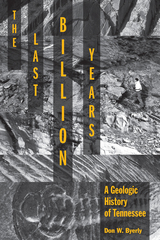 The Last Billion Years: A Geologic History of Tennessee
Don W. Byerly
University of Tennessee Press, 2013 Tennessee’s geologic history has evolved in myriad ways since its initial formation more than a billion years ago, settling into its current place on the North American supercontinent between 300 and 250 million years ago. Throughout that long span of “deep time,” Tennessee’s landscape morphed into its present form.
The Last Billion Years: A Geologic History of Tennessee is the first general overview in more than thirty years to interpret the state’s geological record. With minimal jargon, numerous illustrations and photographs, and a glossary of scientific terms, this volume provides the tools necessary for readers with little or no background in the subject to learn about the geologic formation of Tennessee, making it an excellent resource for high school students, college students, and interested general readers. Yet, because of the depth of its scholarship, the book is also an invaluable reference for professional geologists.
Recognizing that every reader is familiar with the roles of wind, water, gravity, and organisms in their everyday environment, author Don Byerly employs the Earth Systems Science approach, showing how the five interacting parts of the Earth—the geosphere, hydrosphere, atmosphere, biosphere, and cryosphere—have worked together for eons to generate the rock compositions that make up Tennessee’s geologic past.
All regions of the state are covered. Featuring a unique time chart that illustrates the state’s geologic history from east to west, The Last Billion Years shows that while the geologic aspects of the state’s three grand divisions are related in many ways, each division has a distinctly different background. The organization of the book further enhances its usability, allowing the reader to see and compare what was happening contemporaneously across the state during the key sequences of its geologic history. Written in a clear and engaging style, The Last Billion Years will have broad appeal to students, lay readers, and professionals.
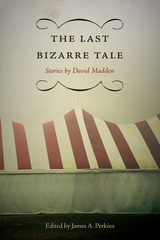 The Last Bizarre Tale: Stories by David Madden
David Madden
University of Tennessee Press, 2014 "Some writers have a talent for storytelling. Far fewer writers have a talent for literary innovation. Madden masterfully combines both talents."
—Winston Groom, author of Forrest Gump
"This collection of stories by the celebrated David Madden showcases a wide variety of themes, styles, and approaches. It is also as if the author dared himself to undertake as many novel forms as possible; to each of them he brings deft artistry, piercing observation, and an uncanny understanding of the inner lives of outsiders. A fine achievement!"
—Fred Chappell, author of Ancestors and Others: New and Selected Stories
Though he has authored more than eleven novels including, Cassandra Singing, The Suicide’s Wife, Abducted by Circumstance, and the recent London Bridge in Plague and Fire, David Madden has been publishing short stories for all six decades of his active career. The Last Bizarre Tale consists of works that appeared in journals but that have not appeared together as a collection.
Madden used two stories, “The Singer” and “Second Look Presents: the Rape of an Indian Brave,” as chapters in his 1980 novel On the Big Wind. “The Headless Girl’s Mother” was first published as a chapter in a serialized novel entitled Hair of the Dog. Two other stories developed out of longer versions of Madden’s novels. “A Demon in My View” is part of a sequel, not yet published, to Bijou.
All of the stories in David Madden’s third collection are distinguished by variety of content and by shifting styles and often innovative techniques. They are to varying degrees and in various ways bizarre in their characters and their relationships, in the kinds of internal and external conflicts, and in locales and themes. The title story, The Last Bizarre Tale, involving a corpse that has hung on a hook in a funeral home garage for decades, is evocative of Poe and, in its dark, grotesque humor, Flannery O’Connor and Carson McCullers. “Process is as important as product to David Madden,” writes editor James Perkins, “and one can learn as much about the process of writing as about the human condition by a careful reading of these stories.”
The author of eleven novels and two short story collections, David Madden is known for his innovative style and technique in crafting fiction. His work is praised by critics and fans alike as complex yet lyrical and always masterfully done. He lives in Black Mountain, North Carolina.
James A. Perkins is a professor of English Emeritus at Westminster College. He is the author of The Cass Mastern Material: The Core of Robert Penn Warren’s All the King’s Men. He is coeditor, with Jeffrey J. Folks, of Southern Writers at Century’s End and coauthor, with Randy J. Hendricks, of David Madden: A Writer for All Genres.
 The Last Blank Spaces: Exploring Africa and Australia
Dane Kennedy
Harvard University Press, 2013 For a British Empire that stretched across much of the globe at the start of the nineteenth century, the interiors of Africa and Australia remained intriguing mysteries. The challenge of opening these continents to imperial influence fell to a proto-professional coterie of determined explorers. They sought knowledge, adventure, and fame, but often experienced confusion, fear, and failure. The Last Blank Spaces follows the arc of these explorations, from idea to practice, from intention to outcome, from myth to reality.
Those who conducted the hundreds of expeditions that probed Africa and Australia in the nineteenth century adopted a mode of scientific investigation that had been developed by previous generations of seaborne explorers. They likened the two continents to oceans, empty spaces that could be made truly knowable only by mapping, measuring, observing, and preserving. They found, however, that their survival and success depended less on this system of universal knowledge than it did on the local knowledge possessed by native peoples.
While explorers sought to advance the interests of Britain and its emigrant communities, Dane Kennedy discovers a more complex outcome: expeditions that failed ignominiously, explorers whose loyalties proved ambivalent or divided, and, above all, local states and peoples who diverted expeditions to serve their own purposes. The collisions, and occasional convergences, between British and indigenous values, interests, and modes of knowing the world are brought to the fore in this fresh and engaging study.
Last Bonanza Kings: The Bourns of San Francisco
Ferol Egan
University of Nevada Press, 2009 Much of the wealth from the great mining bonanzas of the nineteenth century American West flowed into San Francisco and made possible the growth of the city and some fabulous personal fortunes. Among the wealthiest and most powerful of the Bonanza Kings were William Bowers Bourn I and his son and successor, William Bowers Bourn II. Their wealth came from rich mines in Nevada’s Comstock Lode and Treasure Hill and California’s Sierra foothills, as well as astute business ventures in the booming port city of San Francisco. Last Bonanza Kings tells their story with all the colorful detail and sweeping sense of epic drama that the characters and their times demand, setting them into the turbulent context of an age of rampant financial and civic growth, major technological advances in mining, lavish philanthropy, and opulent personal lifestyles.
The Last Cacique: Leadership and Politics in a Puerto Rican City
Jorge Heine
University of Pittsburgh Press, 1993 This pioneering study of the dynamics of city politics in one of Puerto Rico's largest townships examines the fascinating career to Benjamin Cole. A quasi-legendary figure in island politics, Cole served as mayor of Mayagüez from 1968 to 1992. His spectacular success often ran counter to the broader political trends in Puerto Rico and offers insights in the currents of change that swept the island from the 1960s through the 1990s.
Based on years of intensive research, including unusually candid interviews with members of Puerto Rico's political elite, The Last Cacique offers the first in-depth study of local politics in Puerto Rico and one of the very few available for the Caribbean region.
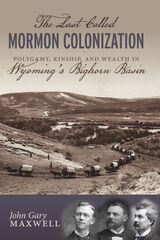 The Last Called Mormon Colonization: Polygamy, Kinship, and Wealth in Wyoming's Bighorn Basin
John Gary Maxwell
University of Utah Press, 2021 More than three hundred Latter-day Saint settlements were founded by LDS Church President Brigham Young. Colonization—often outside of Utah—continued under the next three LDS Church presidents, fueled by Utah’s overpopulation relative to its arable, productive land. In this book, John Gary Maxwell takes a detailed look at the Bighorn Basin colonization of 1900–1901, placing it in the political and socioeconomic climate of the time while examining whether the move to this out-of-the-way frontier was motivated in part by the desire to practice polygamy unnoticed.
The LDS Church officially abandoned polygamy in 1890, but evidence that the practice was still tolerated (if not officially sanctioned) by the church circulated widely, resulting in intense investigations by the U.S. Senate. In 1896 Abraham Owen Woodruff, a rising star in LDS leadership and an ardent believer in polygamy, was appointed to head the LDS Colonization Company. Maxwell explores whether under Woodruff’s leadership the Bighorn Basin colony was intended as a means to insure the secret survival of polygamy and if his untimely death in 1904, together with the excommunication of two equally dedicated proponents of polygamy—Apostles John Whitaker Taylor and Matthias Foss Cowley—led to its collapse.
Maxwell also details how Mormon settlers in Wyoming struggled with finance, irrigation, and farming and how they brought the same violence to indigenous peoples over land and other rights as did non-Mormons.
The 1900 Bighorn Basin colonization provides an early twentieth-century example of a Mormon syndicate operating at the intersection of religious conformity, polygamy, nepotism, kinship, corporate business ventures, wealth, and high priesthood status. Maxwell offers evidence that although in many ways the Bighorn Basin colonization failed, Owen Woodruff’s prophecy remains unbroken: “No year will ever pass, from now until the coming of the Savior, when children will not be born in plural marriage.”
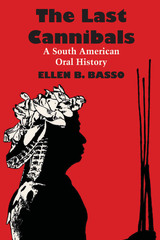 The Last Cannibals: A South American Oral History
By Ellen B. Basso
University of Texas Press, 1995 An especially comprehensive study of Brazilian Amazonian Indian history, The Last Cannibals is the first attempt to understand, through indigenous discourse, the emergence of Upper Xingú society. Drawing on oral documents recorded directly from the native language, Ellen Basso transcribes and analyzes nine traditional Kalapalo stories to offer important insights into Kalapalo historical knowledge and the performance of historical narratives within their nonliterate society. This engaging book challenges the familiar view of biography as a strictly Western literary form. Of special interest are biographies of powerful warriors whose actions led to the emergence of a more recent social order based on restrained behaviors from an earlier time when people were said to be fierce and violent. From these stories, Basso explores how the Kalapalo remember and understand their past and what specific linguistic, psychological, and ideological materials they employ to construct their historical consciousness. Her book will be important reading in anthropology, folklore, linguistics, and South American studies.
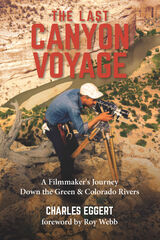 The Last Canyon Voyage: A Filmmaker's Journey Down the Green and Colorado Rivers
Charles Eggert Foreword by Roy Webb
University of Utah Press, 2020 In 1955 photographer Charles Eggert and renowned river guide Don Hatch set off down the Green River with six others to duplicate the 1870s journey of John Wesley Powell. With dams soon to be built at Flaming Gorge and Glen Canyon, they planned to film the voyage and be the last to travel these waters before the landscape changed forever. Eggert’s film A Canyon Voyage debuted successfully after the trip, but his written narrative of the river, its landscape, its people, and the adventures of the crew was never published.
This book finally brings Eggert’s writings out of
the archives and into the public eye. With his keen photographer’s vision and colloquial voice, Eggert describes canyons and towns now deep under water
as he tells the story of friendships forged upon the rapids and currents of the rivers. Roy Webb’s foreword provides historical context; river historian Alfred E. Holland Jr. introduces Eggert, the man who transformed into an environmentalist after visiting the West; and Sarah Holcombe’s afterword looks at what transpired
in the lives of all eight crew members after the journey. Color and black-and-white illustrations further enliven the text. An engaging read, this is an important piece of river history that also shines light on Eggert’s tremendous influence as a conservation cinematographer.
Last Cavalier: The Life and Times of John A. Lomax, 1867-1948
Nolan Porterfield
University of Illinois Press, 1996 Winner of the Carr P. Collins Award and a Miss Ima Hogg Historical Achievement Award, Last Cavalier is the never-before-told story of the remarkable life and career of John A. Lomax, pioneering American folklorist, canny businessman, influential educator, and patriarch of an extended family of artists, performers, and scholars.
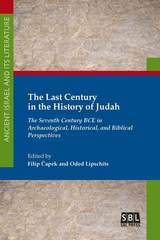 The Last Century in the History of Judah: The Seventh Century BCE in Archaeological, Historical, and Biblical Perspectives
Filip Čapek
SBL Press, 2019 An incomparable interdisciplinary study of the history of Judah
Experts from a variety of disciplines examine the history of Judah during the seventh century BCE, the last century of the kingdom’s existence. This important era is well defined historically and archaeologically beginning with the destruction layers left behind by Sennacherib’s Assyrian campaign (701 BCE) and ending with levels of destruction resulting from Nebuchadnezzar’s Babylonian campaign (588-586 BCE). Eleven essays develop the current ongoing discussion about Judah during this period and extend the debate to include further important insights in the fields of archaeology, history, cult, and the interpretation of Old Testament texts.
Features
- A new chronological frame for the Iron Age IIB-IIC
- Close examinations of archaeology, texts, and traditions related to the reigns of Hezekiah, Manasseh, and Josiah
- An evaluation of the religious, cultic, and political landscape
< /UL>
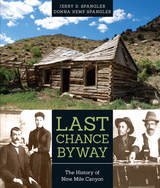 Last Chance Byway: The History of Nine Mile Canyon
Jerry D Spangler and Donna Kemp Spangler
University of Utah Press, 2015 Nine Mile Canyon is famous the world over for its prehistoric art images and remnants of ancient Fremont farmers. But it also teems with Old West history that is salted with iconic figures of the nineteenth and early twentieth centuries. Last Chance Byway lays out this newly told story of human endeavor and folly in a place historians have long ignored.
The history of Nine Mile Canyon is not so much a story of those who lived and died there as it is of those whose came with dreams and left broke and disillusioned, although there were exceptions. Sam Gilson, the irascible U.S. marshal and famed polygamist hunter, became wealthy speculating in a hydrocarbon substance bearing his name, Gilsonite, a form of asphalt. The famed African American Buffalo Soldiers constructed a freight road through the canyon that for a time turned the Nine Mile Road into one of the busiest highways in Utah. Others who left their mark include famed outlaw hunter Joe Bush, infamous bounty hunter Jack Watson, the larger-than-life cattle baron Preston Nutter, and Robert Leroy Parker (known to most as Butch Cassidy).
Winner of the Charles Redd Center Clarence Dixon Taylor Historical Research Award.
The Last Cheater's Waltz: Beauty and Violence in the Desert Southwest
Ellen Meloy
University of Arizona Press, 1999 In this abundant space and isolation, the energy lords extract their bounty of natural resources, and the curators of mass destruction once mined their egregious weapons and reckless acts. It is a land of absolutes, of passion and indifference, lush textures and inscrutable tensions. Here violence can push beauty to the edge of a razor blade. . . . Thus Ellen Meloy describes a corner of desert hard by the San Juan River in southeastern Utah, a place long forsaken as implausible and impassable, of little use or value—a place that she calls home. Despite twenty years of carefully nurtured intimacy with this red-rock landscape, Meloy finds herself, one sunbaked morning, staring down at a dead lizard floating in her coffee and feeling suddenly unmoored. What follows is a quest that is both physical and spiritual, a search for home.
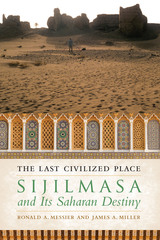 The Last Civilized Place: Sijilmasa and Its Saharan Destiny
By Ronald A. Messier and James A. Miller
University of Texas Press, 2015 Set along the Sahara’s edge, Sijilmasa was an African El Dorado, a legendary city of gold. But unlike El Dorado, Sijilmasa was a real city, the pivot in the gold trade between ancient Ghana and the Mediterranean world. Following its emergence as an independent city-state controlling a monopoly on gold during its first 250 years, Sijilmasa was incorporated into empire—Almoravid, Almohad, and onward—leading to the “last civilized place” becoming the cradle of today’s Moroccan dynasty, the Alaouites. Sijilmasa’s millennium of greatness ebbed with periods of war, renewal, and abandonment. Today, its ruins lie adjacent to and under the modern town of Rissani, bypassed by time. The Moroccan-American Project at Sijilmasa draws on archaeology, historical texts, field reconnaissance, oral tradition, and legend to weave the story of how this fabled city mastered its fate. The authors’ deep local knowledge and interpretation of the written and ecological record allow them to describe how people and place molded four distinct periods in the city’s history. Messier and Miller compare models of Islamic cities to what they found on the ground to understand how Sijilmasa functioned as a city. Continuities and discontinuities between Sijilmasa and the contemporary landscape sharpen questions regarding the nature of human life on the rim of the desert. What, they ask, allows places like Sijilmasa to rise to greatness? What causes them to fall away and disappear into the desert sands?
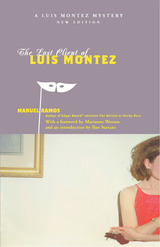 The Last Client of Luis Montez
Manuel Ramos
Northwestern University Press, 2004
Hard-luck attorney Luis Montez has hit the big-time at last. He's successfully defended Jimmy Esch, the good-for-nothing son of a powerful Denver family. No small bonus, Jimmy's attractive sister Lisa is, as the saying goes, appreciative. It's enough to make a man quit moping about a lost love.
What a difference a day makes. Inside of twenty-four hours, a cop rumored to have received bribes from Montez takes a header off a mountain, Jimmy Esch is found butchered, and the cops consider the attorney their top suspect. Lisa—Montez's alibi—has conveniently disappeared. As if all that wasn't enough, Montez must also cope with the news his father is in the hospital.
Distracted by family strife and a media circus, Montez broods on the latest wrong turns in his life. Then he decides to act. Jumping bail, he heads across the Rockies to the barrios of San Diego. It's not easy to unravel the perfect set-up when you're down to your last cent. But Montez pursues the truths that will clear his name, and ultimately confronts the powerful force that is Family.
 The Last Colonial Massacre: Latin America in the Cold War
Greg Grandin
University of Chicago Press, 2004 After decades of bloody revolutions and political terror, many scholars and politicians lament the rise and brief influence of the left in Latin America; since the triumph of Castro they have accused the left there of rejecting democracy, embracing Communist totalitarianism, and prompting both revolutionary violence and a right-wing backlash. The Last Colonial Massacre challenges these views.
Using Guatemala as a case study, Greg Grandin argues that the Cold War in Latin America was a struggle not between American liberalism and Soviet Communism but between two visions of democracy. The main effect of United States intervention in Latin America, Grandin shows, was not the containment of Communism but the elimination of home-grown concepts of social democracy.
Through unprecedented archival research and gripping personal testimonies, Grandin uncovers the hidden history of the Latin American Cold War: of hidebound reactionaries intent on holding on to their own power and privilege; of Mayan Marxists, blending indigenous notions of justice with universal ideas of freedom and equality; and of a United States supporting new styles of state terror throughout the continent. Drawing from declassified U.S. documents, Grandin exposes Washington's involvement in the 1966 secret execution of more than thirty Guatemalan leftists, which, he argues, prefigured the later wave of disappearances in Chile and Argentina.
Impassioned but judicious, The Last Colonial Massacre is history of the highest order—a work that will dramatically recast our understanding of Latin American politics and the triumphal role of the United States in the Cold War and beyond.
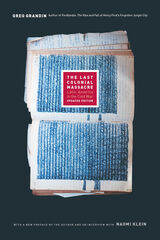 The Last Colonial Massacre: Latin America in the Cold War, Updated Edition
Greg Grandin
University of Chicago Press, 2011 After decades of bloodshed and political terror, many lament the rise of the left in Latin America. Since the triumph of Castro, politicians and historians have accused the left there of rejecting democracy, embracing communist totalitarianism, and prompting both revolutionary violence and a right-wing backlash. Through unprecedented archival research and gripping personal testimonies, Greg Grandin powerfully challenges these views in this classic work. In doing so, he uncovers the hidden history of the Latin American Cold War: of hidebound reactionaries holding on to their power and privilege; of Mayan Marxists blending indigenous notions of justice with universal ideas of equality; and of a United States supporting new styles of state terror throughout the region. With Guatemala as his case study, Grandin argues that the Latin American Cold War was a struggle not between political liberalism and Soviet communism but two visions of democracy—one vibrant and egalitarian, the other tepid and unequal—and that the conflict’s main effect was to eliminate homegrown notions of social democracy. Updated with a new preface by the author and an interview with Naomi Klein, The Last Colonial Massacre is history of the highest order—a work that will dramatically recast our understanding of Latin American politics and the role of the United States in the Cold War and beyond. “This work admirably explains the process in which hopes of democracy were brutally repressed in Guatemala and its people experienced a civil war lasting for half a century.”—International History Review “A richly detailed, humane, and passionately subversive portrait of inspiring reformers tragically redefined by the Cold War as enemies of the state.”—Journal of American History
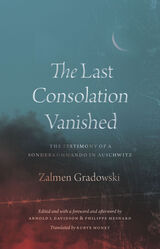 The Last Consolation Vanished: The Testimony of a Sonderkommando in Auschwitz
Zalmen Gradowski
University of Chicago Press, 2022 A unique and haunting first-person Holocaust account by Zalmen Gradowski, a Sonderkommando prisoner killed in Auschwitz.
On October 7, 1944, a group of Jewish prisoners in Auschwitz obtained explosives and rebelled against their Nazi murderers. It was a desperate uprising that was defeated by the end of the day. More than four hundred prisoners were killed. Filling a gap in history, The Last Consolation Vanished is the first complete English translation and critical edition of one prisoner’s powerful account of life and death in Auschwitz, written in Yiddish and buried in the ashes near Crematorium III.
Zalmen Gradowski was in the Sonderkommando (special squad) at Auschwitz, a Jewish prisoner given the unthinkable task of ushering Jewish deportees into the gas chambers, removing their bodies, salvaging any valuables, transporting their corpses to the crematoria, and destroying all evidence of their murders. Sonderkommandos were forcibly recruited by SS soldiers; when they discovered the horror of their assignment, some of them committed suicide or tried to induce the SS to kill them. Despite their impossible situation, many Sonderkommandos chose to resist in two interlaced ways: planning an uprising and testifying. Gradowski did both, by helping to lead a rebellion and by documenting his experiences. Within 120 scrawled notebook pages, his accounts describe the process of the Holocaust, the relentless brutality of the Nazi regime, the assassination of Czech Jews, the relationships among the community of men forced to assist in this nightmare, and the unbearable separation and death of entire families, including his own. Amid daily unimaginable atrocities, he somehow wrote pages that were literary, sometimes even lyrical—hidden where and when one would least expect to find them.
The October 7th rebellion was completely crushed and Gradowski was killed in the process, but his testimony lives on. His extraordinary and moving account, accompanied by a foreword and afterword by Philippe Mesnard and Arnold I. Davidson, is a voice speaking to us from the past on behalf of millions who were silenced. Their story must be shared.
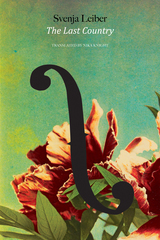 The Last Country
Svenja Leiber
Seagull Books, 2017 Now in paperback, the epic tale of a violinist who must navigate the fractious world of early twentieth-century Germany.
“Ruven Preuk stands apart from the village, on an August day in 1911, and listens.” Thus begins an epic bildungsroman about the life of Ruven Preuk, son of the wainwright, child of a sleepy village in Germany’s north, where life is both simple and harsh.
Ruven, though, is neither. He has the ability to see sounds, leading him to discover an uncanny gift for the violin. When he meets a talented teacher in the Jewish quarter, Ruven falls under the spell of a prodigious future. But as the twentieth century looms, Ruven’s pursuit of his craft takes a turn. In The Last Country, Svenja Leiber spins a tale that moves from the mansions of a disappearing aristocracy to a communist rebellion, from a joyous village wedding to a Nazi official’s threats, from the First World War to the Second. As the world Ruven knows disappears, the gifted musician must grapple with an important question: to what end has he devoted himself to his art?
Winner of the 2015 Arno Reinfrank Literaturpreis
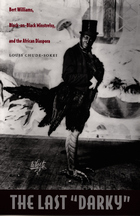 The Last "Darky": Bert Williams, Black-on-Black Minstrelsy, and the African Diaspora
Louis Chude-Sokei
Duke University Press, 2006 The Last “Darky” establishes Bert Williams, the comedian of the late nineteenth century and early twentieth, as central to the development of a global black modernism centered in Harlem’s Renaissance. Before integrating Broadway in 1910 via a controversial stint with the Ziegfeld Follies, Williams was already an international icon. Yet his name has faded into near obscurity, his extraordinary accomplishments forgotten largely because he performed in blackface. Louis Chude-Sokei contends that Williams’s blackface was not a display of internalized racism nor a submission to the expectations of the moment. It was an appropriation and exploration of the contradictory and potentially liberating power of racial stereotypes. Chude-Sokei makes the crucial argument that Williams’s minstrelsy negotiated the place of black immigrants in the cultural hotbed of New York City and was replicated throughout the African diaspora, from the Caribbean to Africa itself. Williams was born in the Bahamas. When performing the “darky,” he was actually masquerading as an African American. This black-on-black minstrelsy thus challenged emergent racial constructions equating “black” with African American and marginalizing the many diasporic blacks in New York. It also dramatized the practice of passing for African American common among non-American blacks in an African American–dominated Harlem. Exploring the thought of figures such as Booker T. Washington, W. E. B. Du Bois, Marcus Garvey, and Claude McKay, Chude-Sokei situates black-on-black minstrelsy at the center of burgeoning modernist discourses of assimilation, separatism, race militancy, carnival, and internationalism. While these discourses were engaged with the question of representing the “Negro” in the context of white racism, through black-on-black minstrelsy they were also deployed against the growing international influence of African American culture and politics in the twentieth century.
Last Day of My Face
James Shea
University of Iowa Press, 2025 James Shea’s collection deepens his exploration of the elegiac imagination, sending estranged speakers into new fields of quiet crisis. Orbiting a vast absence, Last Day of My Face reveals a kaleidoscopic perspective on impermanence: “Tomorrow / is a partial and promised gift.”
Rich with reversals, short poems are wedged against skittery contemplations, and an easeful tone coexists with a vein of darkness. Akin to lucid dreaming, this startling volume builds toward a final poem that gathers fragments of selves into a wondrous whole.
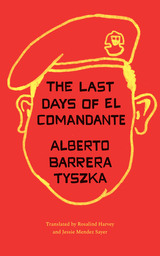 The Last Days of El Comandante
By Alberto Barrera Tyszka; translated by Rosalind Harvey and Jessie Mendez Sayer
University of Texas Press, 2020 2021 — Honorable Mention, Best Fiction Book Translation – International Latino Book Awards, Latino Literacy Now Winner of the Tusquets Prize in 2015 and previously translated into French, German, Dutch, Polish, and Portuguese, Alberto Barrera Tyszka’s Patria o muerte is now available in English. President Hugo Chávez’s cancer looms large over Venezuela in 2012, casting a shadow of uncertainty and creating an atmosphere of secrets, lies, and upheaval across the country. This literary thriller follows the connected lives of several Caracas neighbors consumed by the turmoil surrounding the Venezuelan president’s impending death. Retired oncologist Miguel Sanabria, seeing the increasingly combustible world around him, feels on constant edge. He finds himself at odds with his wife, an extreme anti-Chavista, and his radical Chavista brother. These feelings grow when his nephew asks him to undertake the perilous task of hiding cell-phone footage of Chávez in Cuba. Fredy Lecuna, an unemployed journalist, takes a job writing a book about Chávez’s condition, which requires him to leave for Cuba while his landlord attempts to kick his wife and son out of their apartment. Nine-year-old María, long confined to an apartment with a neurotic mother intensely fearful of the city’s violence, finds her only contact with the outside world through a boy she messages online.
The Last Days of Hitler
Hugh Trevor-Roper
University of Chicago Press, 1992 Late in 1945, Trevor-Roper was appointed by British Intelligence in Germany to investigate conflicting evidence surrounding Hitler's final days and to produce a definitive report on his death. The author, who had access to American counterintelligence files and to German prisoners, focuses on the last ten days of Hitler's life, April 20-29, 1945, in the underground bunker in Berlin—a bizarre and gripping episode punctuated by power play and competition among Hitler's potential successors.
"From exhaustive research [Trevor-Roper] has put together a carefully documented, irrefutable, and unforgettable reconstruction of the last days in April, 1945."—New Republic
"A book sound in its scholarship, brilliant in its presentation, a delight for historians and laymen alike."—A. J. P. Taylor, New Statesman
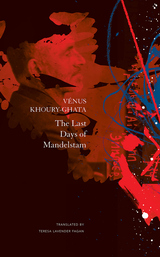 The Last Days of Mandelstam
Vénus Khoury-Ghata
Seagull Books, 2020 The year is 1938. The great Russian poet and essayist Osip Mandelstam is forty-seven years old and is dying in a transit camp near Vladivostok after having been arrested by Stalin’s government during the repression of the 1930s and sent into exile with his wife. Stalin, “the Kremlin mountaineer, murderer, and peasant-slayer,” is undoubtedly responsible for his fatal decline. From the depths of his prison cell, lost in a world full of ghosts, Mandelstam sees scenes from his life pass before him: constant hunger, living hand to mouth, relying on the assistance of sympathetic friends, shunned by others, four decades of creation and struggle, alongside his beloved wife Nadezhda, and his contemporaries Anna Akhmatova, Marina Tsvetaeva, Boris Pasternak, and many others.
With her sensitive prose and innate sense of drama, French-Lebanese writer Vénus Khoury-Ghata brings Mandelstam back to life and allows him to have the last word—proving that literature is one of the surest means to fight against barbarism.
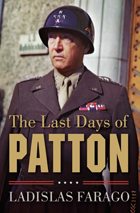 The Last Days of Patton
Ladislas Farago
Westholme Publishing, 2011 A Classic Account of America’s Greatest Field General at the End of World War II—and the Mystery Surrounding His Death
“It would be as hard to give up all thought [of being a soldier] as it would be to stop breathing,” wrote George S. Patton in October 1945; “The great tragedy of my life was that I survived the last battle.” But Patton would not see the year out: in December he would die as a result of injuries sustained in an automobile accident in Germany. His unexpected death sent shock waves through the American and Russian commands. It seemed plausible that America’s greatest general may have been a victim of foul play. In the seven months following the German surrender, Patton had openly and provocatively criticized the Soviet Union and appeared to have transformed from a staunch anti-Nazi to a Nazi sympathizer. The Last Days of Patton by Ladislas Farago, a follow-up to his bestselling Patton: Ordeal and Triumph, attempts to reconstruct the last months of Patton’s life in order to determine if the general did indeed try to provoke a war with the Soviet Union and whether he failed to sufficiently de-Nazify the area of Germany under his jurisdiction. Farago also investigates the possibility of a conspiracy to murder Patton and reveals the role other prominent men, including Eisenhower, Montgomery, Marshall, and MacArthur, had in censuring and ultimately removing Patton from active service. The Last Days of Patton, originally published in 1981, is the story of the general’s final battle—a professional soldier caught up in the changing politics of the emerging Cold War and new reality of the atomic age.
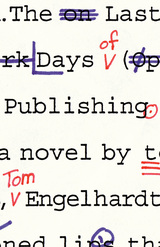 The Last Days of Publishing: A Novel
Thomas M. Engelhardt
University of Massachusetts Press, 2005
Pompeii never had it so bad. Rick Koppes knows a world is ending. The only question is, will he end with it? An editor at Byzantium Press for the last quarter century, he has watched his small, classy publishing house get gobbled up, first by an American publishing giant and then by Multimedia Entertainment, the Hollywood wing of Bruno Hindemann's German media empire. His editing colleagues are being downsized, his authors axed, and in a world where the cultural wallpaper is screaming, he himself hangs on by a fingernail—the latest work of his sole best-selling author, pop psychologist Walter Groth, is racing off bookstore shelves. And that's just where his problems begin—after all, Multimedia is about to make his ex-wife, a publishing executive at another house, his boss, his assistant wants his authors, and a woman who claims her father dropped the bomb on Nagasaki insists he publish her woeful memoir.
Koppes, who came of age in the sixties, is an editor slowly running off the rails. In the six episodes of The Last Days of Publishing, he refights the Vietnam War in a Chinese restaurant, discovers that the paleontological is political in a natural history museum, mixes it up with a flamboyant literary agent who went underground decades earlier, and encounters a hippie cultural oligarch on the forty-fifth floor of Multimedia's transnational entertainment headquarters.
Tom Engelhardt, himself a publishing veteran, has produced a tumultuous vision of the new world in which the word finds itself hustling for a living. By turns hilarious, sardonic, and poignant, his novel deftly captures the ways in which publishing, which has long put our world between covers but has seldom been memorialized in fiction, is being transformed.
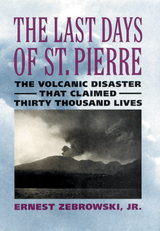 The Last Days of St. Pierre: The Volcanic Disaster That Claimed 30,000 Lives
Ernest Zebrowski, Jr.
Rutgers University Press, 2002 On May 8, 1902, Mont Pelée on the island of Martinique exploded. A deadly cloud of steam and ash churned through plantations and villages, flattened the grand city of St. Pierre, then thundered into the bay where it sank eighteen ships and hundreds of smaller craft. Within a minute or two, nearly 30,000 humans died. The splintered rubble of their homes and belongings burned for three days, and the world began to understand the awesome power of nuées ardentes, glowing avalanches of hot gas and debris that sweep down the slopes of volcanoes, instantly steaming to death anything in its path. The enormous death toll was particularly tragic because it was avoidable. Had it not been for an unfortunate combination of scientific misjudgment and political hubris, most of the victims would have escaped. In The Last Days of St. Pierre, Ernest Zebrowski Jr. counts down the days leading up to the catastrophe, and unfolds a tale intertwining human foolishness and heroism with the remarkable forces of nature. Illustrations contrast life in Martinique before and after the eruption, and eyewitness accounts bring the story to life.
Although it seems a long time since the destruction of St. Pierre, it is a mere blink of an eye in our planet’s geological history. Mont Pelée will erupt again, as will Vesuvius, Krakatau, St. Helens, Thera, and most other infamously fatal volcanoes, and human lives will again be threatened. The St. Pierre disaster has taught us much about the awesome power of volcanic forces and the devastation they can bring.
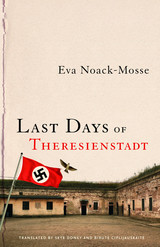 Last Days of Theresienstadt
Eva Noack-Mosse; Translated by Skye Doney and Biruté Ciplijauskaité
University of Wisconsin Press, 2018 In February of 1945, during the final months of the Third Reich, Eva Noack-Mosse was deported to the Nazi concentration camp of Theresienstadt. A trained journalist and expert typist, she was put to work in the Central Evidence office of the camp, compiling endless lists—inmates arriving, inmates deported, possessions confiscated from inmates, and all the obsessive details required by the SS. With access to camp records, she also recorded statistics and her own observations in a secret diary.
Noack-Mosse's aim in documenting the horrors of daily life within Theresienstadt was to ensure that such a catastrophe could never be repeated. She also gathered from surviving inmates information about earlier events within the walled fortress, witnessed the defeat and departure of the Nazis, saw the arrival of the International Red Cross and the Soviet Army takeover of the camp and town, assisted in administration of the camp's closure, and aided displaced persons in discovering the fates of their family and friends. After the war ended, and she returned home, Noack-Mosse cross-referenced her data with that of others to provide evidence of Nazi crimes. At least 35,000 people died at Theresienstadt and another 90,000 were sent on to death camps.
 The Last Deployment: How a Gay, Hammer-Swinging Twentysomething Survived a Year in Iraq
Bronson Lemer
University of Wisconsin Press, 2011 In 2003, after serving five and a half years as a carpenter in a North Dakota National Guard engineer unit, Bronson Lemer was ready to leave the military behind. But six months short of completing his commitment to the army, Lemer was deployed on a yearlong tour of duty to Iraq. Leaving college life behind in the Midwest, he yearns for a lost love and quietly dreams of a future as an openly gay man outside the military. He discovers that his father’s lifelong example of silent strength has taught him much about being a man, and these lessons help him survive in a war zone and to conceal his sexuality, as he is required to do by the U.S. military. The Last Deployment is a moving, provocative chronicle of one soldier’s struggle to reconcile military brotherhood with self-acceptance. Lemer captures the absurd nuances of a soldier’s daily life: growing a mustache to disguise his fear, wearing pantyhose to battle sand fleas, and exchanging barbs with Iraqis while driving through Baghdad. But most strikingly, he describes the poignant reality faced by gay servicemen and servicewomen, who must mask their identities while serving a country that disowns them. Often funny, sometimes anguished, The Last Deployment paints a deeply personal portrait of war in the twenty-first century.
InSight Out Book Club selection Bronson Lemer named one of Instinct magazine’s Leading Men 2011 QPB Book Club selection
Finalist, Minnesota Book Awards
Finalist, Over the Rainbow Selection, American Library Association
Amazon Top Ten 10 Gay & Lesbian Books of 2011
 The Last Dinosaur Book: The Life and Times of a Cultural Icon
W. J. T. Mitchell
University of Chicago Press, 1998 For animals that have been dead millions of years, dinosaurs are extraordinarily pervasive in our everyday lives. Appearing in ads, books, movies, museums, television, toy stores, and novels, they continually fascinate both adults and children. How did they move from natural extinction to pop culture resurrection? What is the source of their powerful appeal? Until now, no one has addressed this question in a comprehensive way. In this lively and engrossing exploration of the animal's place in our lives, W.J.T. Mitchell shows why we are so attached to the myth and the reality of the "terrible lizards."
Mitchell aims to trace the cultural family tree of the dinosaur, and what he discovers is a creature of striking flexibility, linked to dragons and mammoths, skyscrapers and steam engines, cowboys and Indians. In the vast territory between the cunning predators of Jurassic Park and the mawkishly sweet Barney, from political leviathans to corporate icons, from paleontology to Barnum and Bailey, Mitchell finds a cultural symbol whose plurality of meaning and often contradictory nature is emblematic of modern society itself. As a scientific entity, the dinosaur endured a near-eclipse for over a century, but as an image it is enjoying its widest circulation. And it endures, according to Mitchell, because it is uniquely malleable, a figure of both innovation and obsolescence, massive power and pathetic failure—the totem animal of modernity.
Drawing unforeseen and unusual connections at every turn between dinosaurs real and imagined, The Last Dinosaur Book is the first to delve so deeply, so insightfully, and so enjoyably into our modern dino-obsession.
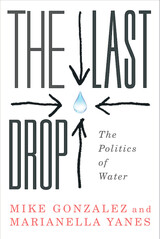 The Last Drop: The Politics of Water
Mike Gonzalez and Marianella Yanes
Pluto Press, 2015 The one indispensable resource, water is increasingly controlled and even owned by private capital. By 2012, water was a trillion-dollar industry—and as population growth, industrial production, and ecological change make scarcity ever-more common, water may well become the source of military and political conflict in the years to come.
This book looks at how we got here and what we can and should do next. Laying out the complex arguments surrounding water, its ownership and access to it, Mike Gonzalez and Marianella Yanes make the technical and scientific aspects of the discussion clear and accessible—and thereby enable themselves to make the political questions more urgent. Pushing back against the market fundamentalists, the authors argue that it is both possible and necessary that considerations of equity and social justice prevail in the debates about water. Powerful and polemical, The Last Drop will be a vital resource for water activists worldwide.
The Last Earth: A Palestinian Story
Ramzy Baroud
Pluto Press, 2018 Spanning decades and encompassing war, mass exodus, epic migrations and the search for individual and collective identity, The Last Earth tells the story of modern Palestine through the memories of those who have lived it.
Ordinary Palestinians have rarely narrated their own history. In this groundbreaking book, acclaimed author Ramzy Baroud draws on dozens of interviews to produce vivid, intimate and beautifully written accounts of Palestinian lives - in villages, refugee camps, prisons and cities, in the lands of their ancestors and in exile. Baroud's empathetic and lyrical approach reveals new human dimensions of the Palestinian saga, telling it as it has never before been told.
Against dominant narratives, the last earth reclaims Palestine's past - and present - for all its people.
|
|
